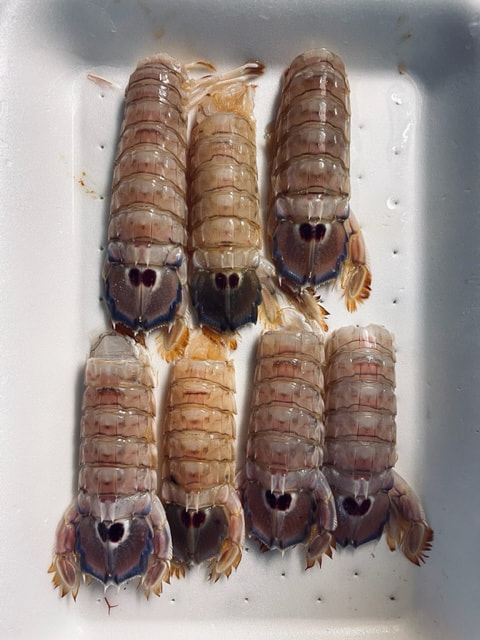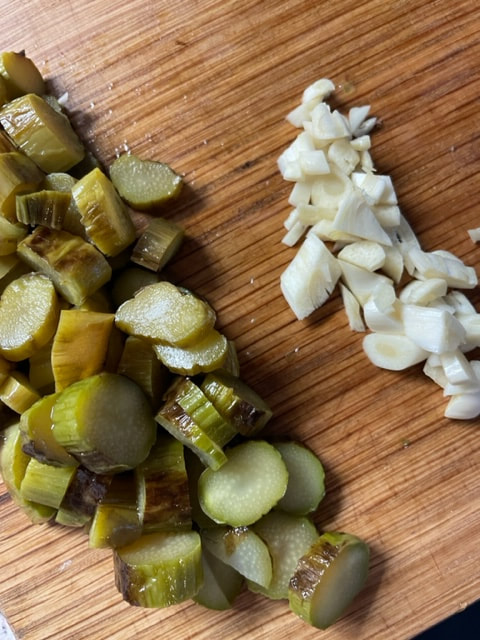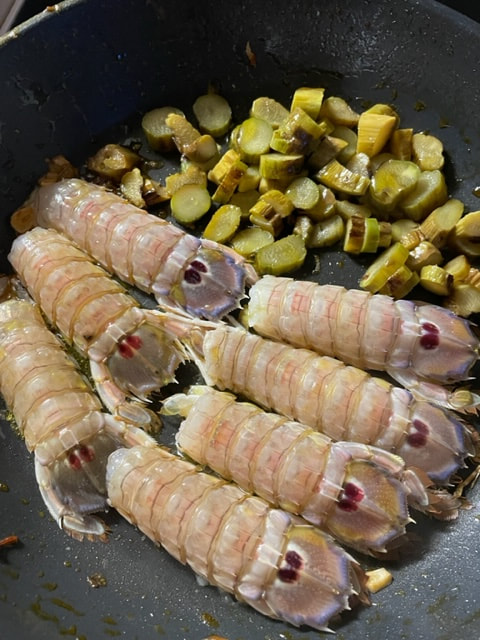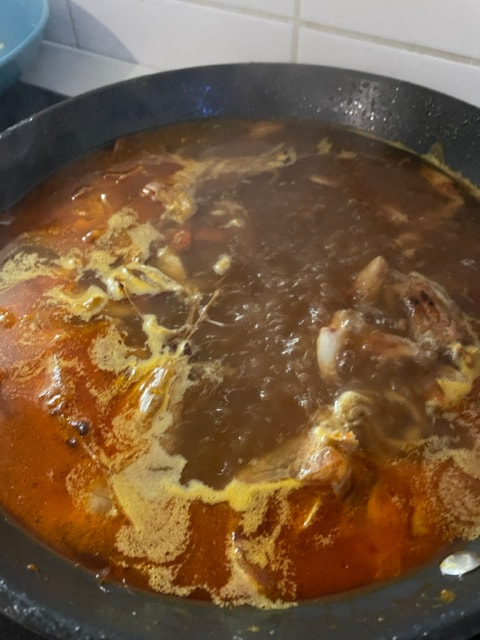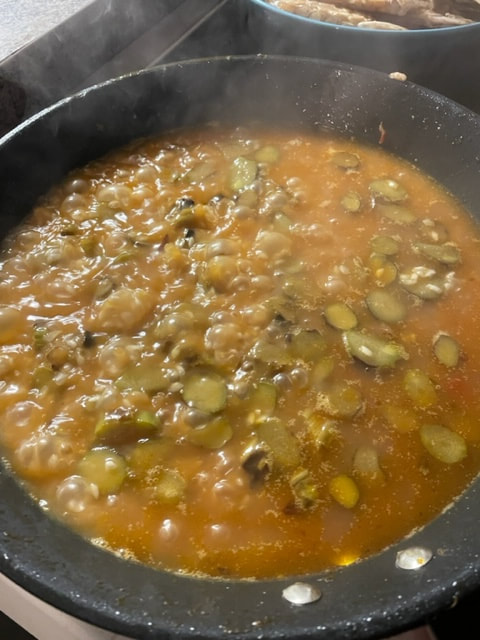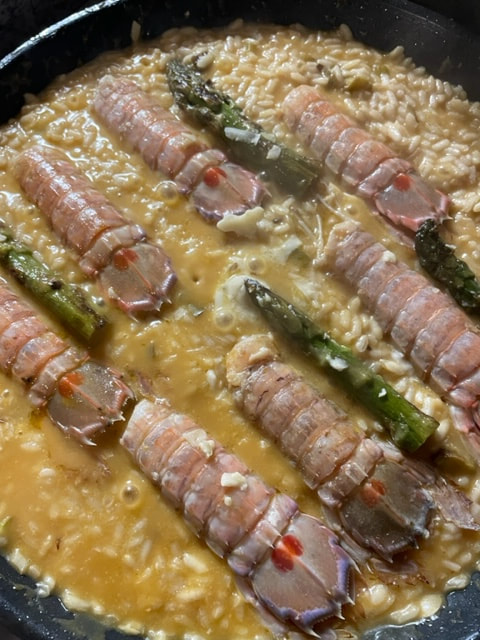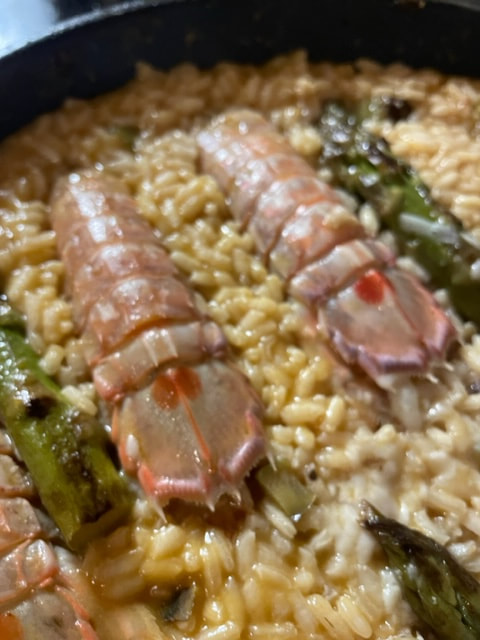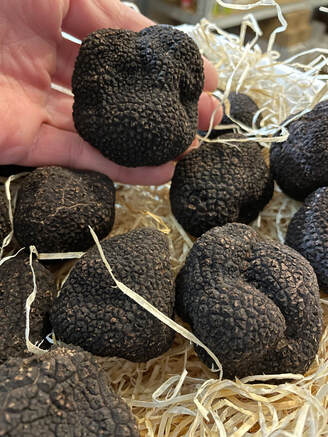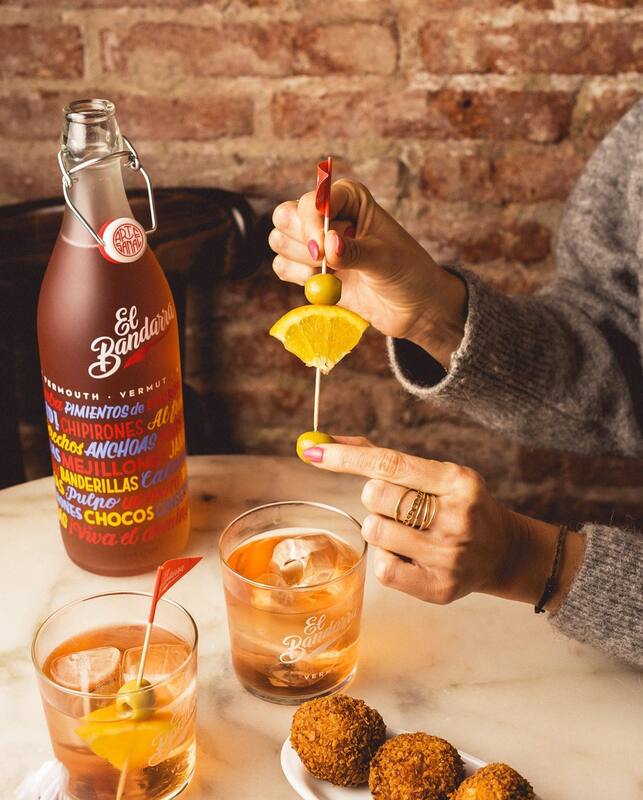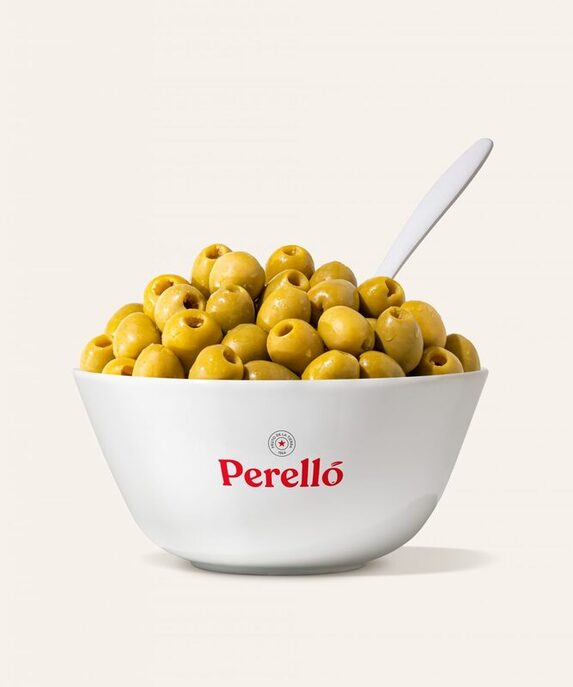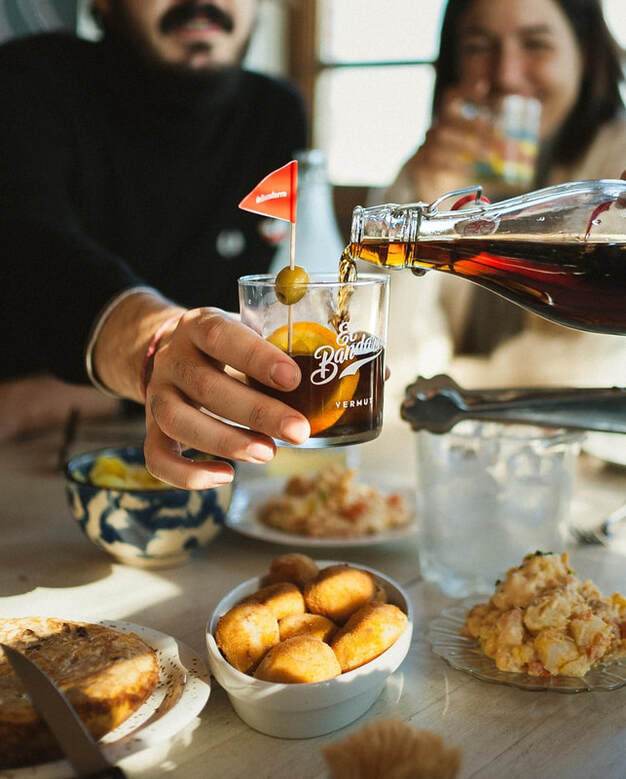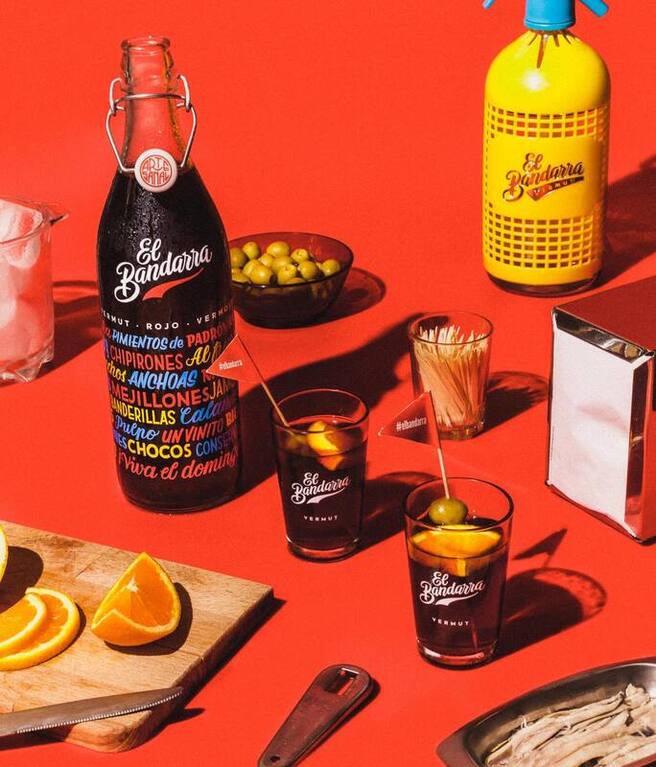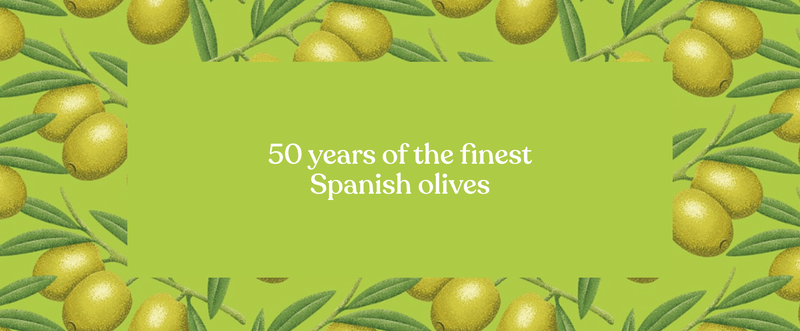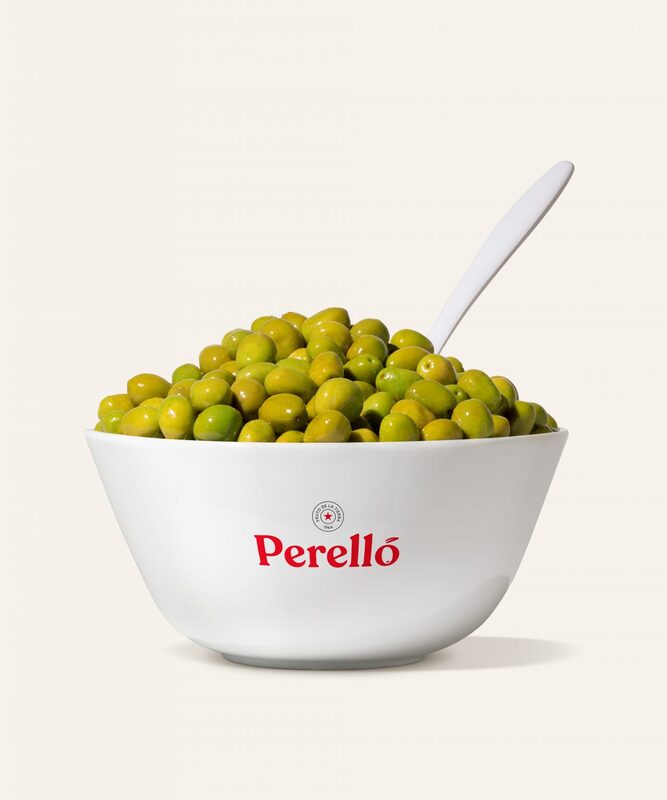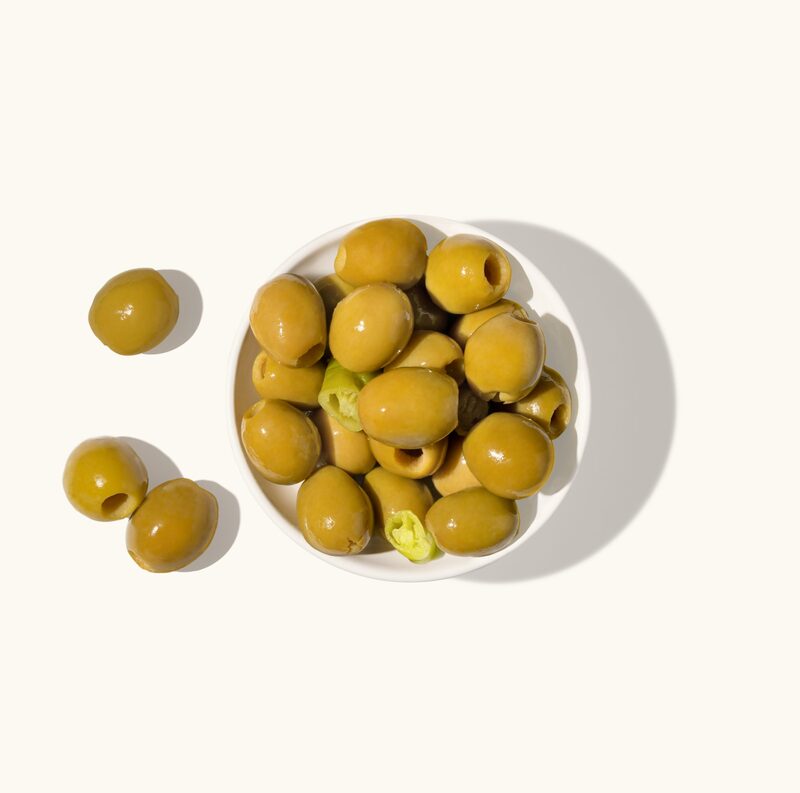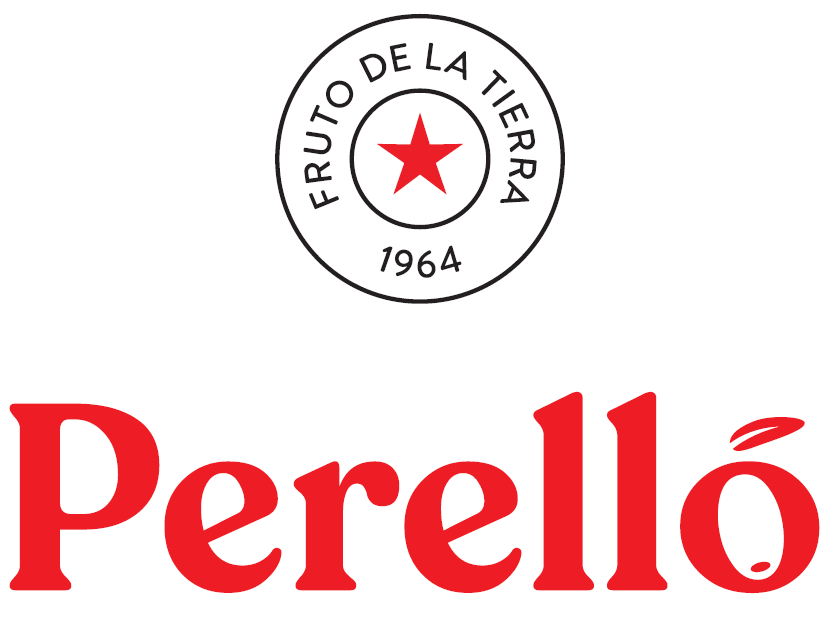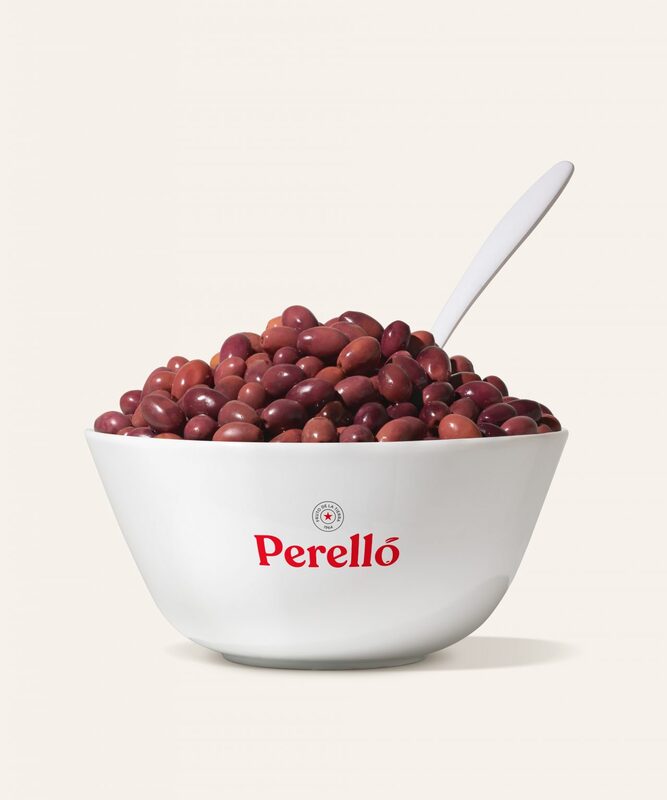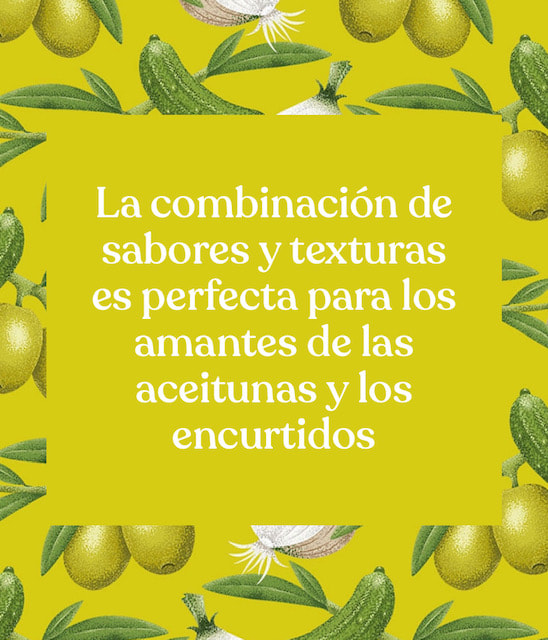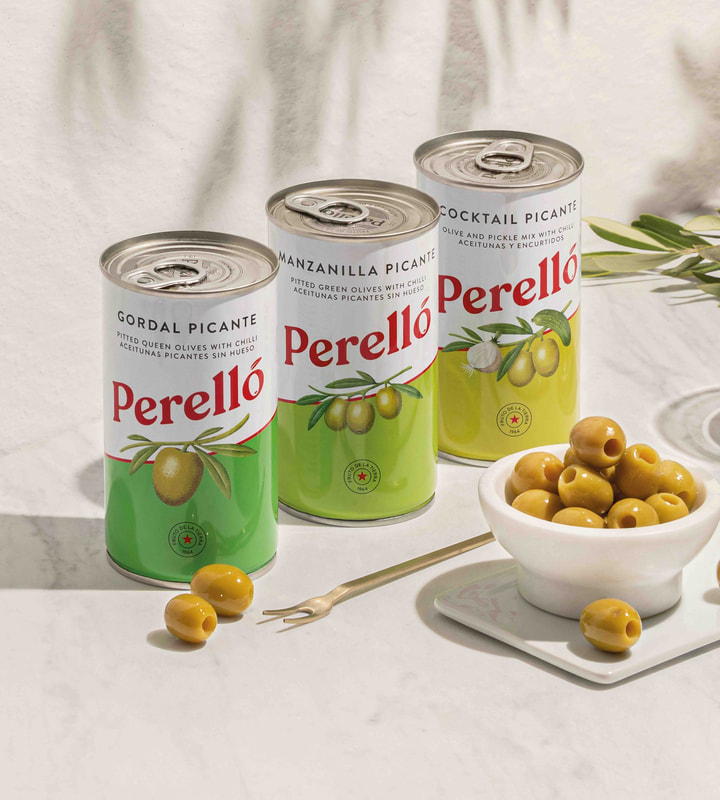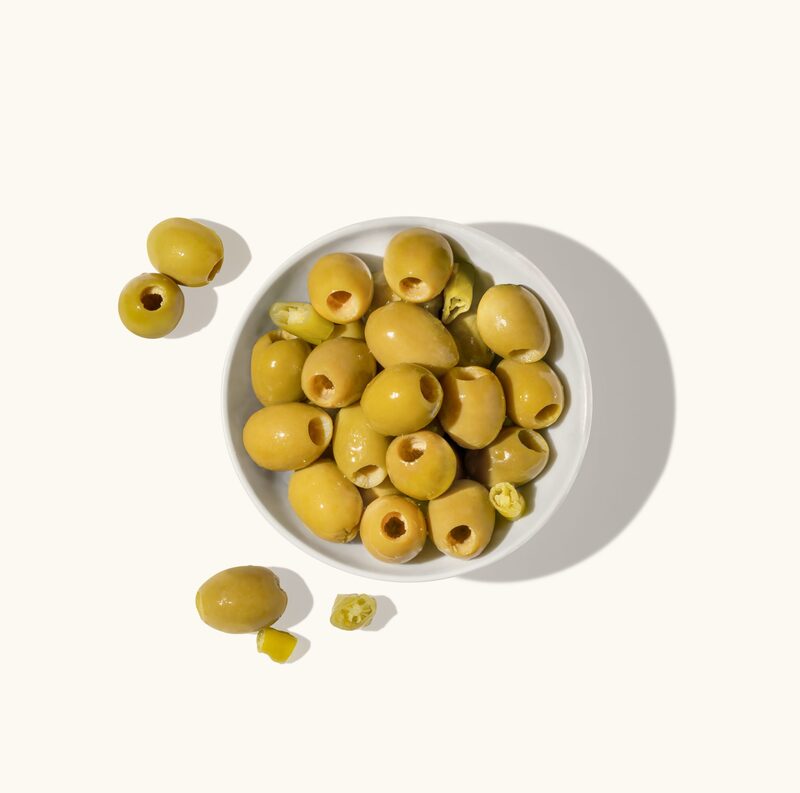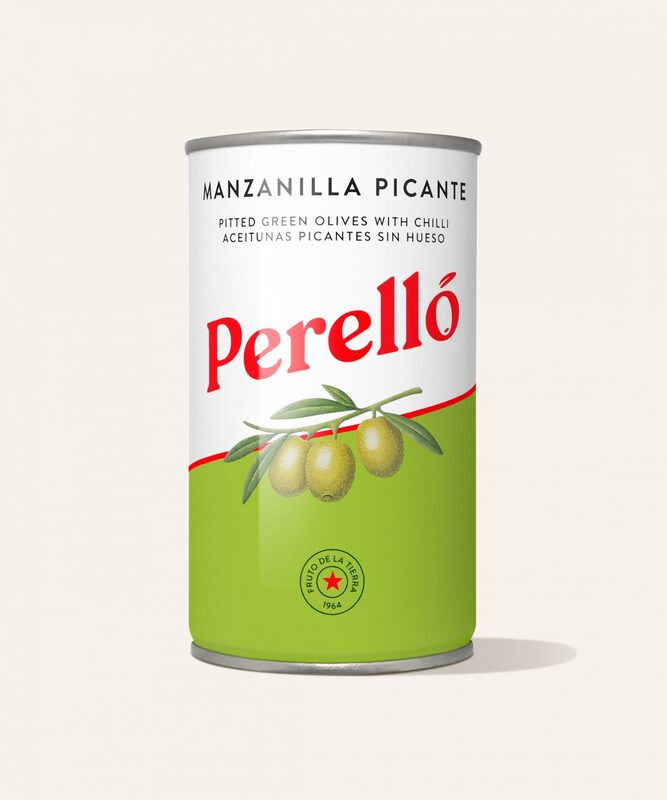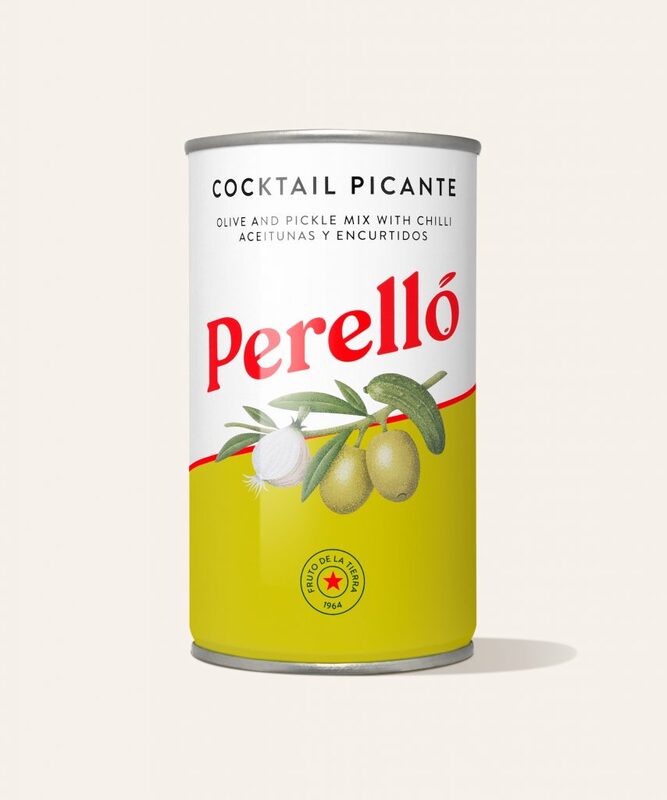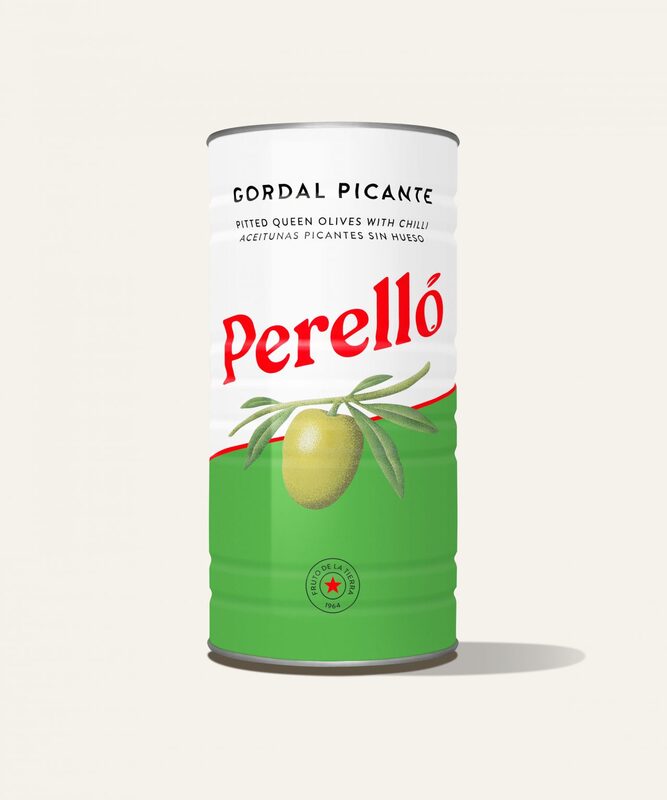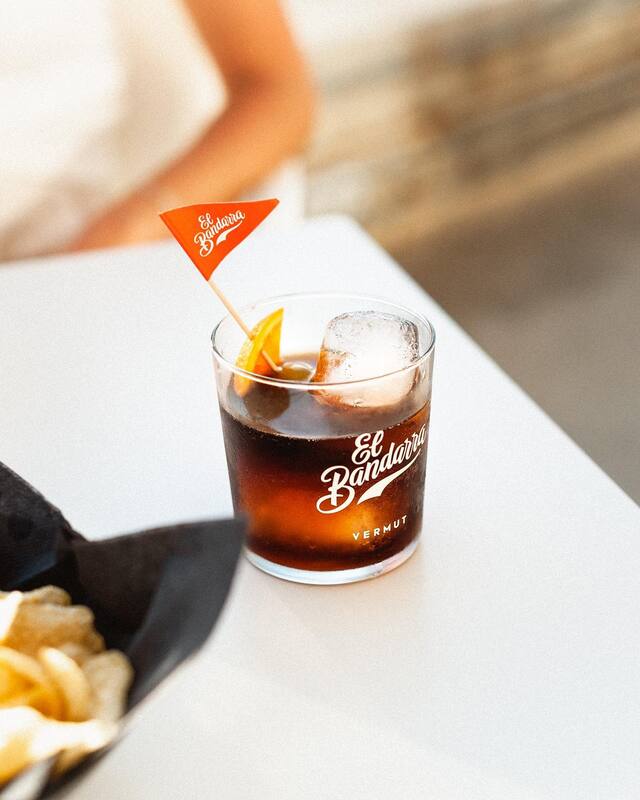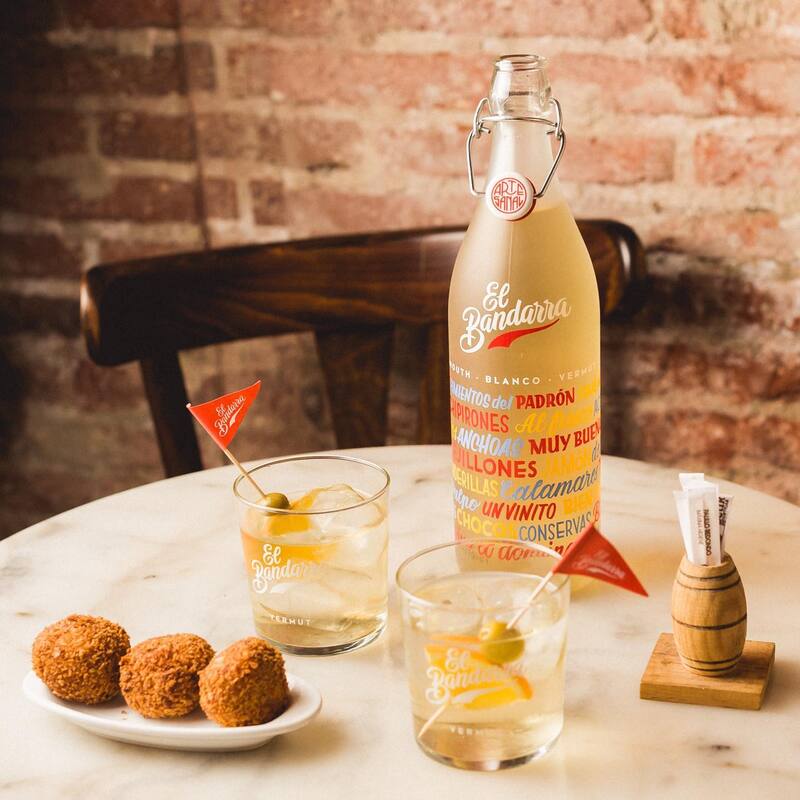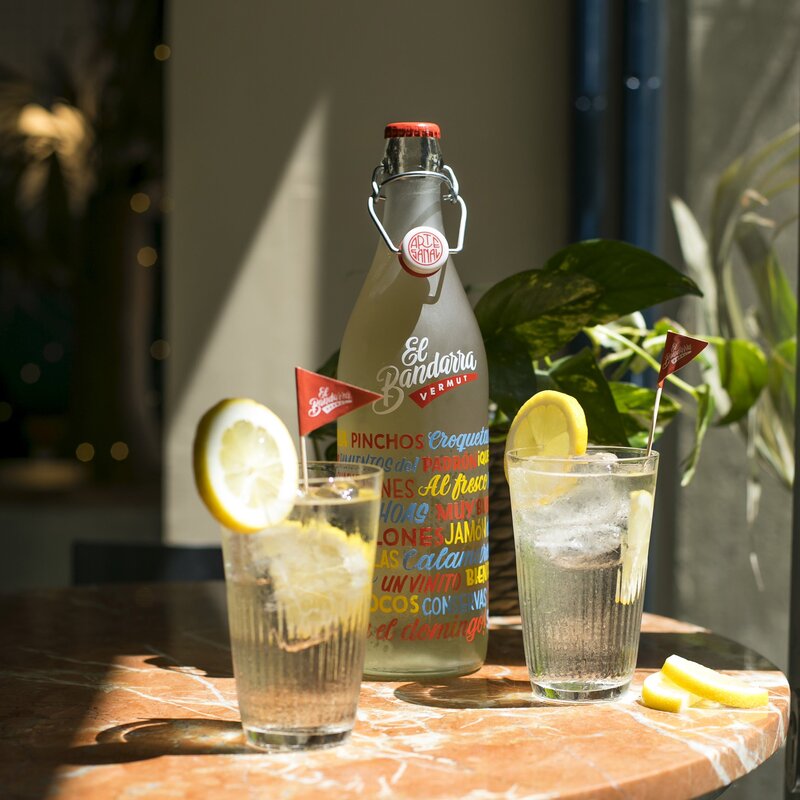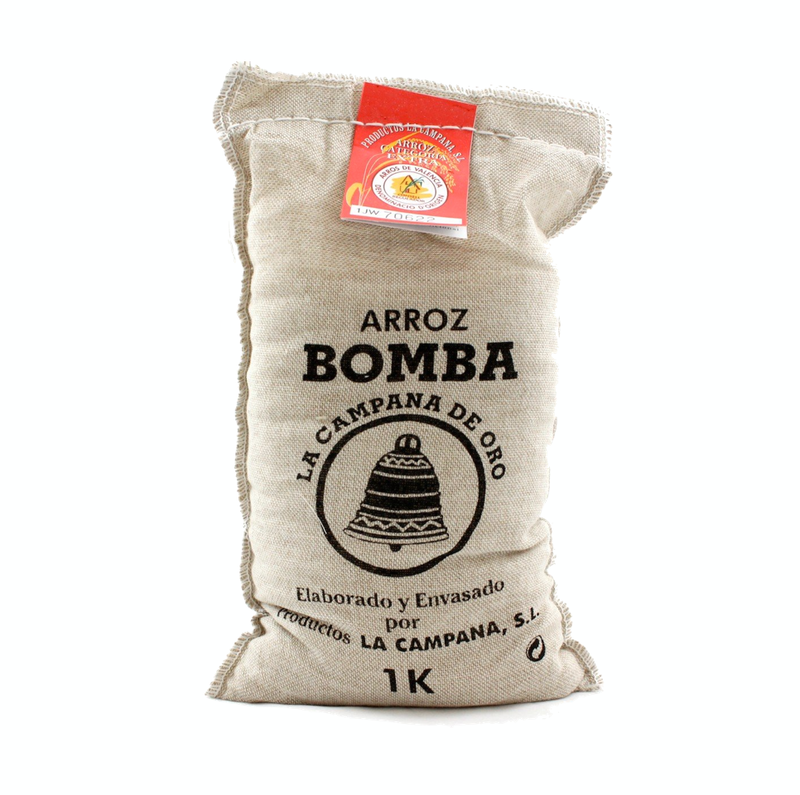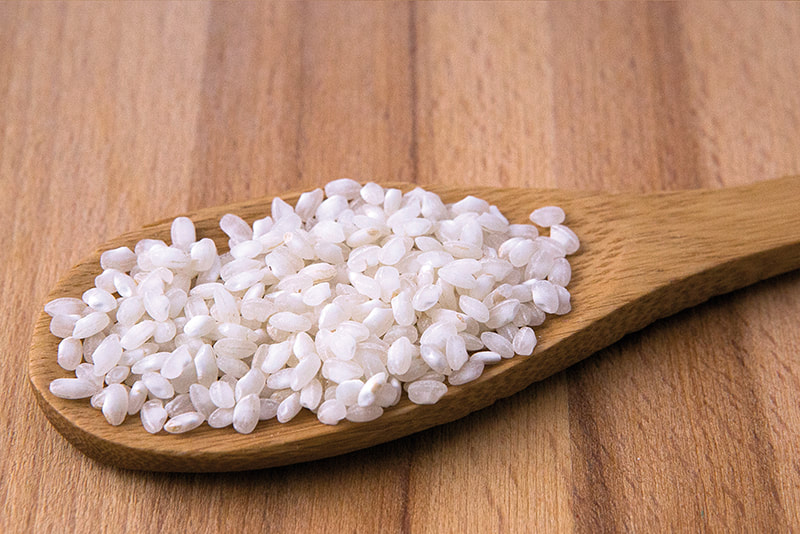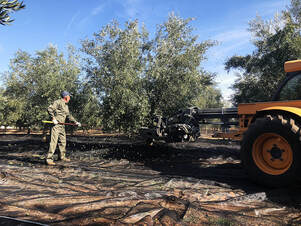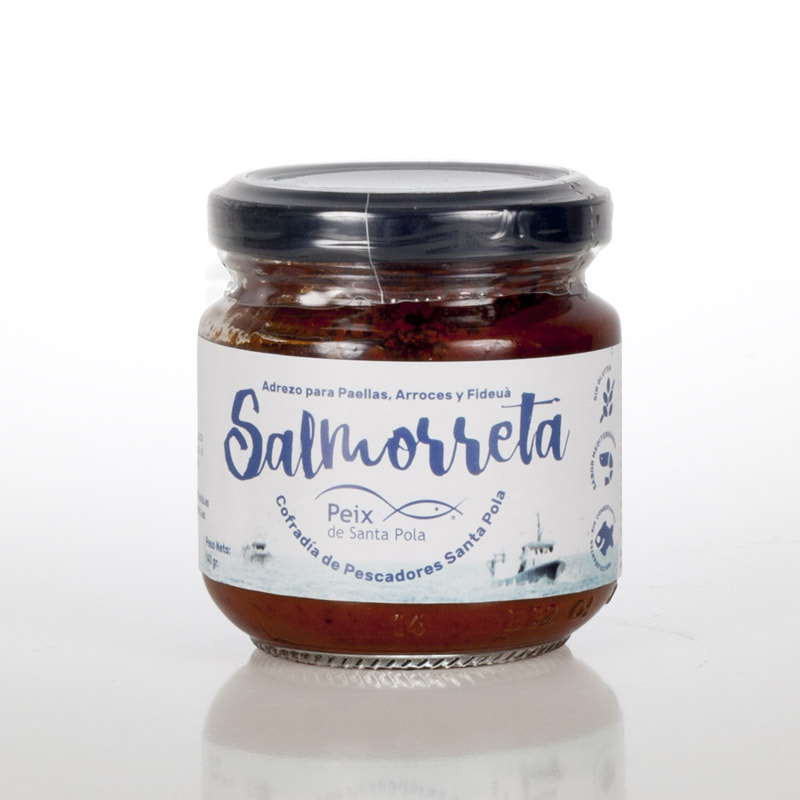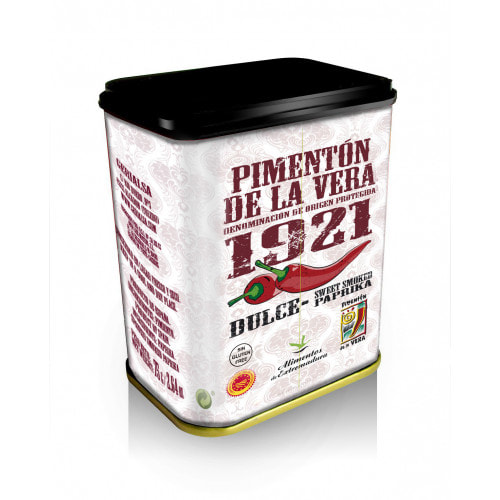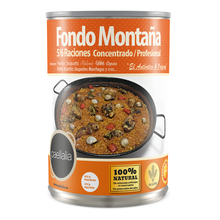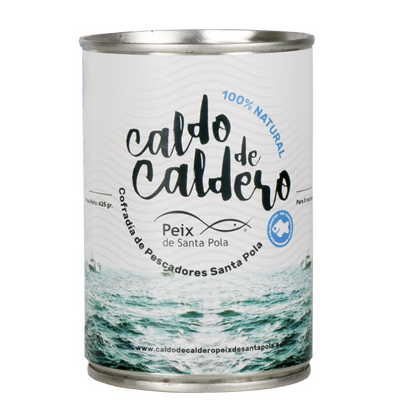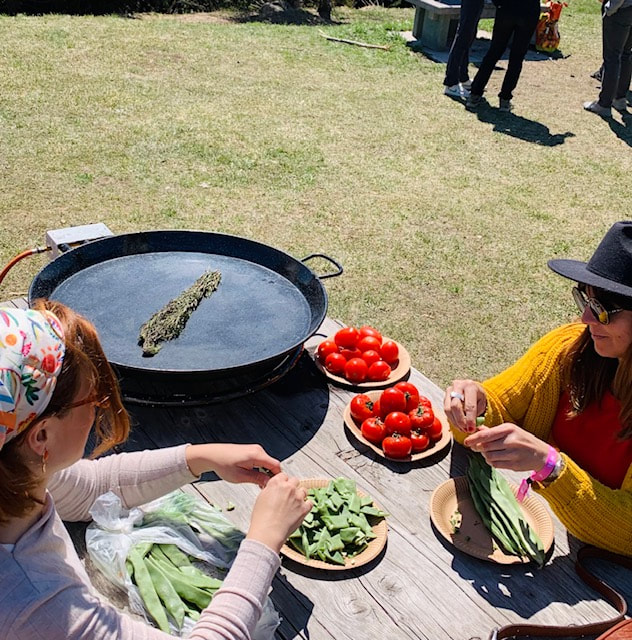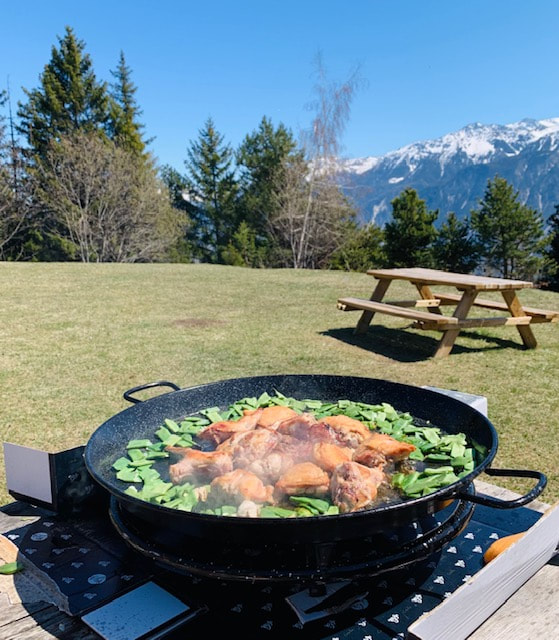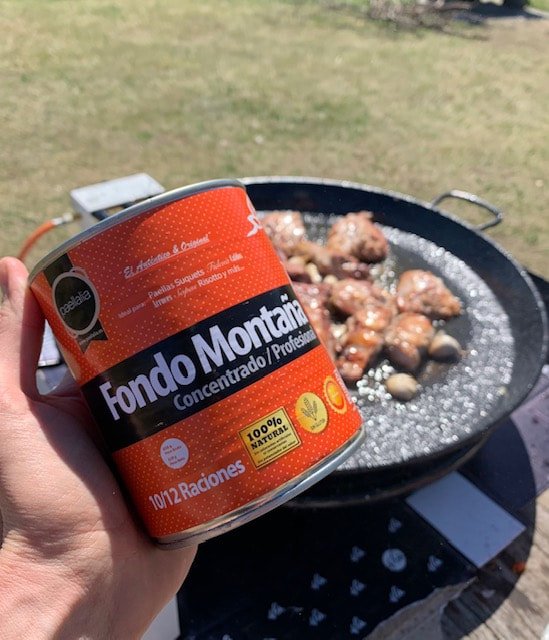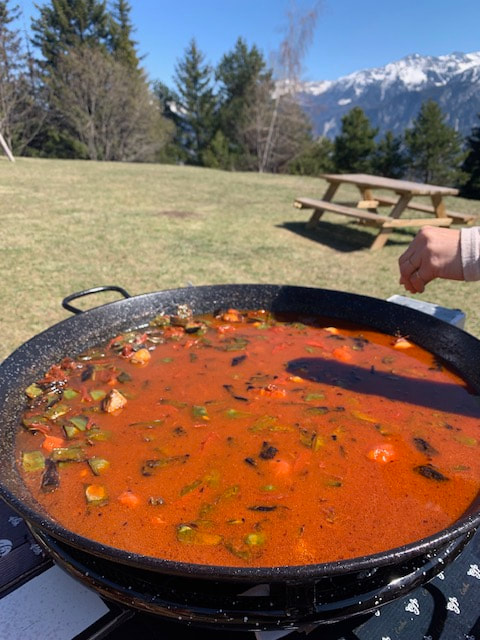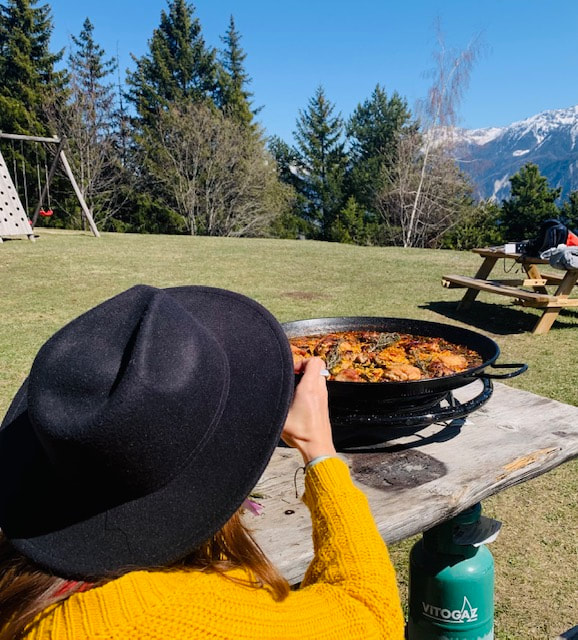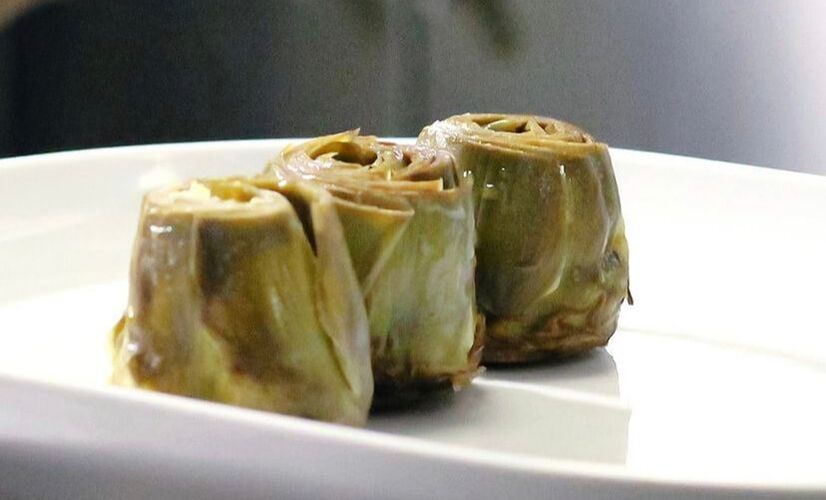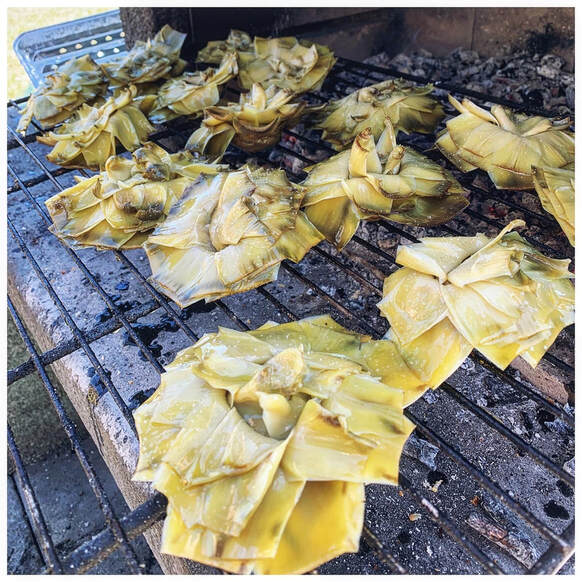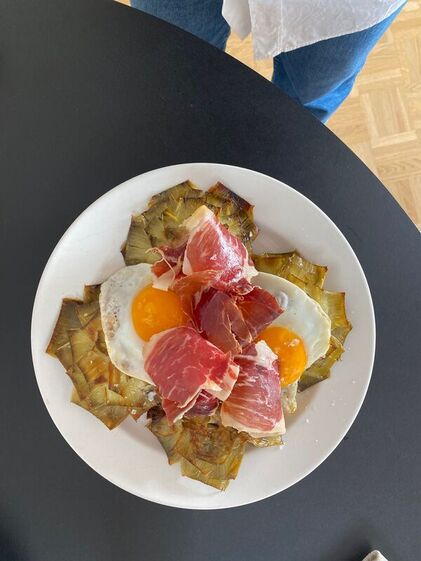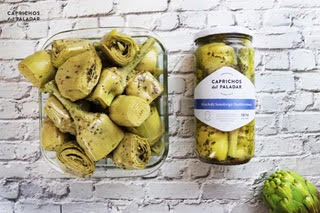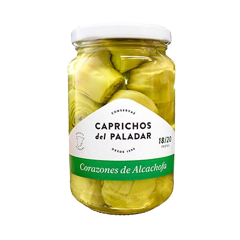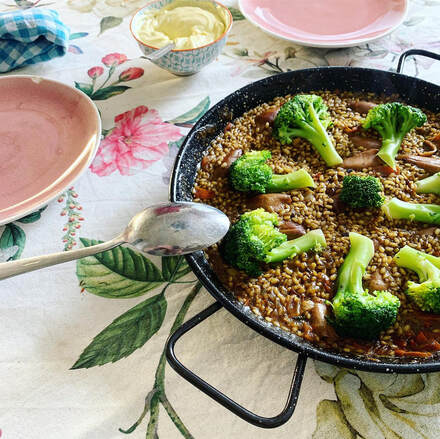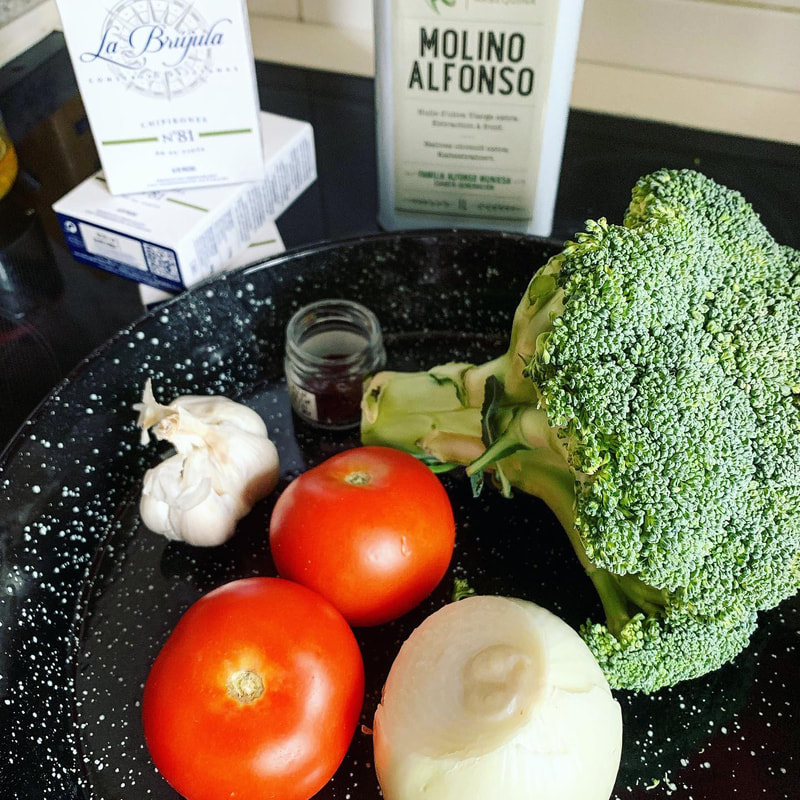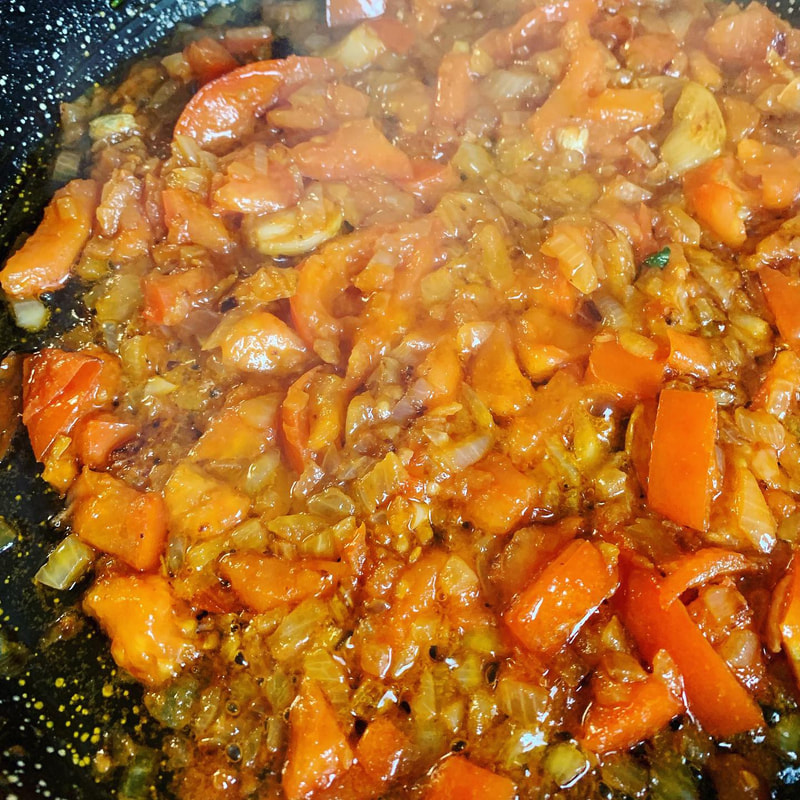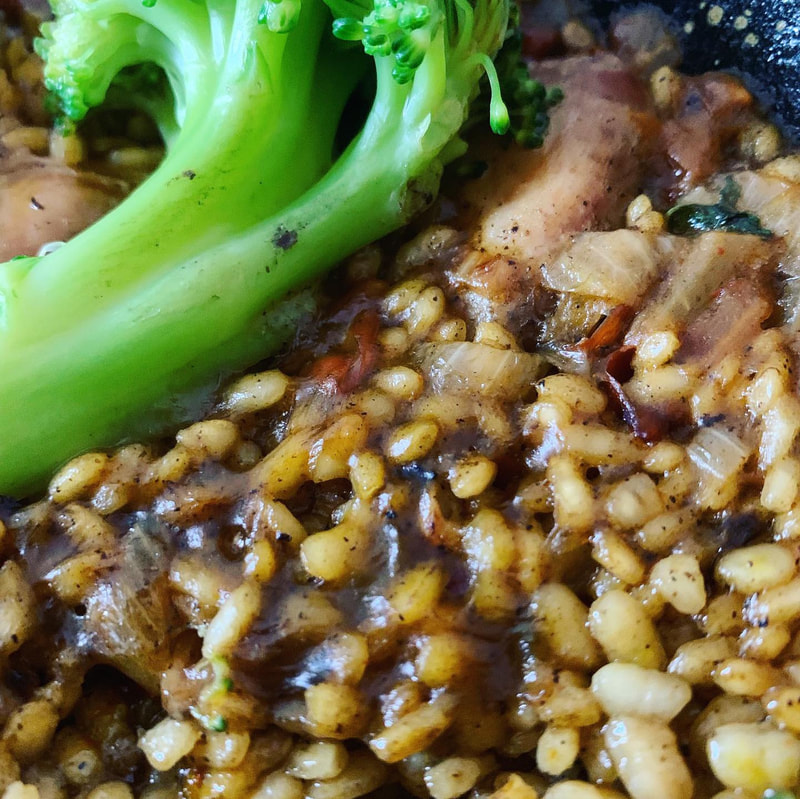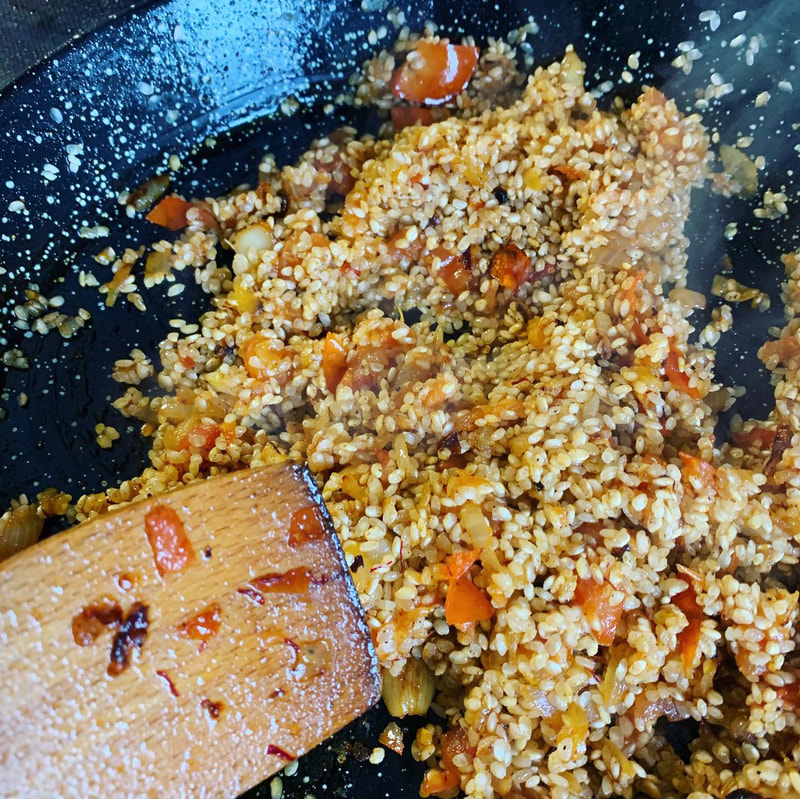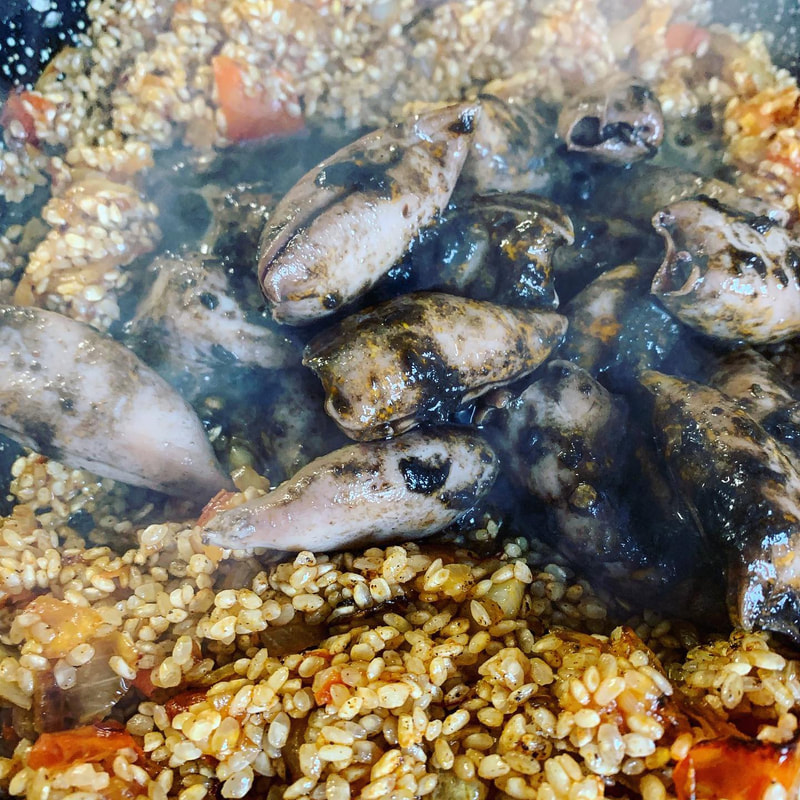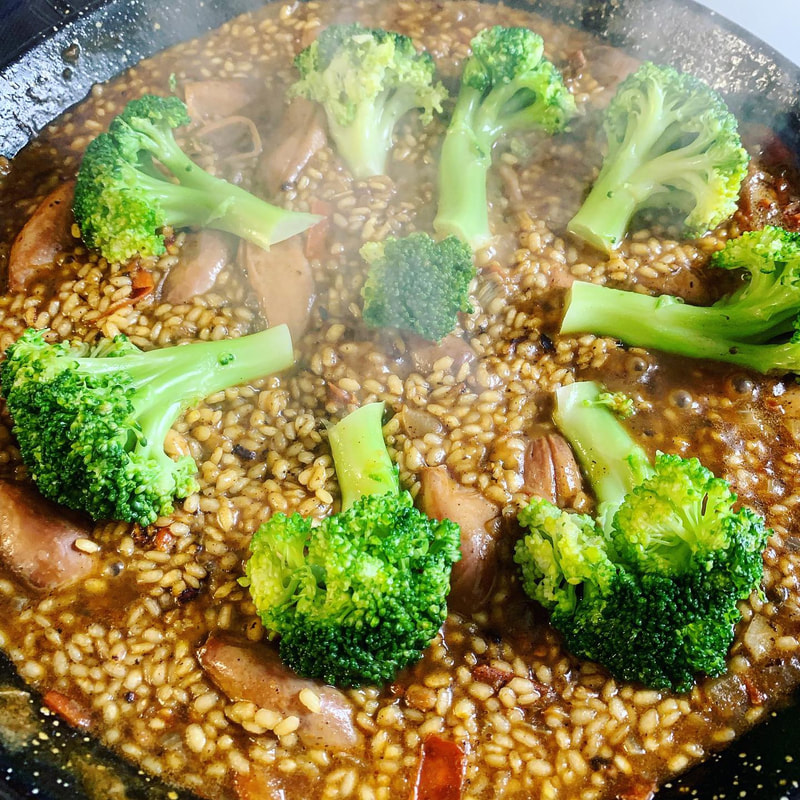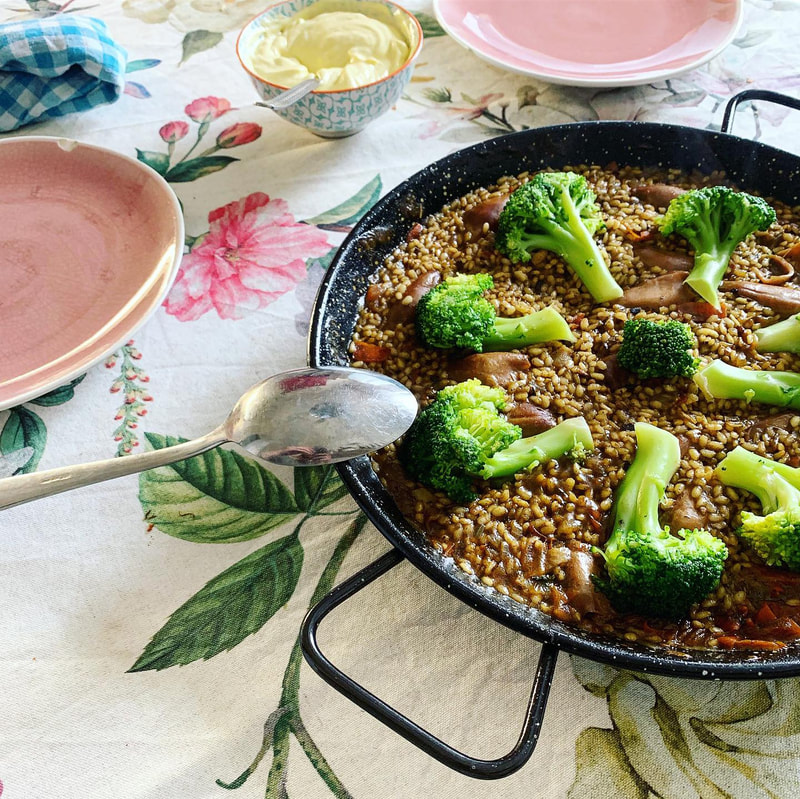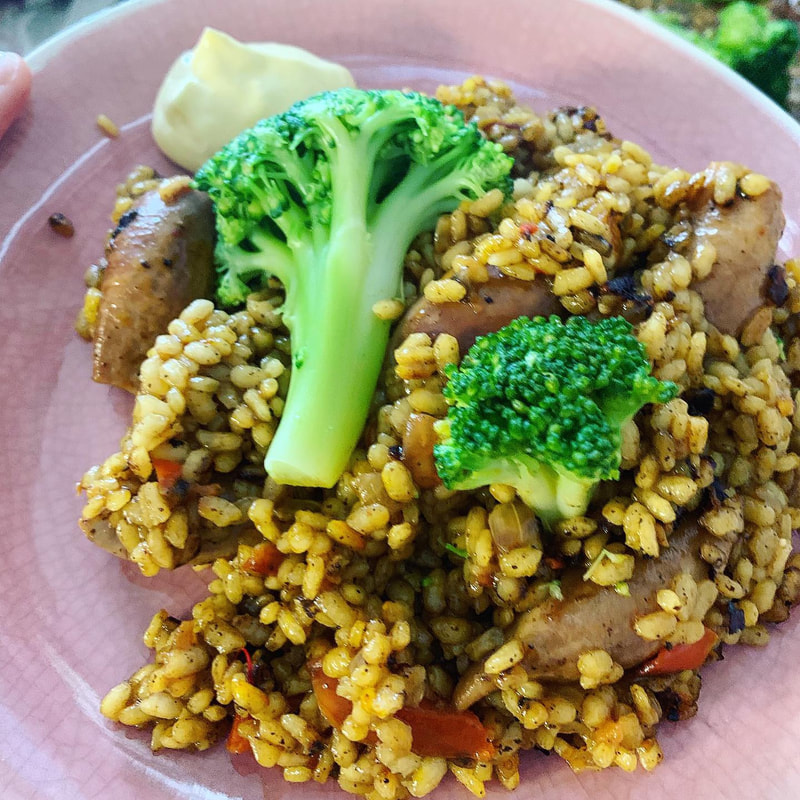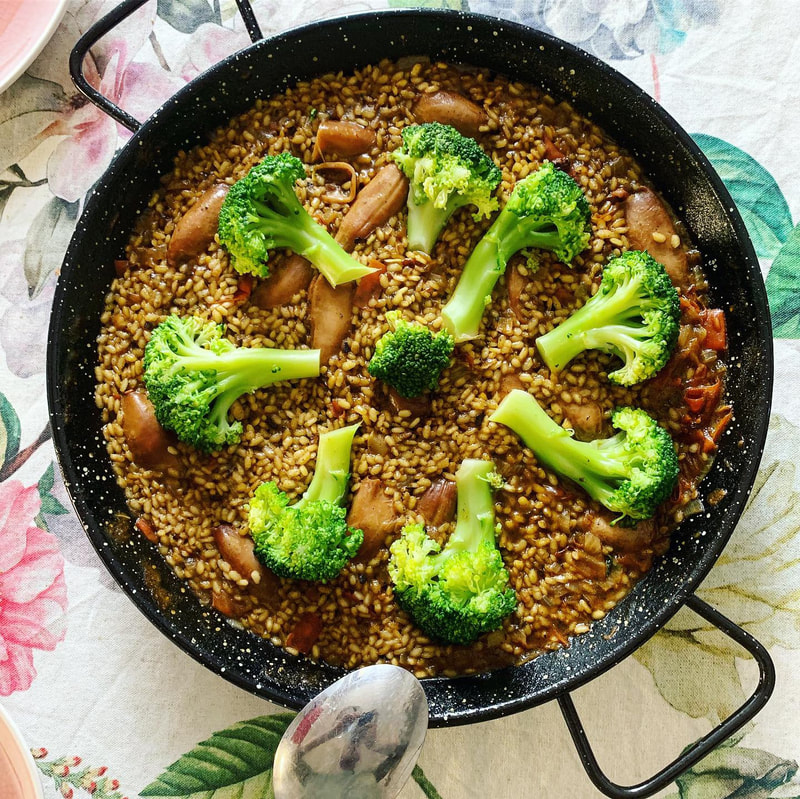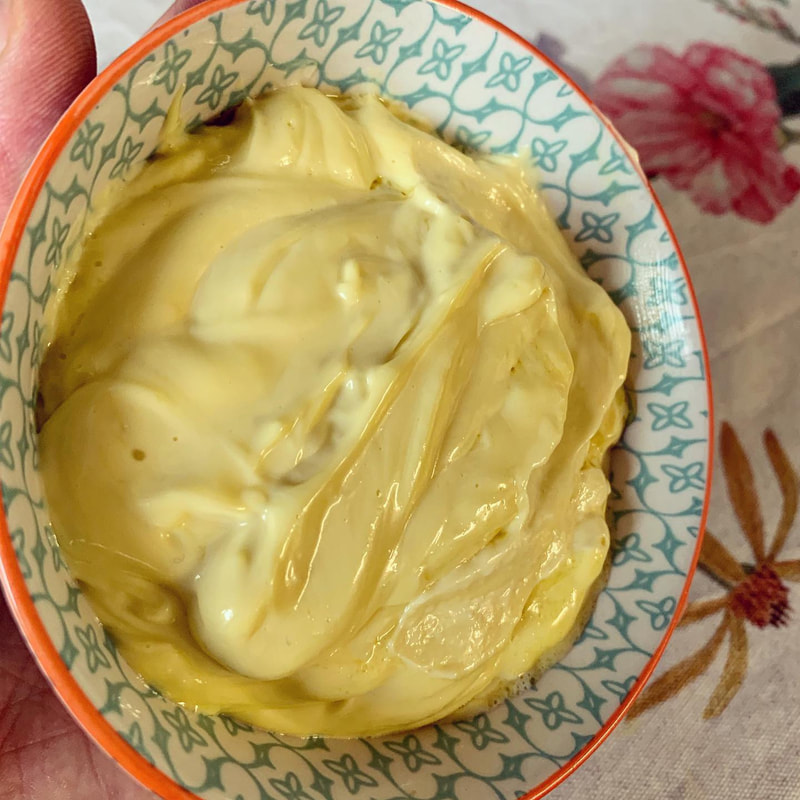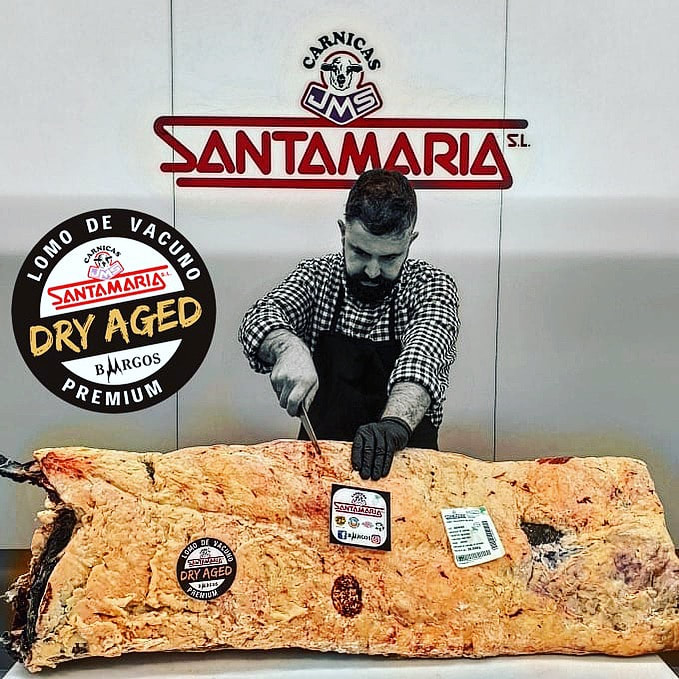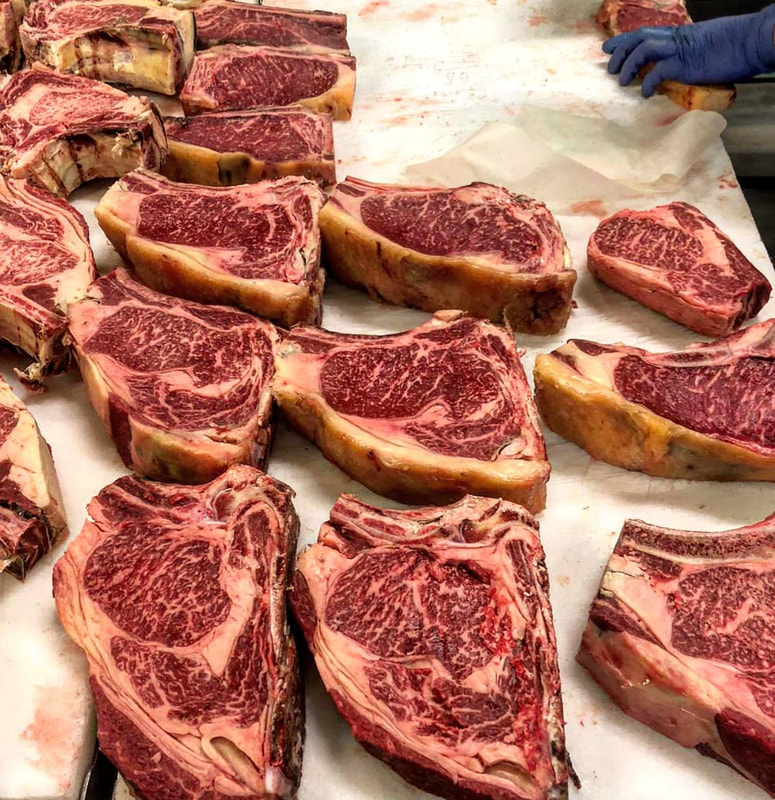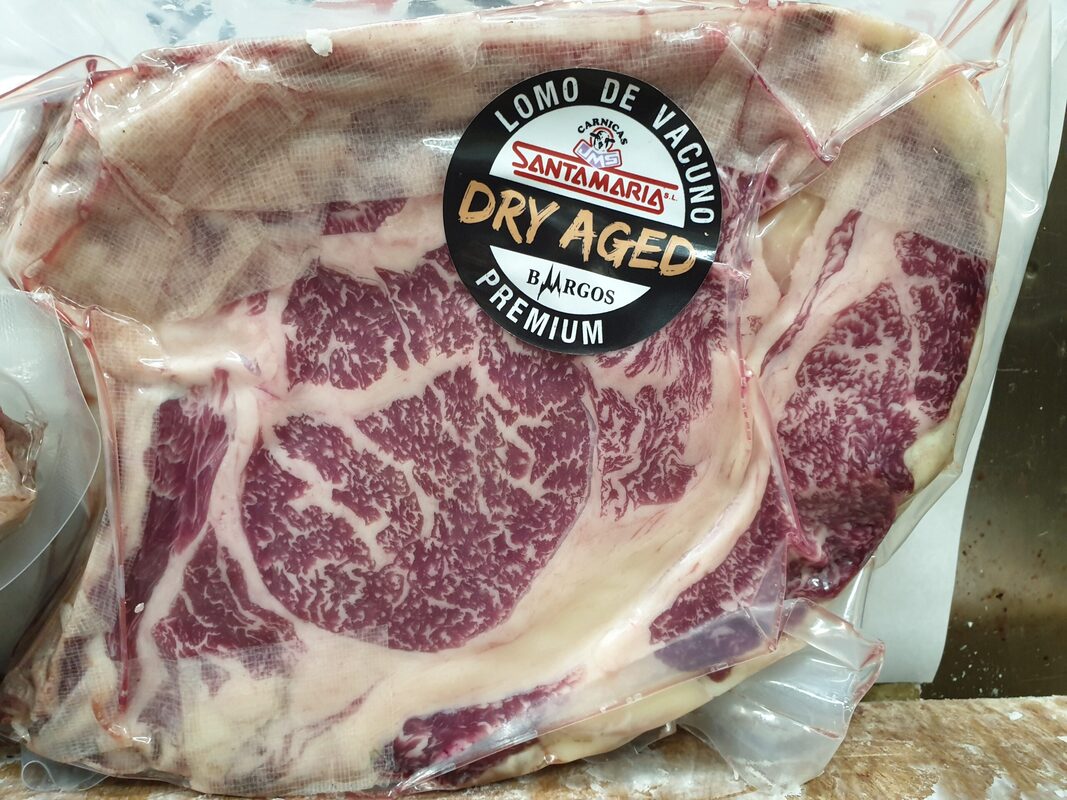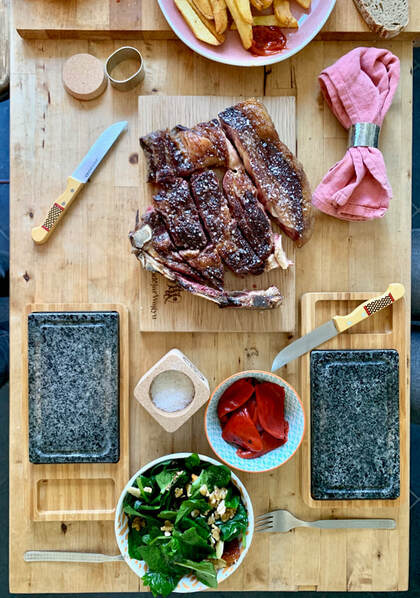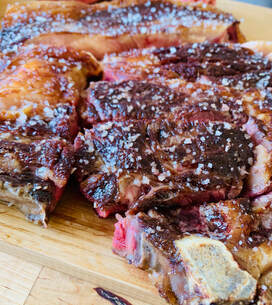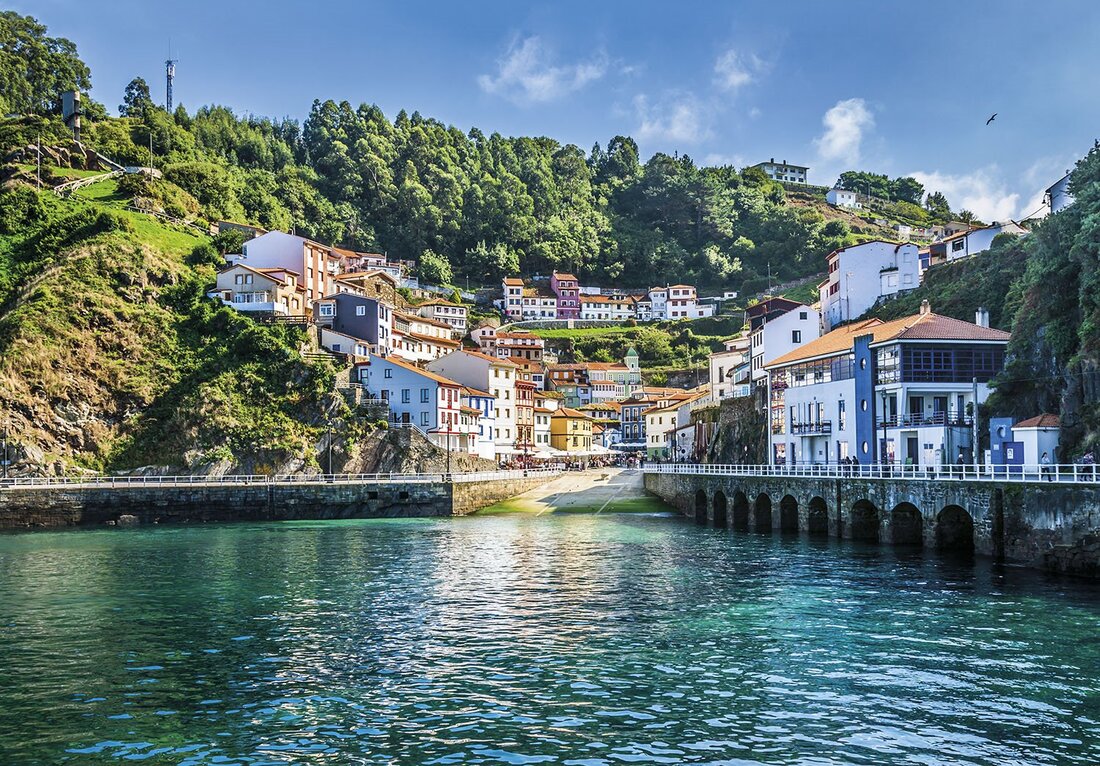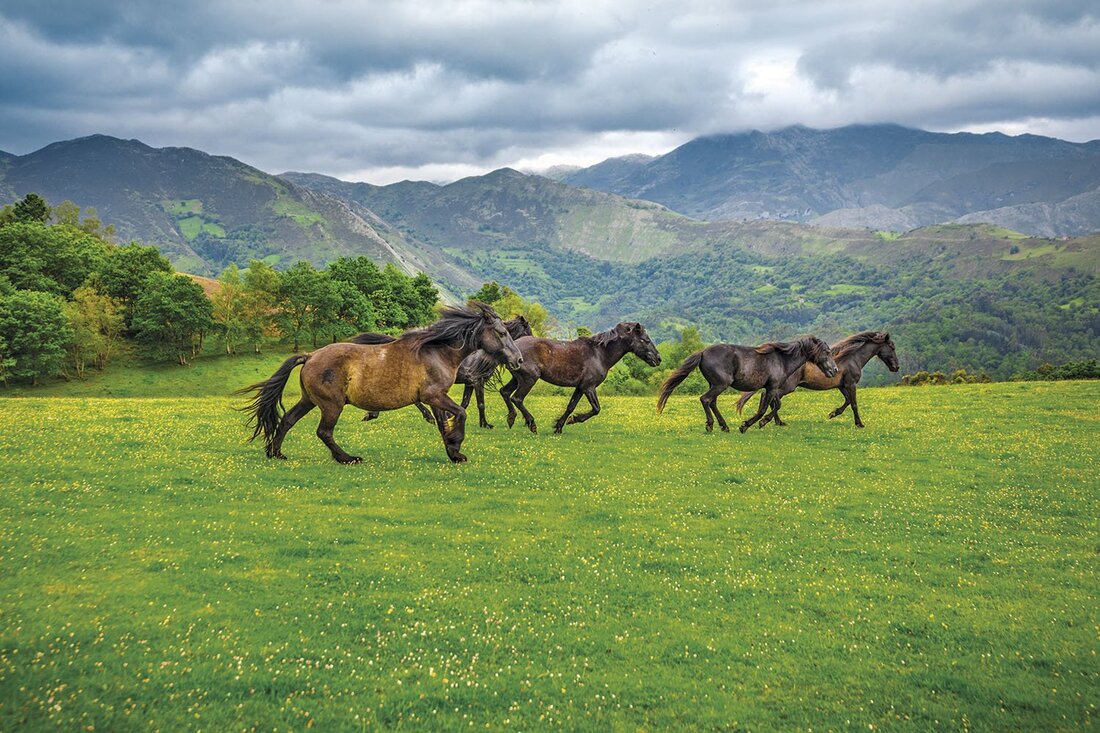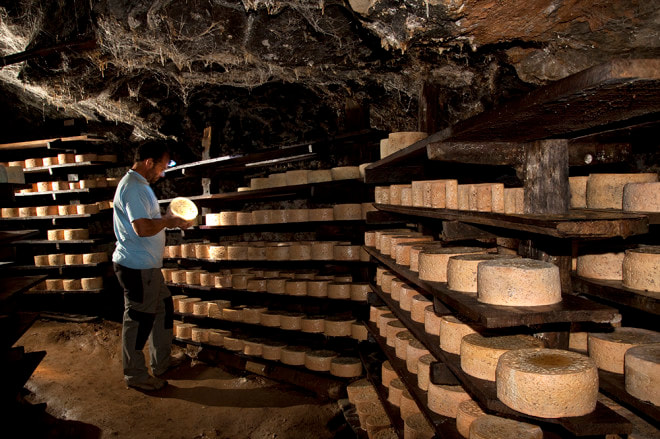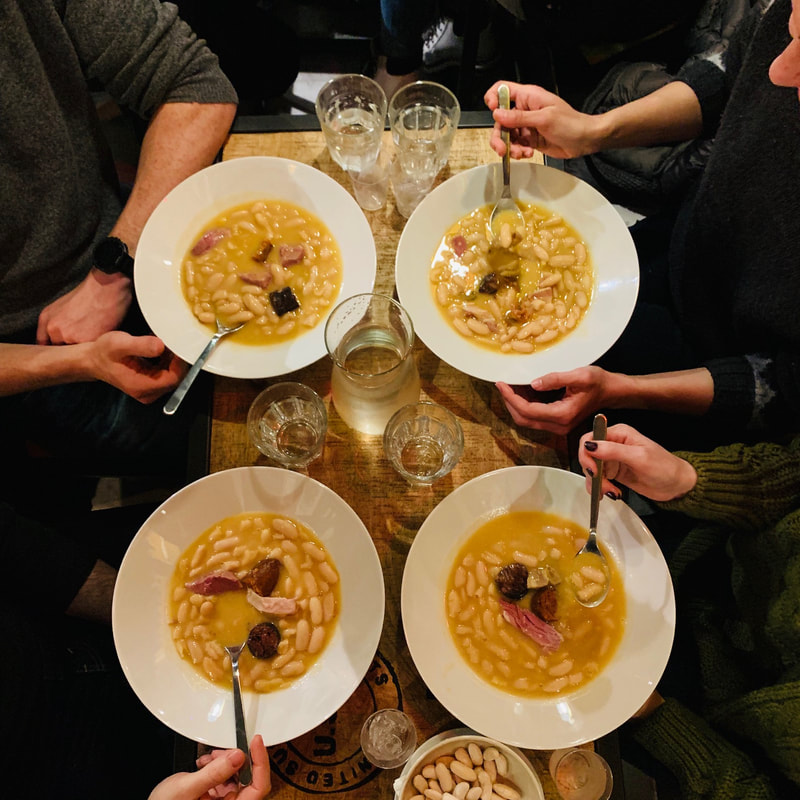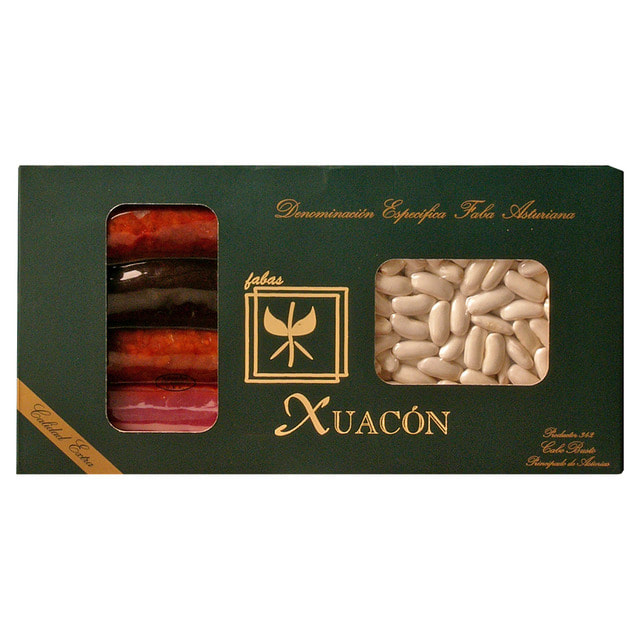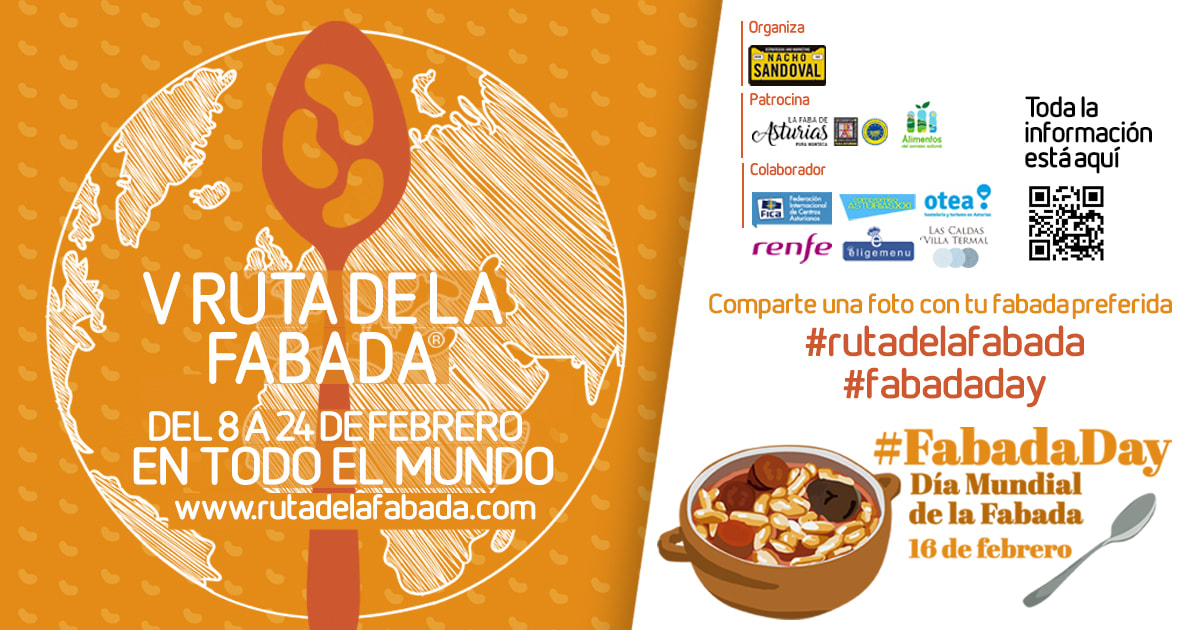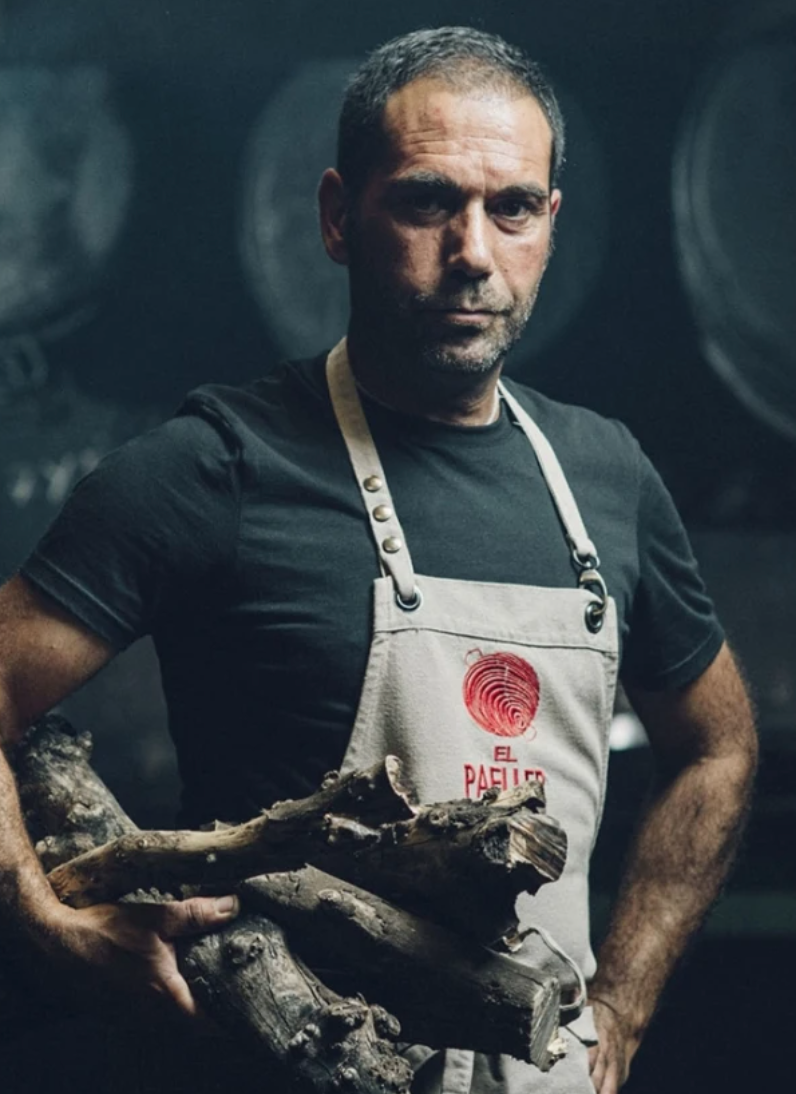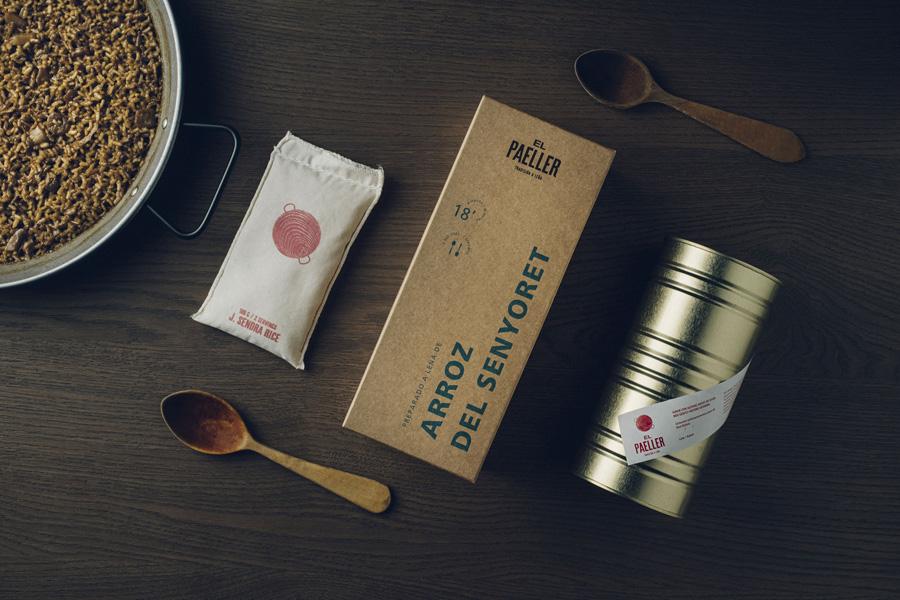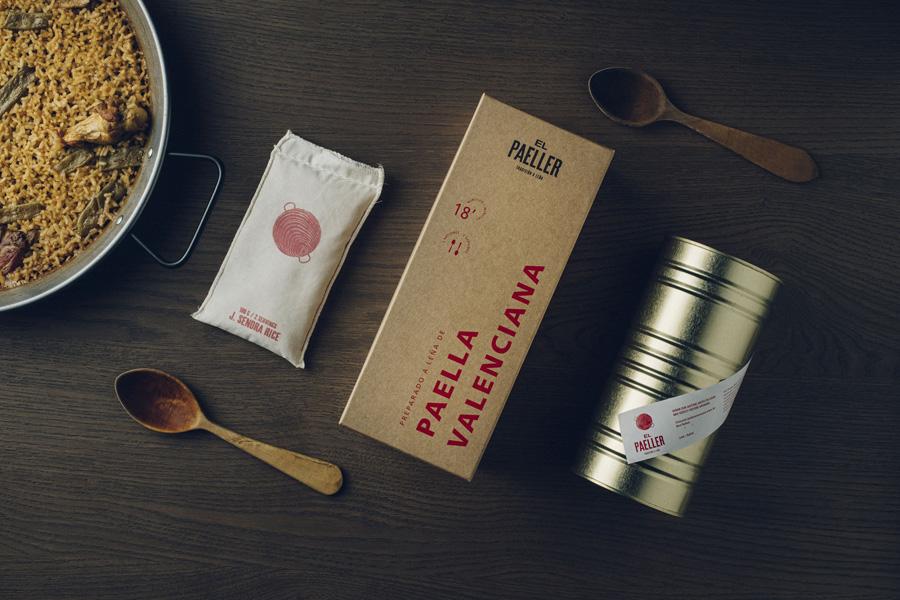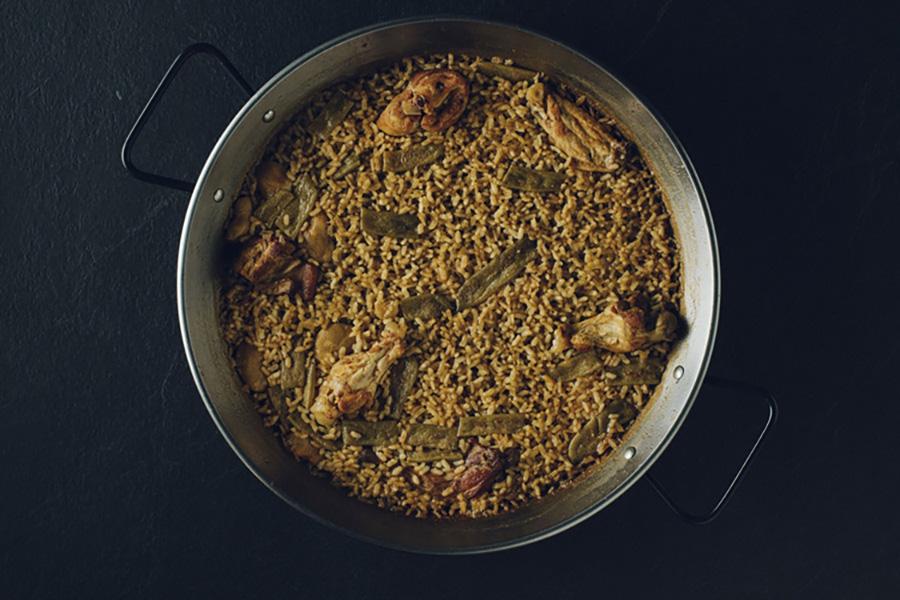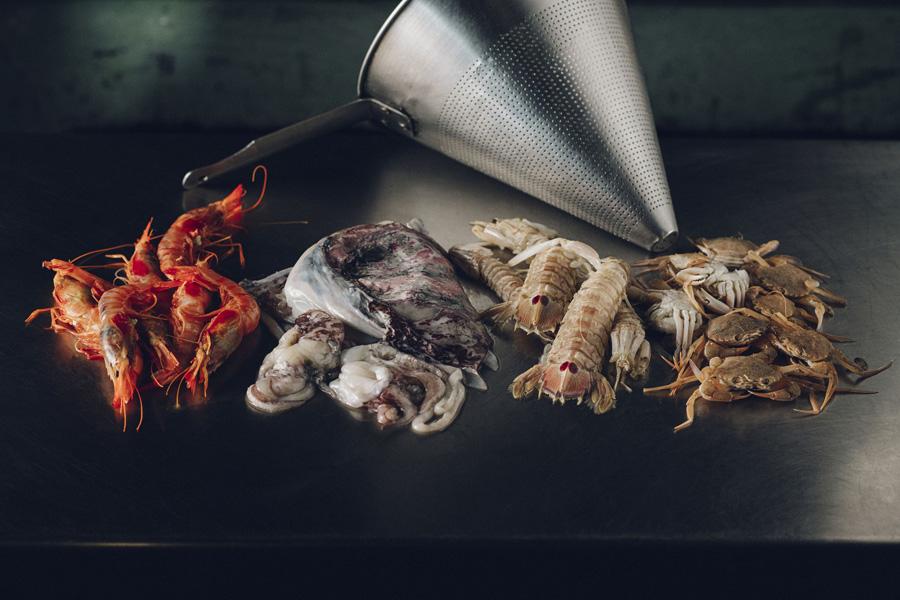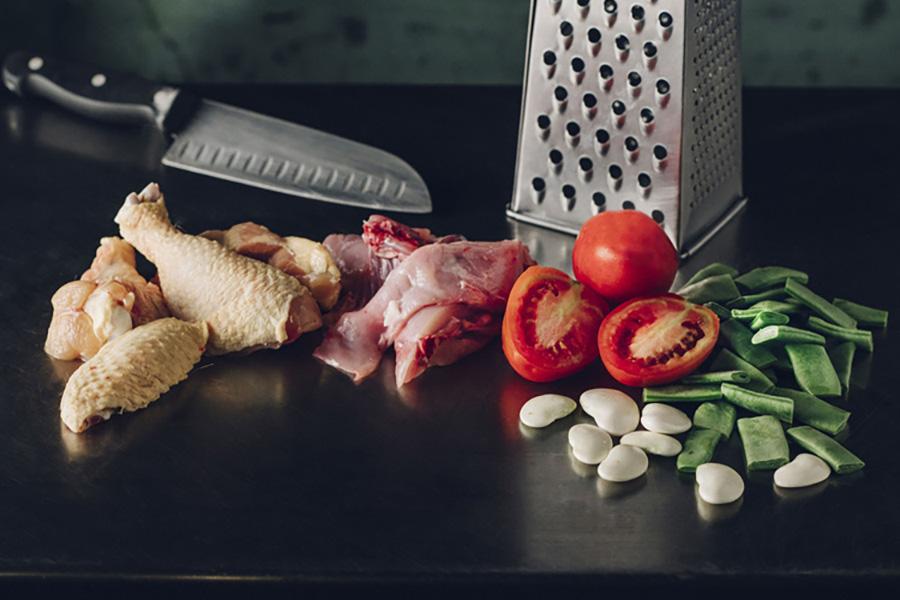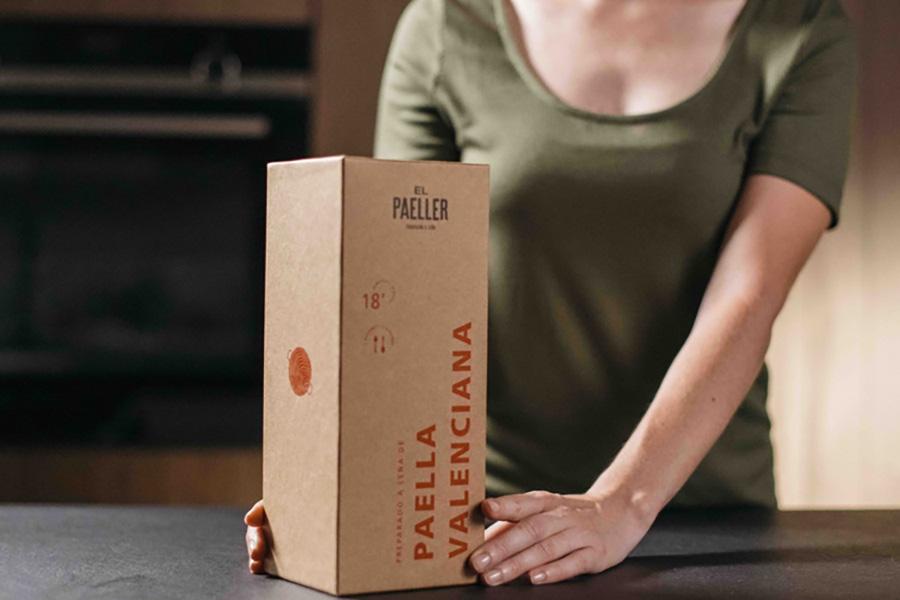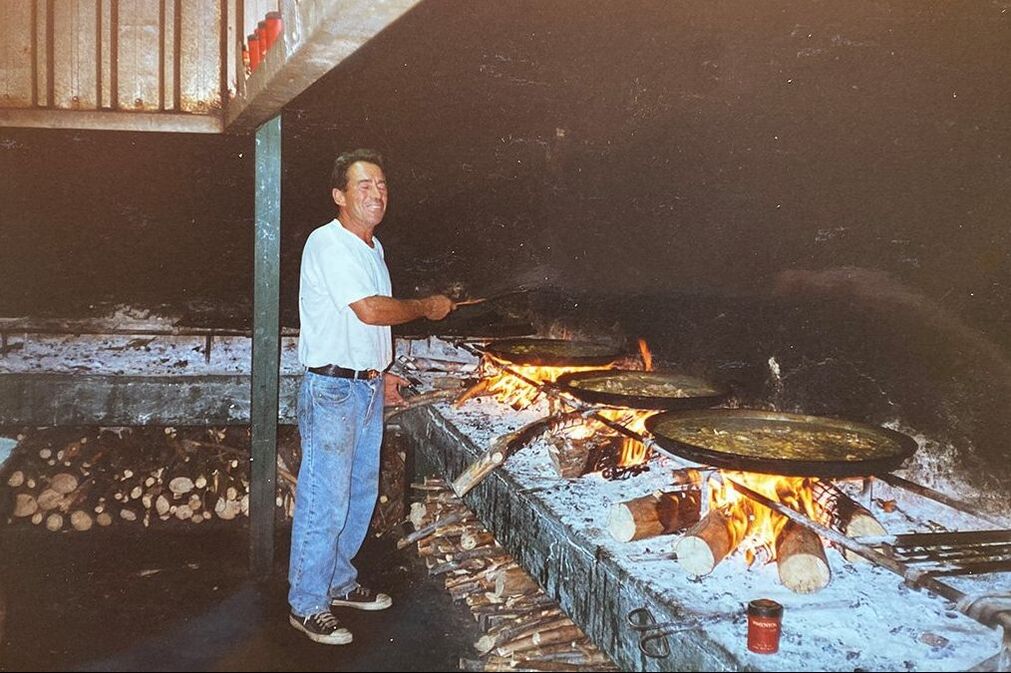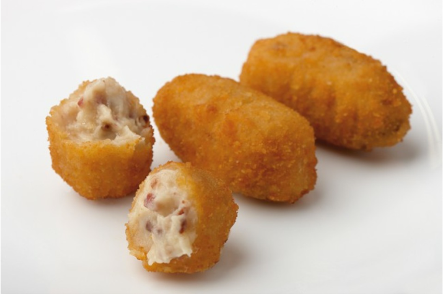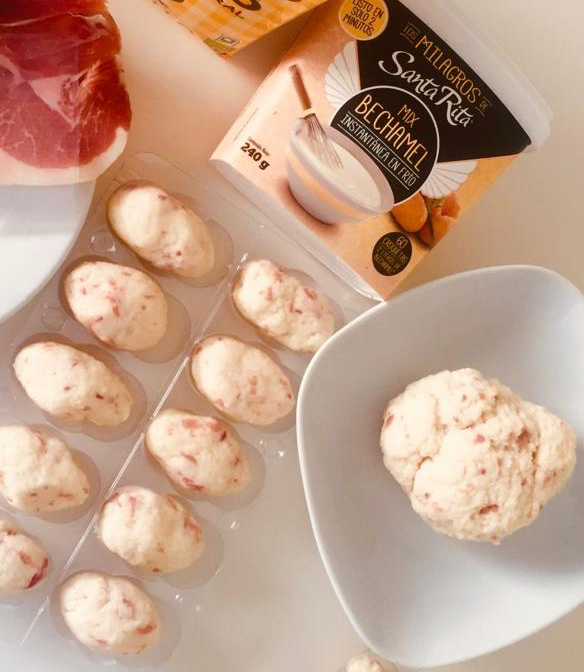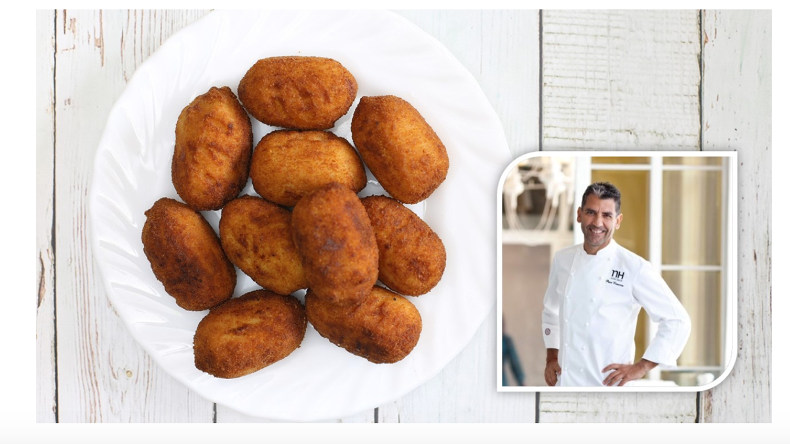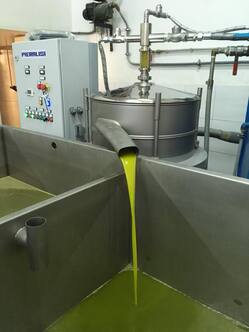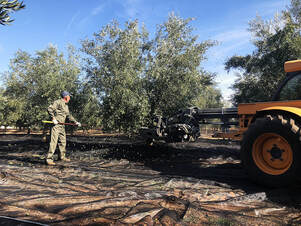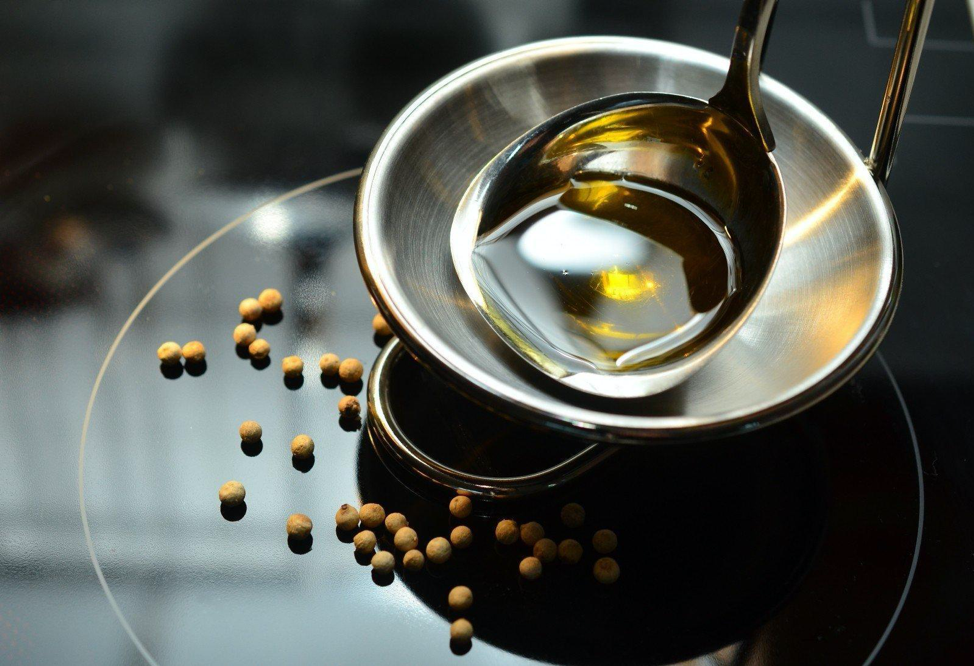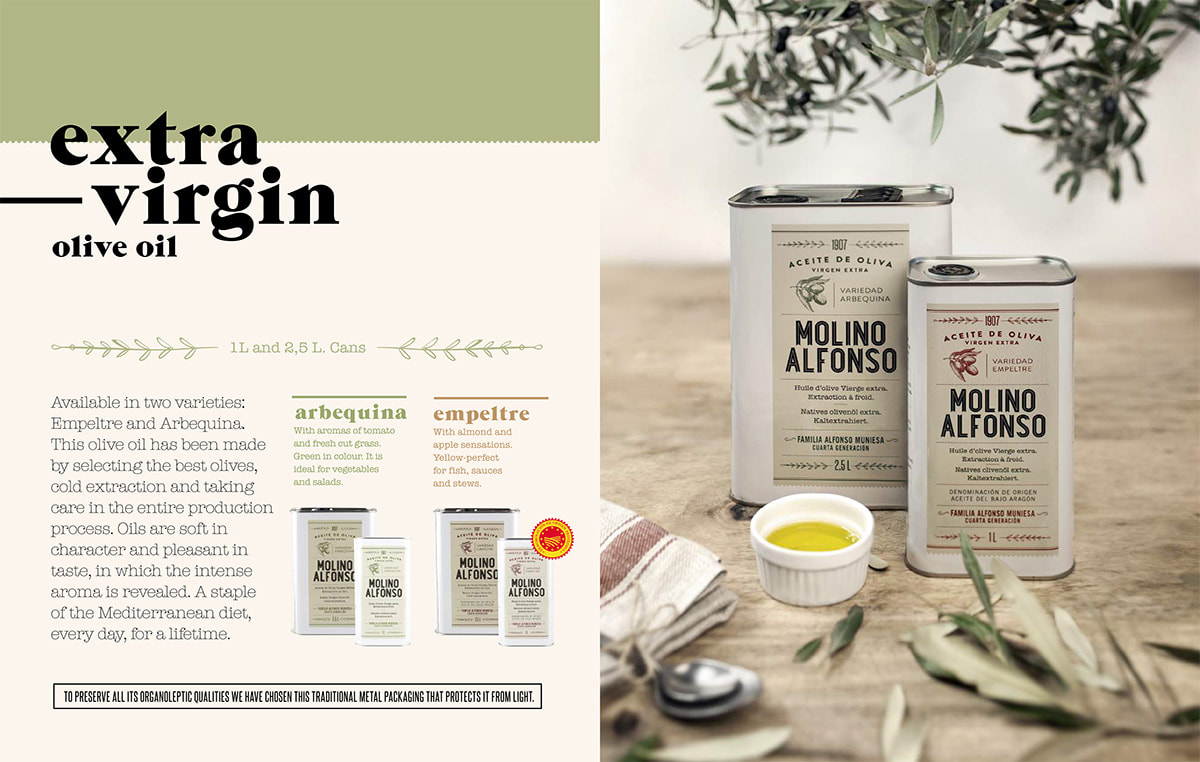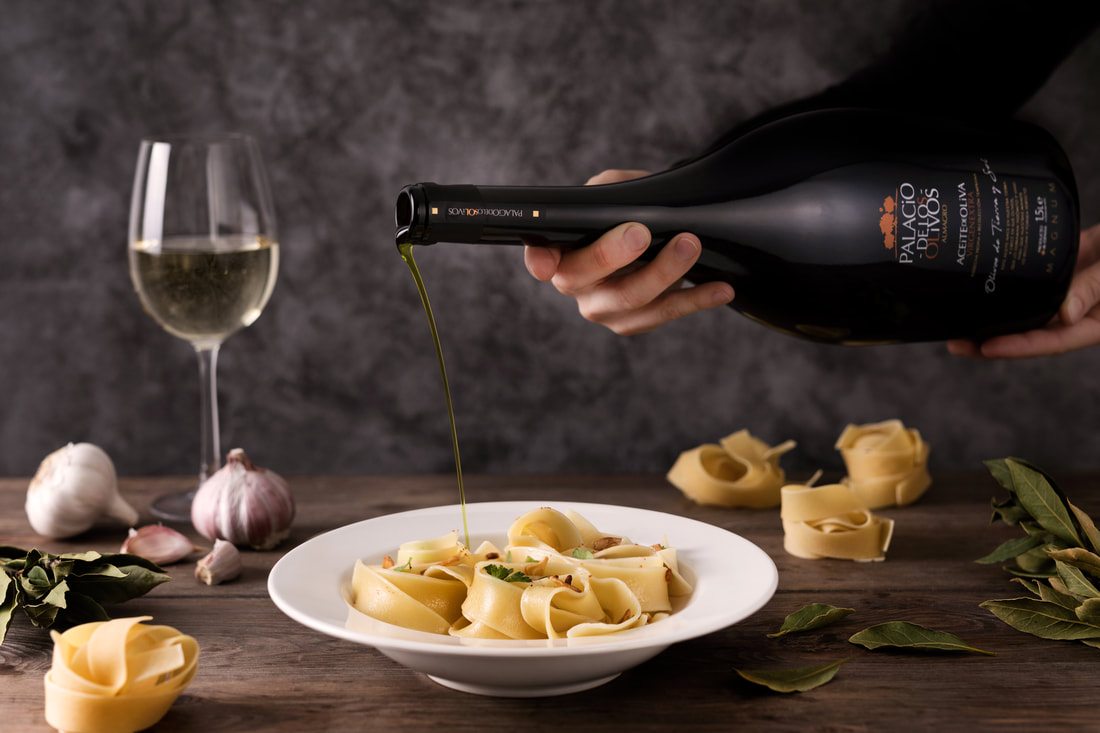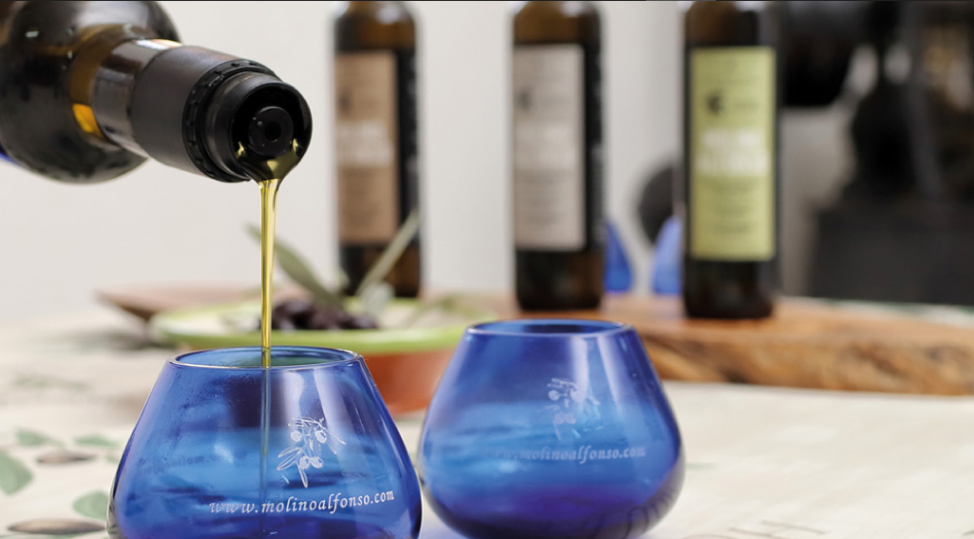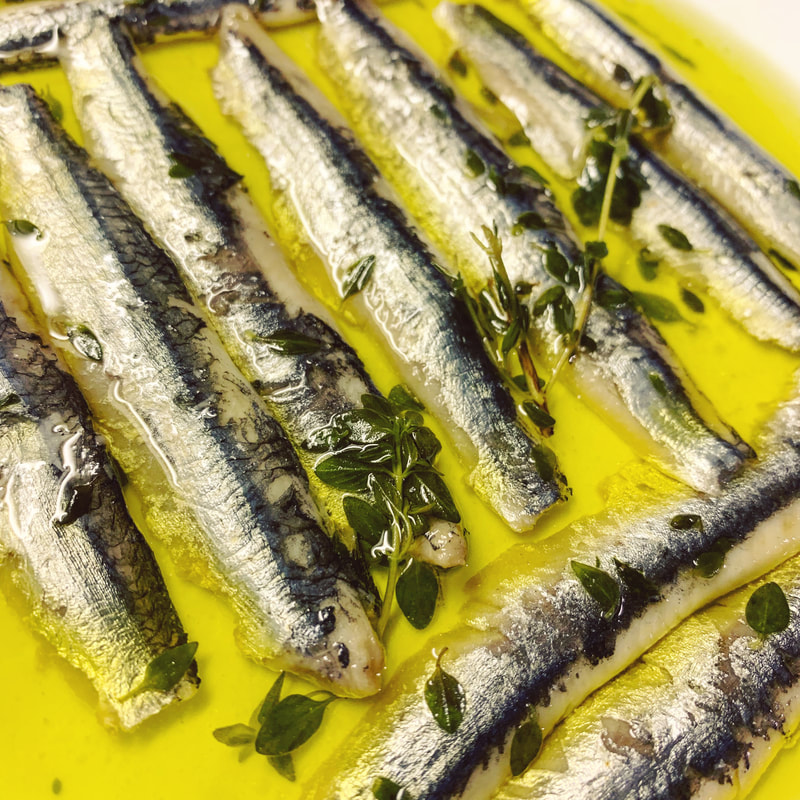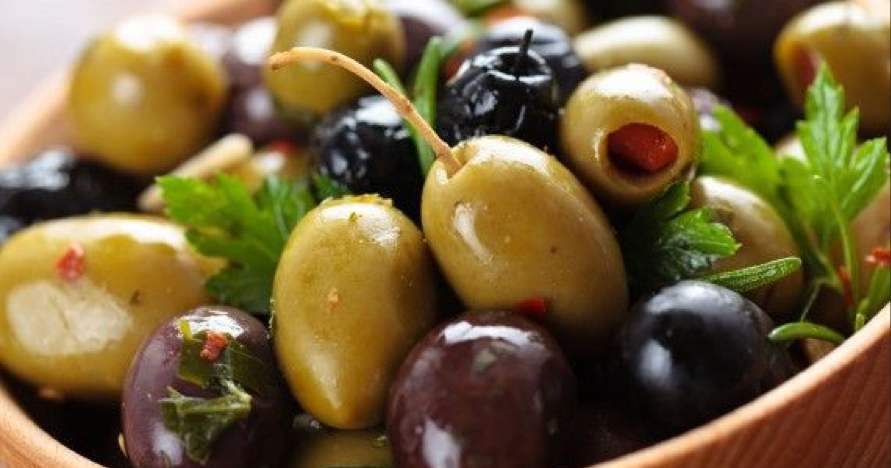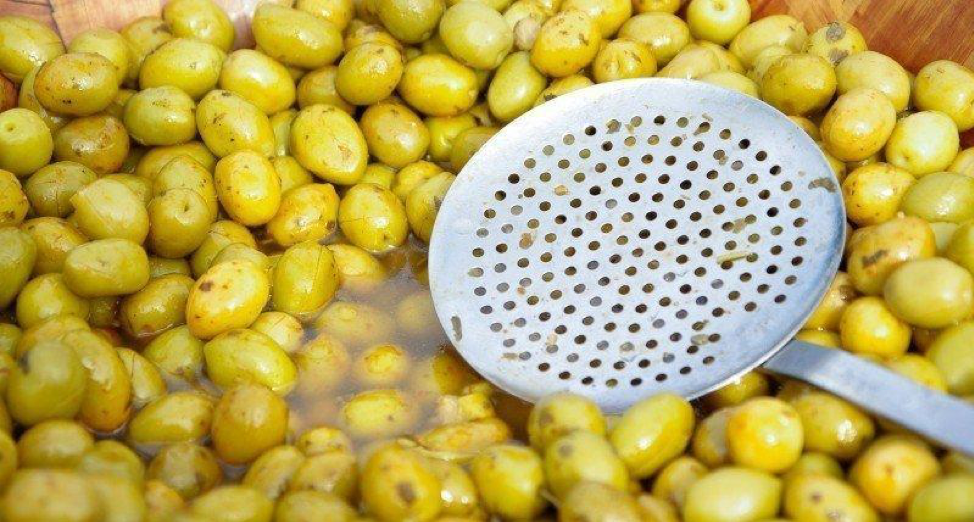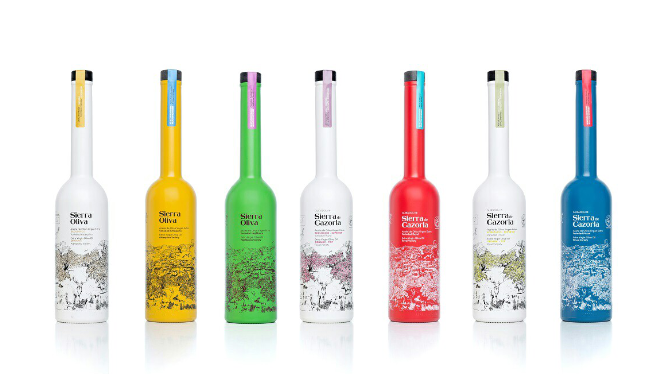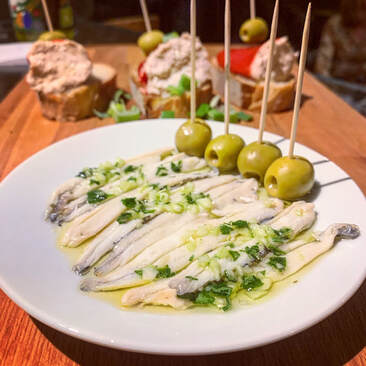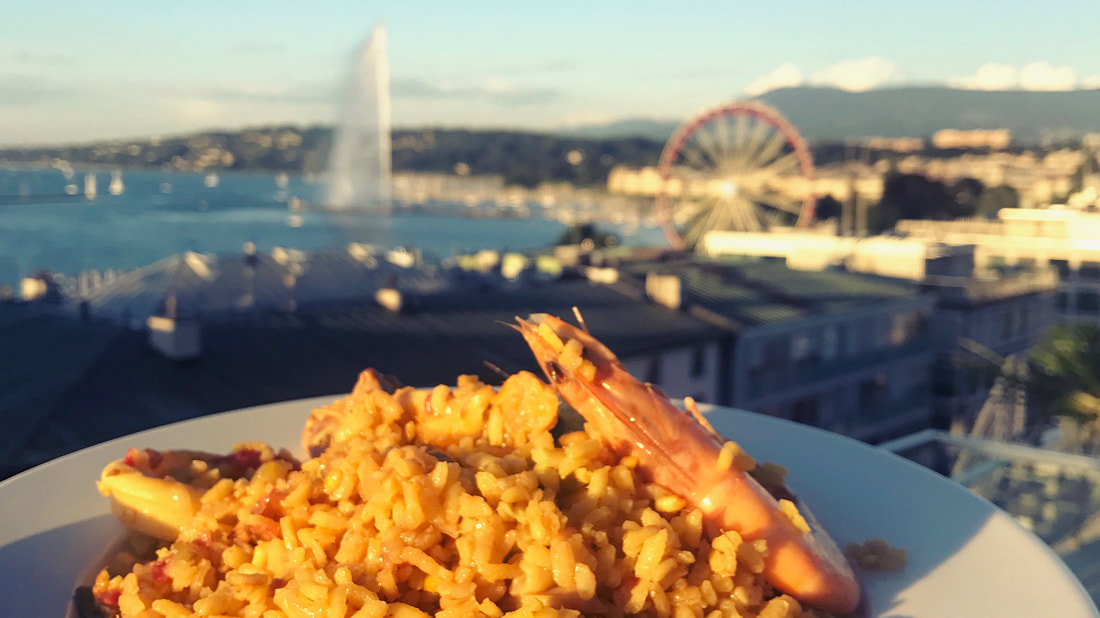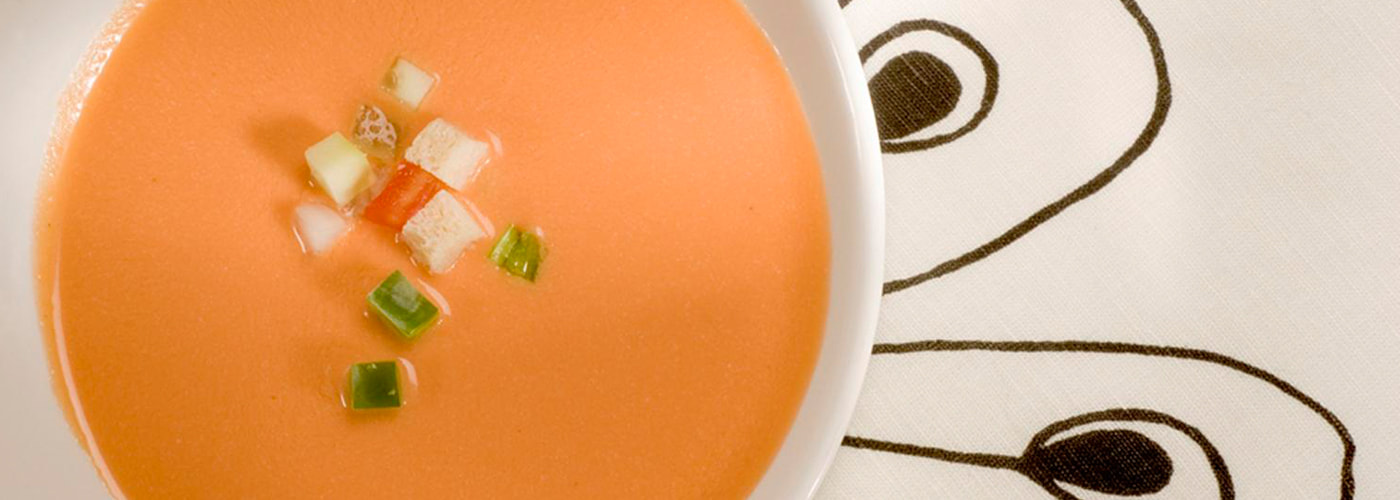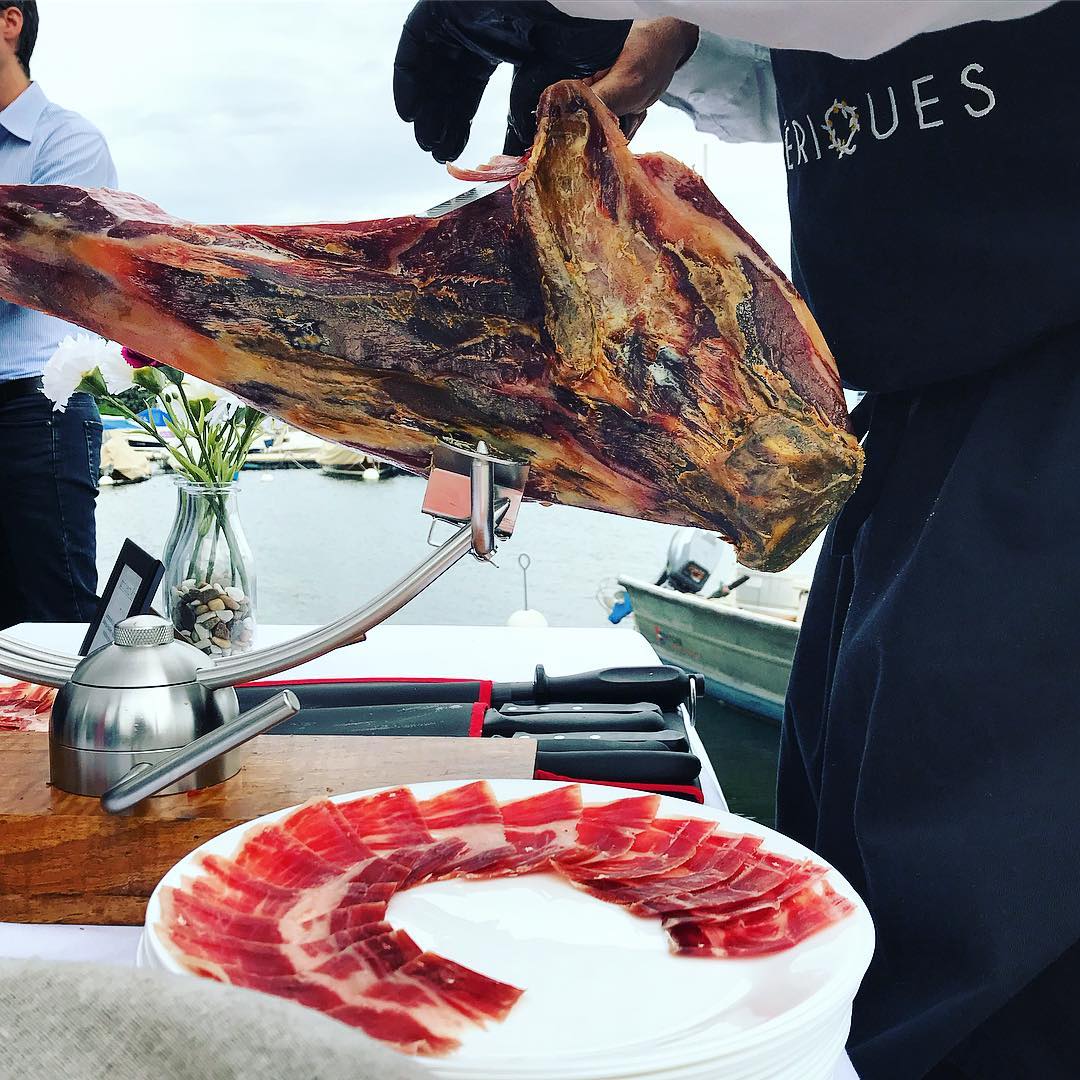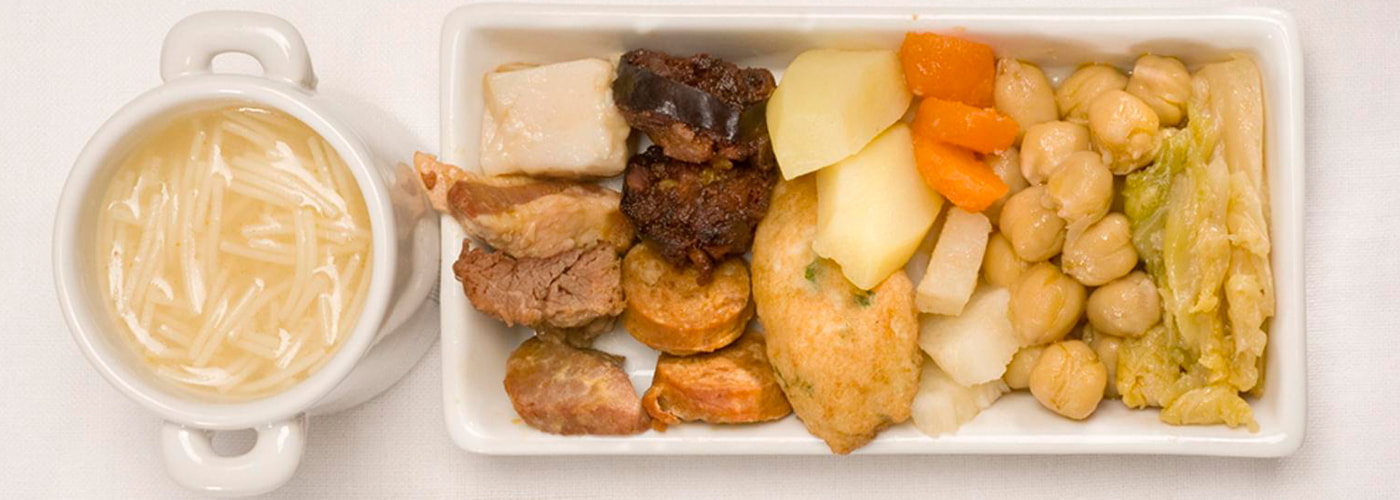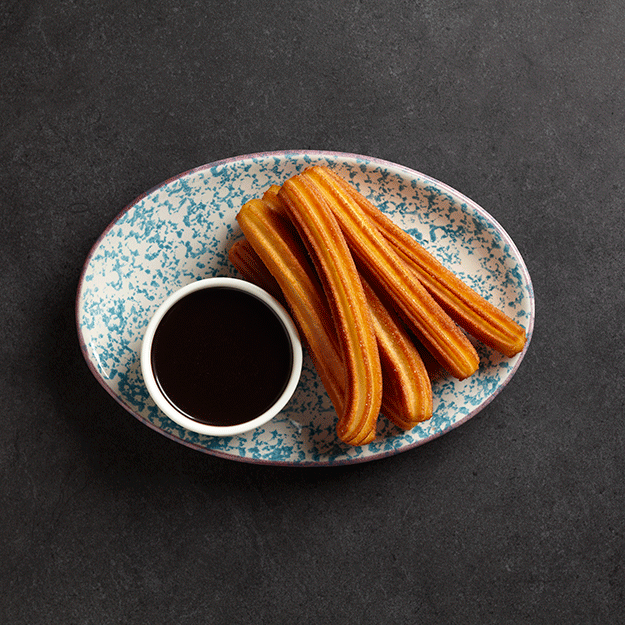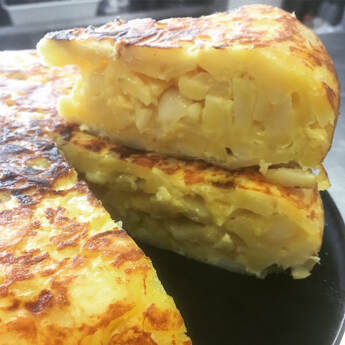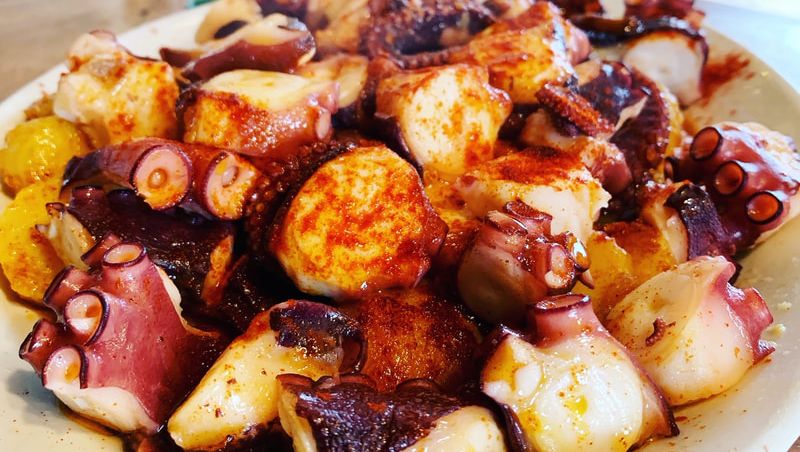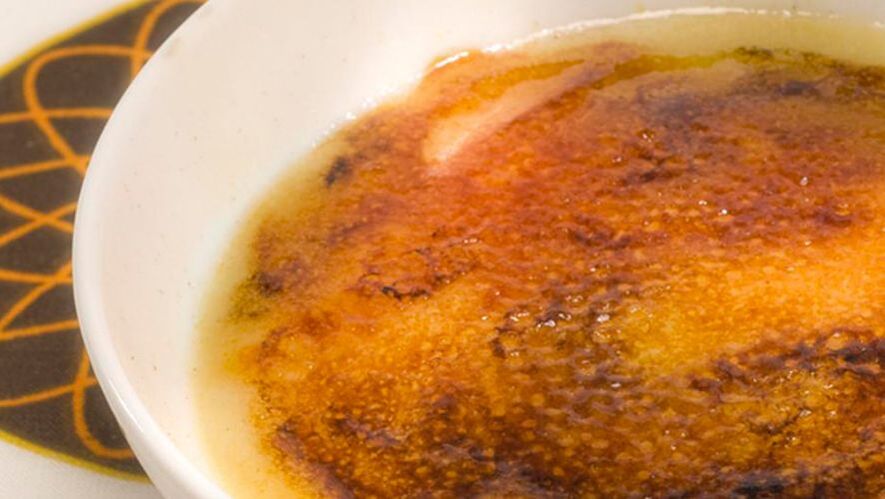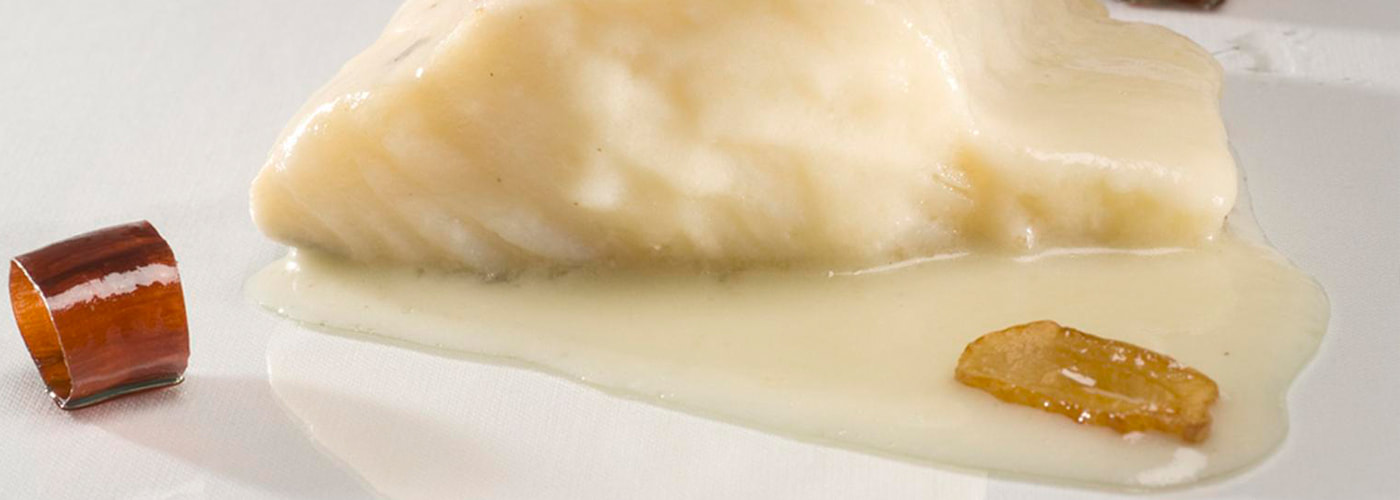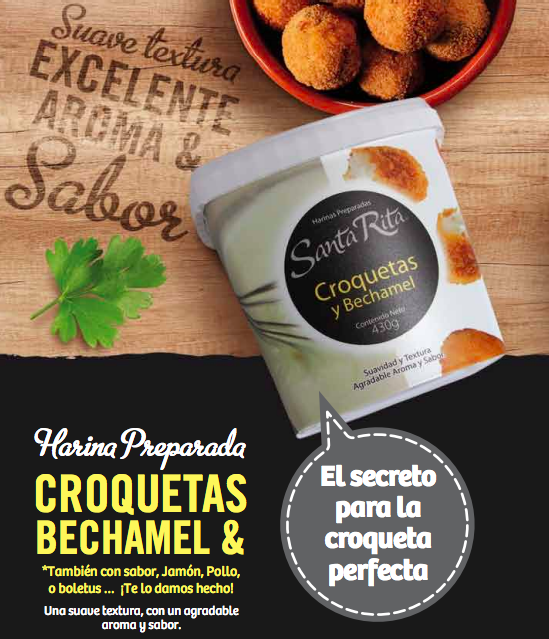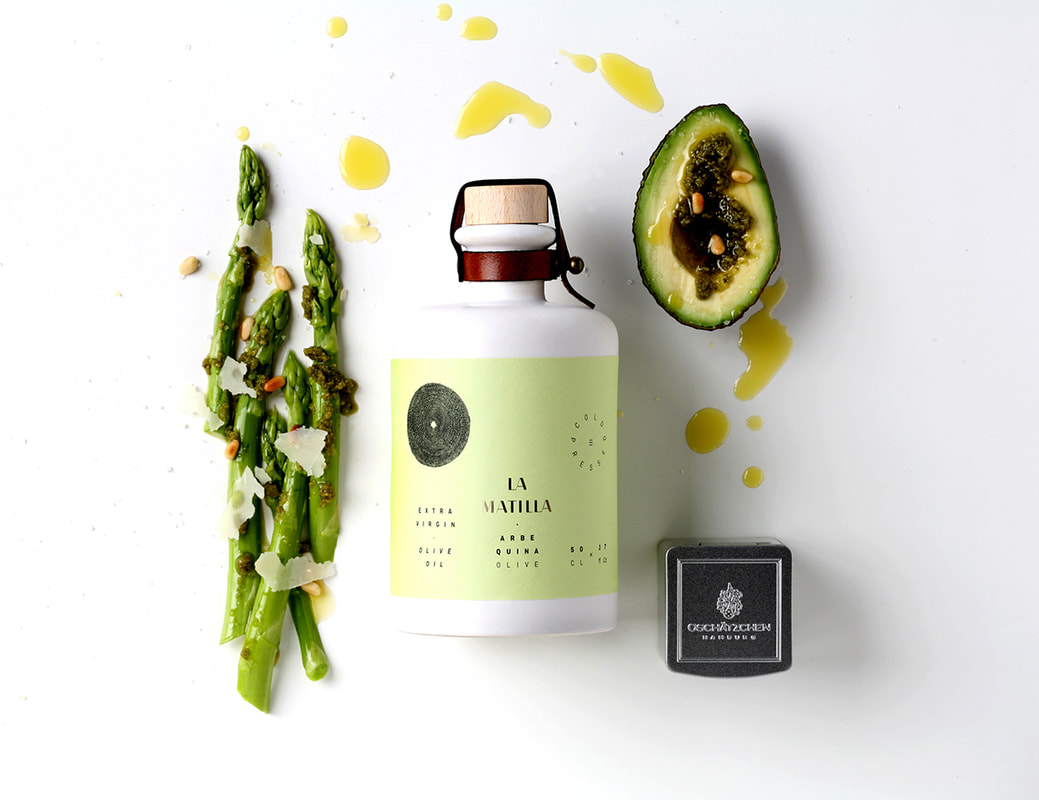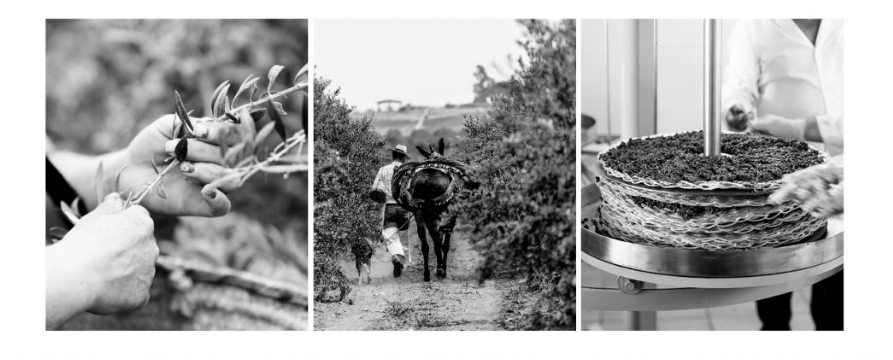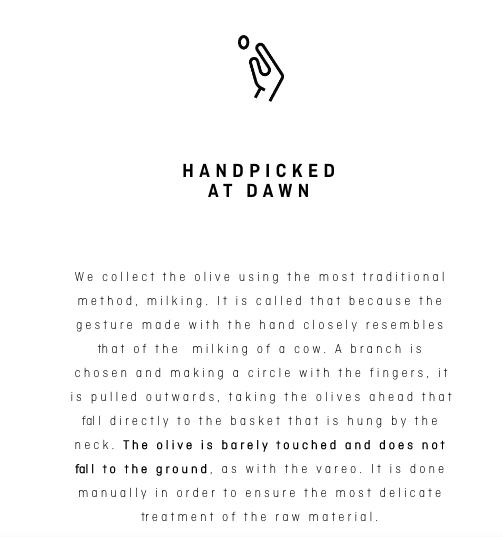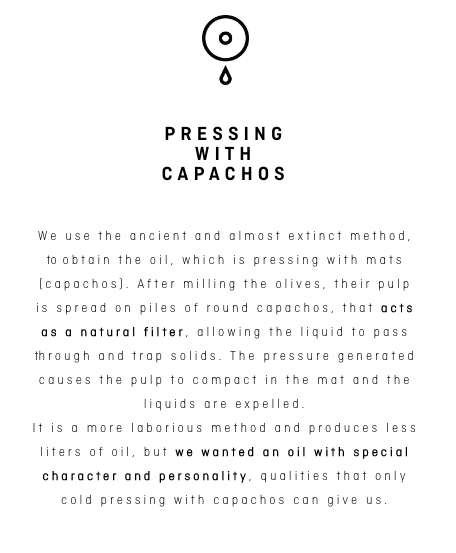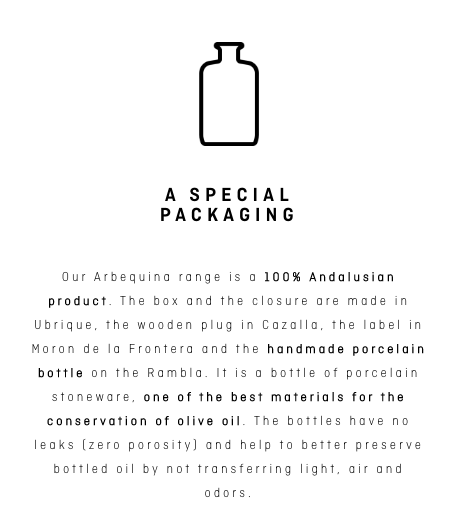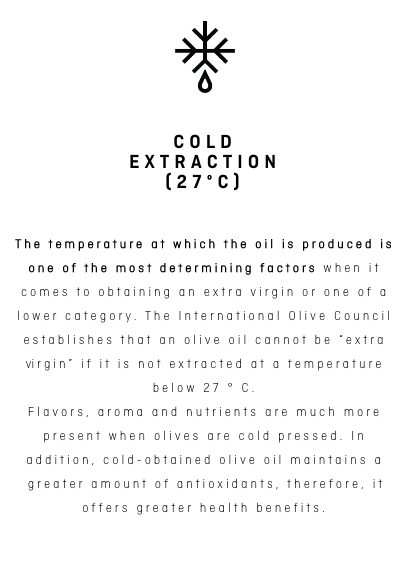Ingrédients pour 4 personnes.• 400g. de riz bomba, sénia ou albufera • 700g. de galeras (ou bien langoustines, gambas blanches, homard...) • 2 grandes cuillères de sauce tomate (tomate frito) • 400g. d'asperges vertes • 2 gousses d'ail • 30g. de salmorreta (épices pour paella) • 100ml. d'huile d'olive • Sel • 0,5g. du safran (facultatif) • 1,4 litres de bouillon de poisson (Caldo de caldero concentré 1:3) Étapes: sofrito, bouillon, cuisson du riz et décoration.1. Préparez les fruits de mer : Lavez bien les galeras, séparez les têtes des queues. Rincez les asperges et réservez la partie haute pour la décoration. 2. Faites revenir les légumes : Pelez et hachez l'ail. Faites revenir les tiges des asperges avec les têtes des galeras, tout dans une poêle avec de l'huile d'olive jusqu'à ce qu'ils soient bien dorés. Ajoutez le sel. 3. Ajoutez les queues de galeras et laisser cuire dans les huiles pendant 2 minutes de chaque côté. Réservez. 4. Ajoutez le "sabor": le "tomate frito" et la salmorreta, et remuez bien. Laissez cuire pendant quelques minutes. 5. Préparation du bouillon : vous devez obtenir un total de 1,4 litres en mélangeant le concentré (caldo de caldero) et de l'eau (1:3 proportion). Ajoutez le bouillon (1,4 litres) dans la poêle et remuez bien pour que tous les saveurs se mélangent. Laissez cuire pendant 15 minutes. Filtrez le bouillon dans une casserole, retirez les têtes de galeras et réservez. Vous obtiendrez 1,2 litres approximativement. 6. Le riz: ajoutez le riz (400g.) dans la poêle et remuez bien pour qu'il s'imprègne de la saveur des asperges. Ajoutez le bouillon jusqu'à ce que le riz soit recouvert et laissez cuire à feu moyen pendant environ 18 minutes. Goûtez et rajoutez du sel si besoin. 7. Ajoutez les queues de galeras et les têtes d'asperges: Vous devez ajouter tous les deux avant que le riz soit complètement cuit. Nous vous conseillons 3 minutes avant (à min. 15 de cuisson). Laissez le riz finir de cuire et absorber toute la saveur des fruits de mer. 8. Reposar : Retirez du feu et laissez reposer la paella pendant 5 - 8 minutes avant de servir. LE SITE WEB DE LA PAELLA. ACHETEZ VOS INGRÉDIENTS EN LIGNE ET FAITES VOUS LES LIVRER À DOMICILE.Buen provecho!!
0 Commentaires
Where to find black truffles in Switzerland? Chefs and individuals can have it delivered in 24 hours1/30/2023
The black truffle is one of nature's hidden gems, the discovery and enjoyment of which is reserved for just a few privileged souls. Its harvest, between November and March, requires patience, knowledge and passion, virtues that transform truffle growers into alchemists of the territory, owners of the best-kept secret. Countless sybarites and pleasure lovers have echoed the virtues of truffles. They're considered a living gastronomical legend given their rarity and exquisite nature. Their unique flavor make this product a veritable gift for the palate, putting it at the pinnacle of haute cuisine as one of its most valuable gems. BUT... did you know that 60% of the whole World's production of tuber melanosporum comes from Spain? This is the richest and most expensive black truffle, the authentic. A remarkably 80% of this Spanish production in Aragón is exported and sold to Périgord négociants in France every week, from early December until the end of Mars. [ES] Sabías que el 60% mundial de la trufa negra auténtica, la tuber melanosporum, se recolecta en España? Y que el 80% de esta producción es comprada por comerciantes franceses del Périgord cada semana? This might be of your interest: At LES IBERIQUES we do a weekly sale during the season, in Switzerland. You can contact us before Tuesdays at 12h00 to be taken in account for deliveries all Switzerland (express 24h) from our cave in Geneva. Who can buy? The market is open to both, general public and professionals. Price and minimum quantity orders to be settled weekly. Text: foodsandwinesfromspain.comSpanische Oliven & ein Gläschen Wermut und der Aperitivo versetzt Sie sofort in Ferienstimmung!5/16/2022
Im Artikel: ein Rezept für Gildas, die spanischen Oliven-Tapas mit dem ganz besonderen Geschmack.
Spanische Oliven zählen zu den bekanntesten Produkten des Landes. Die edle und gesunde Frucht hält in vielerlei Formen Einzug in unsere Küchen. Aber besonders beliebt sind Oliven-Tapas bei einem geselligen Aperitivo, der das iberische Lebensgefühl zu uns bringt. In diesem Artikel erfahren Sie alles, was Sie über spanische Oliven wissen müssen und wie Sie Freunde und Familie mit einem perfekten iberischen Aperitivo und Oliven-Tapas überraschen können. Entdecken Sie auch unser Rezept, um leckere Gildas auf Ihren Aperitivo-Tisch zu zaubern. Also ab in die Küche und „Arriba, abajo, al centro, adentro“! Die unglaubliche spanische Olivenvielfalt
Oliven gehören zu den beliebtesten Produkten aus Spanien. Nicht nur das gesunde spanische Olivenöl, das die Grundlage für die mediterrane Ernährung bildet, ist auf der ganzen Welt sehr gefragt, sondern auch spanische Tapas-Oliven, die das ganz besondere iberische Ferienfeeling zu Ihnen nachhause bringen.
Wussten Sie schon, dass Spanien weltweit der wichtigste Produzent für Tafeloliven ist? Kein Wunder, denn es ist auch das Land mit der grössten Olivenabaufläche (über 2 Millionen Hektare) und Sortenvielfalt – rund 260 verschiedene Olivensorten in unterschiedlichen Grössen, Formen, Farben und Geschmacksrichtungen sind in Spanien heimisch. Der Olivenanbau geht auf das 4. Jahrhundert v. Chr. zurück und die heutigen spanischen Olivensorten haben sich seit dem 15. Jahrhundert kaum verändert. Spanien ist aufgrund seiner geografischen Lage und klimatischen Bedingungen besonders gut für den Olivenanbau geeignet. Je nach Boden und Klimabedingungen, die von Region zu Region unterschiedlich sind, entstanden über die Jahrhunderte hinweg unterschiedliche spanische Olivensorten. Gewisse spanische Olivensorten werden nur zur Ölgewinnung verwendet, andere nur als Tafeloliven – einige eignen sich für beides. Eine besonders beliebte Olivensorte aus Spanien sind die Gordal-Oliven („fette Oliven“). Diese sonnenverwöhnte Olive aus Sevilla ist besonders gross und zeichnet sich durch ihr knackiges Fruchtfleisch aus. Ein ideales Häppchen, zum Beispiel als gefüllte OIiven mit Frischkäse, für eine gemütliche Aperitivo-Runde. Oliven und Geselligkeit – typisch spanisch!
Spanien ist aber nicht nur für seine Oliven bekannt, sondern auch für das spanische Lebensgefühl. So ist Geselligkeit in Spanien tief verwurzelt. Die Spanier kümmern sich umeinander und der gesellschaftliche Austausch ist wichtig. Besonders das Zusammengehörigkeitsgefühl in der Familie ist wichtig. Und wo spürt man dieses ganz besonders? Ja natürlich, wenn man am Tisch zusammenkommt und spanische Köstlichkeiten geniesst. Freunde sind auch oft mit am Tisch und da Gastfreundschaft in Spanien grossgeschrieben wird, kommt ein Aperitivo immer gelegen. Passendend dazu werden Tapas wie spanische Oliven mit Sardellen, Oliven mit Frischkäsefüllung oder auch Fleischbällchen serviert.
Haben Sie Lust auf eine Reise nach Spanien bekommen? Wenn gerade keine Ferien anstehen, dann unternehmen Sie doch einfach eine kulinarische Reise auf die iberische Halbinsel und laden Sie Freunde und Familie zu einem geselligen Tapas-Aperitivo mit spanischen Oliven und anderen Köstlichkeiten ein! Oliven-Tapas und spanischer Aperitivo
Wer schon einmal in Spanien in den Ferien war, kennt sie, die Tapas, die man hier so gerne verspeist. Und für alle anderen erklären wir gerne gleich, was es mit den spanischen Tapas auf sich hat. Und zwar handelt es sich um kleine Appetithäppchen (Fleischbällchen, Fischbällchen, Kartoffelwürfel, Käse und eben auch Oliven), die ursprünglich als „Merienda“ serviert wurden. Diese Mahlzeit entspricht in etwa unserem „Zvieri“, aber mit einer kleinen zeitlichen Verschiebung: So wird in Spanien die Zwischenmahlzeit, die die lange Pause zwischen dem Mittag- und Abendessen überbrücken soll, gegen 18:00 Uhr serviert, denn das Abendessen folgt oft erst gegen 22:00 Uhr.
Für Mitteleuropäer sind Tapas daher ideal für einen Apéro, den wir gerne vor dem nicht ganz so späten Abendessen geniessen – oder je nach Anlass auch den ganzen Tag über. Ein geselliger Aperitivo kommt doch immer gelegen, oder? Übrigens, um Sie vollständig in die Welt der spanischen Appetithäppchen einzuführen: Wenn die Tapas aufgespiesst und an einem Zahnstocher gereicht werden, dann nennt man sie Pinchos. Zu einem richtig feinen Aperitivo mit spanischem Flair gehören also auf jeden Fall würzige Oliven und ein natürlich ein passendes Apéro-Getränk. Spanien-Kenner schwören dabei auf Sherry, Wermut oder ein kühles spanisches Bier (Cerveza). Für Kinder und alle, die noch fahren müssen, kann man mit spanischen Fruchtsäften und Sodas nichts verkehrt machen. So kann der spanische Abend gebührend eingeläutet werden. Und wie wäre es nach dem Aperitivo noch mit einer spanischen Paella, einem Cocido Madrileño, einer asturischen Fabada, einer Gazpacho oder Salmorejo oder einer Tortilla? Die spanische Küche hat so viele Köstlichkeiten zu bieten, dass der Abend eigentlich gar nicht lange genug werden kann. Wir präsentieren … die spanischen Gildas!
Wenn Sie Gildas noch nicht kennen, dann ist nun höchste Zeit dafür!
Bei diesem spanischen Apéro-Häppchen werden je eine Olive, eine Sardelle (Anchoa oder Boqueron) und ein kleiner Chili (Piparra), zusammen auf einen Zahnstocher gespiesst. Ein Genuss fürs Auge und für den Gaumen! Man munkelt, dass dieses Rezept aus einer Bar aus San Sebastián stammt. Der Besitzer dieser traditionellen Taverne soll nämlich jeweils seinen Gästen Oliven, Fisch und Chili serviert haben, wenn sie ein Glas Wein oder Wermut bestellten. Als einer seiner Gäste die Idee hatte, diese Zutaten auf einem Zahnstocher aufzuspiessen, war dieser klassische Pincho geboren. Benannt soll das Apéro-Spiessli mit spanischen Oliven mit Sardellen nach dem gleichnamigen Kultfilm mit Rita Hayworth aus den 1950-er Jahren sein.
So oder so, Gildas schmecken auch heute noch ausgezeichnet zu einem Glas Wermut. Die Kombination aus Oliven, Fisch und Chili sorgt für einen frischen und scharfen kulinarischen Kick, den man immer wieder neu erleben möchte – für Nachschub sollte also auf jeden Fall gesorgt sein!
Überzeugen Sie sich selbst und probieren Sie unser Schritt-für-Rezept für spanische Gildas aus: Einkaufsliste für Gilda-Pinchos:
Natürlich können Sie die Pinchos nach Belieben auch noch mit anderen Zutaten verfeinern. Wie so oft hat jeder Tapas-Koch seine ganz eigenen Rezeptvariationen. So sieht man sieht auch öfter Gildas mit Cornichon-Stücken, die nochmals eine frische und säuerliche Note zur Gilda hinzubringen. Probieren Sie es aus – Ihrer Fantasie sind keine Grenzen gesetzt, um Ihre Gästen mit einem unvergesslichen Tapas-Aperitivo mit spanischen Oliven zu verwöhnen. Wir wünschen Ihnen schon jetzt viel Spass auf Ihrer kulinarischen und geselligen Reise durch die spanische Ess- und Aperitivo-Kultur. Alle Zutaten finden Sie bei Les Iberiques, Ihrem Spezialisten für spanische Delikatessen – die gute Laune und die Ferienstimmung kommen dabei ganz von selbst auf. LA PAELLA |
| Specific ingredients you must have to succeed: - Natural saffron thread - Extra virgin olive oil - Salmorreta (optional) extra punch of flavour - PImentón de la Vera - Meat and vegetable broth INGREDIENTS (4-5 servings) - WHAT YOU NEED 👀👇🏻 450 g bomba rice 1,5 litre of vegetable and chicken / meat broth 1 big onion (optional, chopped) 2 garlic cloves (peeled, not sliced) 3 big red tomatoes 300g. of green beans 100g. of garrofó white beans (optional) 5 artichokes (optional) 800g. of fresh chicken 400g. of fresh rabbit (optional) 0,5g. of natural saffron 30g. of salmorreta seasoning (optional) 150ml extra virgin olive oil EVOO Pimentón de la Vera (mild) Salt |
PREPARATION (EN)
In a pot, heat the broth with x3 parts of water (100ºC).
In a paella pan with the olive oil you have to cook the meat (well done) at mid-high power and reserve it in a plate, it will take 12-15 minutes.
Then add the onions and garlic, cook well in the flavoured olive oil.
Add some salt and the chopped tomatoes. Stir and cook well until the vegetables leave all the juice.
Add the salmorreta and pimentón, stir well during 2 minutes and add the garrofó beans.
Add the 1,5 L. broth and stir to stick off the vegetables and flavour from the pan.
After 3-4 minutes, at max power, should be boiling, then add the saffron and mix well.
Add the rice and spread well over the whole surface.
Leave it at max power for 6 minutes. Then lower the power to 60% and leave 8 more minutes.
After that the rice should have absorbed 90% of the broth.
Put the chicken back over the rice, also some rosemary if you'd like the touch.
Then raise the power to 100% for 3 minutes and then turn it off.
Put a cloth over the pan and leave 8 more minutes to settle the rice.
Ready to eat!!
BUEN PROVECHO!! 🤘🏻🥘
In a pot, heat the broth with x3 parts of water (100ºC).
In a paella pan with the olive oil you have to cook the meat (well done) at mid-high power and reserve it in a plate, it will take 12-15 minutes.
Then add the onions and garlic, cook well in the flavoured olive oil.
Add some salt and the chopped tomatoes. Stir and cook well until the vegetables leave all the juice.
Add the salmorreta and pimentón, stir well during 2 minutes and add the garrofó beans.
Add the 1,5 L. broth and stir to stick off the vegetables and flavour from the pan.
After 3-4 minutes, at max power, should be boiling, then add the saffron and mix well.
Add the rice and spread well over the whole surface.
Leave it at max power for 6 minutes. Then lower the power to 60% and leave 8 more minutes.
After that the rice should have absorbed 90% of the broth.
Put the chicken back over the rice, also some rosemary if you'd like the touch.
Then raise the power to 100% for 3 minutes and then turn it off.
Put a cloth over the pan and leave 8 more minutes to settle the rice.
Ready to eat!!
BUEN PROVECHO!! 🤘🏻🥘
Les feuilles et le cœur d’artichaut offrent des saveurs uniques, de quoi ravir les grands comme les plus petits ! Pourtant, ce légume (ou plutôt cette plante) est trop souvent associé à une simple entrée servie avec sa vinaigrette. Recettes, astuces de préparation, différentes variétés d’artichauts… Vous souhaitez surprendre vos convives en mêlant saveurs, aliments healthy et originalité ? Préparez-vous, la suite de cet article éveillera vos papilles!
Les feuilles et le cœur d’artichaut en quelques mots
Un parfait allié pour votre santé
Avant d’évoquer les meilleures recettes associées aux artichauts, intéressons-nous à leur origine souvent méconnue. Cultivée en région méditerranéenne, cette plante représente un apport calorique faible (comptez environ 50 kcal pour 100 grammes). Autrement dit, l’artichaut à tout à fait sa place dans un régime minceur, mais aussi dans des plats plus « généreux ».
En ce qui concerne son apport nutritionnel, l’artichaut possède tout de même 4 g de protéines et environ 380 mg de potassium pour 100 g de légume. En considérant également sa teneur en magnésium, vitamine C et en calcium, ce légume est un choix idéal pour préserver votre bien-être sans risquer la prise de quelques kilos !
Notez par ailleurs que l’artichaut contient de l’inuline qui à l’instar de l’huile d’olive agit comme un véritable coupe-faim. Pour faire baisser les chiffres sur votre balance, n’hésitez pas donc à consommer les artichauts de Murcia à l’huile d’olive.
En ce qui concerne son apport nutritionnel, l’artichaut possède tout de même 4 g de protéines et environ 380 mg de potassium pour 100 g de légume. En considérant également sa teneur en magnésium, vitamine C et en calcium, ce légume est un choix idéal pour préserver votre bien-être sans risquer la prise de quelques kilos !
Notez par ailleurs que l’artichaut contient de l’inuline qui à l’instar de l’huile d’olive agit comme un véritable coupe-faim. Pour faire baisser les chiffres sur votre balance, n’hésitez pas donc à consommer les artichauts de Murcia à l’huile d’olive.
Pourquoi opter pour les Artichauts confits de Murcia à l’huile d’olive ?
Voici 3 bonnes raisons d’adopter les artichauts de Murcia à l’huile d’olive dans votre régime alimentaire:
Des artichauts provenant de la région de Murcia en Espagne
Avec 208 463 tonnes de production annuelle, l’Espagne est le deuxième pays européen producteur d’artichauts après l’Italie. Parmi les régions espagnoles, c’est à Murcia qu’a lieu la plus grande production d’artichauts. Il faut dire que cette région bénéficie d’un climat particulièrement favorable à la croissance des artichauts. D’ailleurs, cette région est réputée pour la qualité de ses artichauts.
Des artichauts confits dans l’huile d’olive extra-vierge
Ces artichauts sont confits dans de l’huile d’olive extra-vierge. Cela signifie que l’huile utilisée est obtenue par voie mécanique et que le taux d’acidité ne dépasse pas 0,8%. Ainsi, il s’agit d’un produit qui conserve tout son intérêt nutritionnel.
Sans parler des propriétés antioxydantes et anti-inflammatoires de l’huile d’olive extra-vierge sur la santé.
Sans parler des propriétés antioxydantes et anti-inflammatoires de l’huile d’olive extra-vierge sur la santé.
Des ingrédients 100% naturels
À l’instar de tous les produits de Caprichos del Paladar, la qualité est au rendez-vous avec les artichauts de Murcia à l’huile d’olive. Entre autres, ils ont été formulés sans colorants ni additifs. Par ailleurs, ils ont été récoltés le même jour que leur conditionnement. Vous pouvez ainsi les consommer tout en sachant qu’ils ne seront pas nocifs pour votre santé.
Les différentes variétés d’artichauts
Si l’artichaut vert est la variété la plus populaire de ce légume, d’autres plantes sont également proposées pour composer de savoureux plats. Citons, par exemple, les artichauts violets de Catanais ou de Toscane, les grands artichauts de variété Tudela en provenance de Navarra au Nord d'Espagne, mais aussi cultivés tout au long de la Méditerranée. D’autres variétés blanches telles que le Camus ou encore le blanc Hyérois ne manqueront pas de surprendre votre famille ou vos convives.
Attention : selon sa variété, un artichaut pourra être consommé cru ou cuit. Prenez soin de vérifier cette caractéristique avant de préparer votre prochain plat!
Attention : selon sa variété, un artichaut pourra être consommé cru ou cuit. Prenez soin de vérifier cette caractéristique avant de préparer votre prochain plat!
Quelques recettes savoureuses pour les grands et les petits
Venus des régions méditerranéennes, l’artichaut apporte le soleil dans votre assiette lors d’un apéritif entre amis ou en tant qu’entrée savoureuse. Voici une sélection de recettes testées et approuvées par les grands et les plus petits!
En apéritif
Cœur d’artichaut en salade (vinaigrette au citron)
Quels ingrédients ?
La cuisson des artichauts est nécessaire après les avoir tournés (comptez environ 40 minutes pour ces étapes). Prenez un mélange de jus de citron, de persil, d’huile d’olive avec du sel et poivre, puis versez avec modération cette préparation sur chaque cœur d’artichaut cuit. Terminez avec quelques pincées de persil ciselé… Et vous voilà prêt pour savourer un instant de bonheur avec vos convives sous un magnifique soleil. Bien entendu, si la météo n’est pas au rendez-vous, cette entrée pourra ravir vos papilles !
- Artichauts (peu importe la variété)
- Quelques zestes de citron
- 2 c.a.s d’huile d’olive
- Quelques branches de persil
- Sel et poivre
- 10 minutes de préparation / 30 minutes de cuisson
La cuisson des artichauts est nécessaire après les avoir tournés (comptez environ 40 minutes pour ces étapes). Prenez un mélange de jus de citron, de persil, d’huile d’olive avec du sel et poivre, puis versez avec modération cette préparation sur chaque cœur d’artichaut cuit. Terminez avec quelques pincées de persil ciselé… Et vous voilà prêt pour savourer un instant de bonheur avec vos convives sous un magnifique soleil. Bien entendu, si la météo n’est pas au rendez-vous, cette entrée pourra ravir vos papilles !
La tapenade d’artichauts
Quels ingrédients ?
La recette est simple : faites cuire vos artichauts après les avoir tournés (environ 10 minutes), puis hachez et mélangez les ingrédients précédemment cités. Ajoutez du persil, mixez le tout, et le tour est joué ! Pourquoi compliquer une recette lorsqu’un plat peut être simple et incroyablement savoureux ?
- Artichauts (frais ou en conserve)
- Quelques zestes de citron
- 1 c.a.s d’huile d’olive
- 2 gousses d’ail (à dégermer)
- Quelques branches de persil
- Sel et poivre
- 10 à 15 minutes de préparation et cuisson
La recette est simple : faites cuire vos artichauts après les avoir tournés (environ 10 minutes), puis hachez et mélangez les ingrédients précédemment cités. Ajoutez du persil, mixez le tout, et le tour est joué ! Pourquoi compliquer une recette lorsqu’un plat peut être simple et incroyablement savoureux ?
Les antipastis à base de cœurs d’artichauts
Les antipastis permettent de laisser libre cours à la créativité. À ce titre, le cœur d’artichaut est un aliment de premier choix pour surprendre vos convives. Selon la variété de ce légume, il est tout à fait possible de le servir froid avec de belles olives farcies, du jambon de Parme ou encore de belles tomates fraîchement découpées. Munissez-vous de quelques piques, faîtes le plein d’idées et laissez exprimer votre créativité avec plaisir!
En plat principal
La quiche aux artichauts
Quels ingrédients ?
- Artichauts (frais ou en conserve)
- Une pâte feuilletée maison ou préparée
- 25 cl de crème fluide
- 2 œufs
- 1 c.a.s de moutarde
- 1 oignon jaune
- 75g de gruyère
- Sel et poivre
- 15 minutes de préparation / 30 minutes de cuisson
Les pastas aux artichauts et parmesan
Quels ingrédients ?
- 5 cœurs d’artichauts
- 300g de pâtes (macaronis, pennes…)
- 1 gousse d’ail (à dégermer)
- 125g de parmesan en copeaux
- 1 c.a.s d’huile d’olive
- Quelques branches de persil
- Sel et poivre
- 10 à 15 minutes de préparation / 10 minutes de cuisson (al dente)
Velouté à l’artichaut
Quels ingrédients ?
- 5 artichauts
- Le zeste d’un demi-citron
- Environ 1L de bouillon de légumes
- 30 cl de crème fluide
- Sel et poivre
- 25 minutes de préparation / 1h30 minutes de cuisson
Et la liste est longue
Artichauts grillés à l’huile, pizza aux artichauts… Ce légume peut être intégré dans de nombreux plats revisités. Libre à vous d’essayer les recettes qui vous inspirent le plus pour partager des repas mémorables en famille.
Artichauts confits de Caprichos del Paladar, préparés "à l'espagnole" par l'influenceuse Rocío Egío, à Lausanne.
Préparer les artichauts comme un chef
Et comment cuisinent les chefs les artichauts ? Voyez comment les professionnels de "Caprichos del Paladar" préparent les légumes:
Tourner un artichaut
Tourner un artichaut, c’est le préparer pour la cuisson. Si vous n’êtes pas un professionnel ou si ce légume ne vous est pas familier, vous pourriez rencontrer des difficultés lors de cette préparation. Voici les étapes à suivre :
- Tout d’abord, assurez-vous de la propreté de votre légume (passez-le rapidement sous l’eau de votre robinet si cela s’avère nécessaire).
- Coupez la queue de votre artichaut en pressant cette zone avec la paume de votre main. Veillez à laisser environ 4 cm de cette partie.
- Retirez les feuilles en commençant par la base du légume, puis remontez progressivement de quelques centimètres.
- Utilisez un couteau pour éplucher votre légume en utilisant une technique similaire à celle que vous pourriez utiliser pour les pommes de terre.
- Votre cœur d’artichaut est désormais prêt à passer en cuisson !
La cuisson des artichauts
La cuisson des artichauts est tout à fait possible sans avoir préalablement tourné vos légumes. Toutefois, le retrait des feuilles vous permettra de gagner un espace considérable au fond de votre casserole.
Le temps de cuisson des artichauts dépendra naturellement de leur taille. Ainsi, si les petits artichauts ne nécessitent que 15 minutes de cuisson, les plus gros gabarits nécessiteront parfois 30 à 40 minutes d’attente. Les temps de cuisson cités précédemment via nos recettes pourront donc varier selon vos produits. En cas de doute, n’hésitez pas à piquer vos cœurs d’artichauts afin de vérifier leur texture… Un artichaut trop cuit laissera rapidement une mauvaise impression auprès de vos convives !
Pas envie de cuisiner ? Pas problème ! Qu’attendez-vous pour commander vos artichauts de Murcia à l’huile d’olive ? Ces produits sont prêts à l’emploi. Après votre achat, il vous suffit de réchauffer vos artichauts, puis les savourer seuls ou avec vos plats préférés.
Le temps de cuisson des artichauts dépendra naturellement de leur taille. Ainsi, si les petits artichauts ne nécessitent que 15 minutes de cuisson, les plus gros gabarits nécessiteront parfois 30 à 40 minutes d’attente. Les temps de cuisson cités précédemment via nos recettes pourront donc varier selon vos produits. En cas de doute, n’hésitez pas à piquer vos cœurs d’artichauts afin de vérifier leur texture… Un artichaut trop cuit laissera rapidement une mauvaise impression auprès de vos convives !
Pas envie de cuisiner ? Pas problème ! Qu’attendez-vous pour commander vos artichauts de Murcia à l’huile d’olive ? Ces produits sont prêts à l’emploi. Après votre achat, il vous suffit de réchauffer vos artichauts, puis les savourer seuls ou avec vos plats préférés.
Arroz reis spanien 4 personnen cookware recette cooking online recipe switzerland schweiz suisse
3/21/2021
ARROZ - RIZ - RICE - REIS
Rice dishes are becoming more popular on menus, there are myriad different varieties in the stores and numerous recipes available because, as adepts of the culinary arts know well, rice “goes with everything”. It is unanimous: rice is in fashion and is making a comeback. Paella is now partnered by creamy rice, soupy rice dishes and risottos, and, it must be said, few of these dishes are cooked slowly any more, as the rice is toasted in butter to combine flavours.
The Senia and Bahía varieties have a composition that guarantees a creamy texture in the cooked grain, and complete absorption of flavors.
The Bomba variety gives grains that do not stick together after cooking, with a good consistency and complete absorption of flavors.
Seeds are sown directly, by hand or from the air. The depth of the water layer varies depending on weather conditions and crop development. Once or twice during the vegetative cycle, the fields are left dry for a few days to prevent algae formation. Centrifugal sowing machines are used, from late April to mid-May.
The rice is harvested using automatic harvesting machines from early September to early October. It is then dried in the sun or using hot air blowers. Cleaning, milling and packing are totally mechanized and take place throughout the year.
The Valencian Community has several natural wetlands (the largest being the Albufera) which have the right soil, floodability conditions and climate for rice production. On either side of the Júcar river and in the surroundings of the Albufera, soils are limey (30-50% carbonate), clayey, poor in organic matter and with a pH of 8-8.3.
The terrain is strong and not very permeable and offers ideal physical conditions for rice cultivation. The temperature, light and relative humidity of the production area are also optimal for rice cultivation, as shown in agronomic studies.
Rice dishes are becoming more popular on menus, there are myriad different varieties in the stores and numerous recipes available because, as adepts of the culinary arts know well, rice “goes with everything”. It is unanimous: rice is in fashion and is making a comeback. Paella is now partnered by creamy rice, soupy rice dishes and risottos, and, it must be said, few of these dishes are cooked slowly any more, as the rice is toasted in butter to combine flavours.
The Senia and Bahía varieties have a composition that guarantees a creamy texture in the cooked grain, and complete absorption of flavors.
The Bomba variety gives grains that do not stick together after cooking, with a good consistency and complete absorption of flavors.
Seeds are sown directly, by hand or from the air. The depth of the water layer varies depending on weather conditions and crop development. Once or twice during the vegetative cycle, the fields are left dry for a few days to prevent algae formation. Centrifugal sowing machines are used, from late April to mid-May.
The rice is harvested using automatic harvesting machines from early September to early October. It is then dried in the sun or using hot air blowers. Cleaning, milling and packing are totally mechanized and take place throughout the year.
The Valencian Community has several natural wetlands (the largest being the Albufera) which have the right soil, floodability conditions and climate for rice production. On either side of the Júcar river and in the surroundings of the Albufera, soils are limey (30-50% carbonate), clayey, poor in organic matter and with a pH of 8-8.3.
The terrain is strong and not very permeable and offers ideal physical conditions for rice cultivation. The temperature, light and relative humidity of the production area are also optimal for rice cultivation, as shown in agronomic studies.
How to cook a perfect Spanish rice recipe at home, electric stove suitable (vitro).
In fact, you can cook this recipe with any leftovers or random ingredients that you may find in your fridge or pantry.
You just need to pay attention and match flavours that go well together.
We found a fresh broccoli, tomatoes, some onions, garlic, eggs and frozen fishbone from a previous meal.
At the cupboard, some canned food from La Brújula producer, that preserve one of the best seafood we've ever tasted.
Specific ingredients you must have to succeed:
- Natural saffron thread
- Extra virgin olive oil
INGREDIENTS (4-5 servings) - WHAT YOU NEED 👀👇🏻:
The rice:
🦑
450 g bomba rice
1 litre of home made seafood broth
1 big onion (chopped)
2 garlic cloves (finely chopped)
2 red tomatoes
3 cans of chipirones from La Brújula
1 broccoli (boiled and cooled)
Pimentón de la Vera (mild)
Natural saffron
100ml extra virgin olive oil EVOO
Salt
Alioli Find here the easy recipe
1 egg
2 garlic cloves (without the inner part)
Salt
50ml extra virgin olive oil
50ml sunflower oil
Juice of 1/2 lemon
.
PREPARATION (EN)
In a pot, heat the broth (100ºC).
In a paella pan, put the olive oil and heat it to max power. Add the onions and garlic.
Brown them, add some salt and the chopped tomatoes. Stir and cook well until the vegetables leave all the juice.
Add the chipirones with all the content in the cans.
Add some more salt, pimentón de la vera and the saffron.
Stir well during 2 minutes and add the bomba rice.
You have to stir well the rice (fried in the juice) but avoid the bottom to get burned, be quick.
After 3-4 minutes, at max power, add the broth that should cover the whole surface. Mix well and leave at max power for 6 minutes. Then lower the power to 60% and leave 6 more minutes.
After that the rice should have absorbed 90% of the broth.
Then raise the power to 100% for 2 minutes and turn off.
Put the broccoli on the top of the rice.
Put a cloth over the pan and leave 8 more minutes to settle the rice.
Ready to eat!!
BUEN PROVECHO!! 🤘🏻🥘
You just need to pay attention and match flavours that go well together.
We found a fresh broccoli, tomatoes, some onions, garlic, eggs and frozen fishbone from a previous meal.
At the cupboard, some canned food from La Brújula producer, that preserve one of the best seafood we've ever tasted.
Specific ingredients you must have to succeed:
- Natural saffron thread
- Extra virgin olive oil
INGREDIENTS (4-5 servings) - WHAT YOU NEED 👀👇🏻:
The rice:
🦑
450 g bomba rice
1 litre of home made seafood broth
1 big onion (chopped)
2 garlic cloves (finely chopped)
2 red tomatoes
3 cans of chipirones from La Brújula
1 broccoli (boiled and cooled)
Pimentón de la Vera (mild)
Natural saffron
100ml extra virgin olive oil EVOO
Salt
Alioli Find here the easy recipe
1 egg
2 garlic cloves (without the inner part)
Salt
50ml extra virgin olive oil
50ml sunflower oil
Juice of 1/2 lemon
.
PREPARATION (EN)
In a pot, heat the broth (100ºC).
In a paella pan, put the olive oil and heat it to max power. Add the onions and garlic.
Brown them, add some salt and the chopped tomatoes. Stir and cook well until the vegetables leave all the juice.
Add the chipirones with all the content in the cans.
Add some more salt, pimentón de la vera and the saffron.
Stir well during 2 minutes and add the bomba rice.
You have to stir well the rice (fried in the juice) but avoid the bottom to get burned, be quick.
After 3-4 minutes, at max power, add the broth that should cover the whole surface. Mix well and leave at max power for 6 minutes. Then lower the power to 60% and leave 6 more minutes.
After that the rice should have absorbed 90% of the broth.
Then raise the power to 100% for 2 minutes and turn off.
Put the broccoli on the top of the rice.
Put a cloth over the pan and leave 8 more minutes to settle the rice.
Ready to eat!!
BUEN PROVECHO!! 🤘🏻🥘
| | |
#paella #riznoir #arroznegro #azafran #traiteurgeneve #swisscatering #cateringservice #instasuisse #igersswitzerland #igsuisse #igswitzerland #anguille #chipirones #paellanegra #ideerecette #corporateevents #evenementiel #eventplanner #eventsswitzerland #spanischeküche #spanishfood #tapas #paella
At Les Ibériques, we have been looking for the best producers of each specialty for years. And we have finally found the crowning jewel:
an exceptional meat pack of dry-aged chuletón of superior quality!
We have prepared for our meat lovers a meat pack non-existent on the Swiss market.
Cárnicas Santamaría stands for superior quality. Their cows have enjoyed natural feeding. And they have the latest generation processing and a perfect individual treatment and packaging for preservation.
All of this equals a premium dry-aged beef that is environmentally sustainable.
The meat is matured for 40 to 50 days, depending on the weight of the cut.
Lomo Alto or bone-in ribeye weighs about one kilo and has a maturing process of 50 days.
Lomo Bajo or bone-in entrecôte weighs about 600 grams, and its maturing process is around 40 days.
Lomo Alto and Lomo Bajo are the favourite cuts for meat lovers.
However, only a few experts know how to obtain its intense flavour and succulent texture.
But now, imagine yourself cooking the PERFECT steak like a grill master. The cooking point, the texture, the flavour… Well, do not worry!
We are here to help you with some tips to cook our meat like a true professional.
Cárnicas Santamaría stands for superior quality. Their cows have enjoyed natural feeding. And they have the latest generation processing and a perfect individual treatment and packaging for preservation.
All of this equals a premium dry-aged beef that is environmentally sustainable.
The meat is matured for 40 to 50 days, depending on the weight of the cut.
Lomo Alto or bone-in ribeye weighs about one kilo and has a maturing process of 50 days.
Lomo Bajo or bone-in entrecôte weighs about 600 grams, and its maturing process is around 40 days.
Lomo Alto and Lomo Bajo are the favourite cuts for meat lovers.
However, only a few experts know how to obtain its intense flavour and succulent texture.
But now, imagine yourself cooking the PERFECT steak like a grill master. The cooking point, the texture, the flavour… Well, do not worry!
We are here to help you with some tips to cook our meat like a true professional.
| # 1. According to Xabi Gorrotxategi, one of the chefs from Casa Julián de Tolosa, the most important thing is the raw material. But you have already selected top quality buying our pack! # 2. Are you at home and do not have a barbecue or grill? Do not panic! You can cook it on a pan. José Gordón, the chef from Bodega el Capricho shares this useful tip: make sure you use a griddle pan so the meat is not cooked on its own fat (as this will spoil the muscle making it tasting only to fat.) |
| # 3. Before cooking, it should be unpacked and tempered in the fridge wrapped in a cloth (so it won't dry out) for 1 to 3 days. # 4. The steak must be cooked at room temperature, never straight from the fridge. You can temper in the oven at a temperature around 40 ºC (never in the microwave!) to raise the meat temperature between 36 and 39 °C. |
| # 5. Heat the frying pan at maximum heat. This way, the temperature does not drop when you add the piece. # 6. The first step is to sear the meat, and it should acquire a brownish colour. Sear each side for between 1 and 2 minutes, depending on the weight of the cut. This seal in the tasty juices. Repeat this step one more time and add salt before searing again. | |
| # 7. Salt is key! You have to use plenty of coarse-grained salt and sprinkle it on the roasted side of the piece. If the meat is thick enough, it will absorb the salt it needs, so do not worry about adding too much. # 8. Once you have successfully seared the steak, cook on medium heat to your desired level of cooking point (doneness). |
Now you have cooked the perfect steak. But do you know what the best pairing is?
If you are looking for the perfect wine pairing—although each person has their own tastes— a Crianza or Reserva red wine is a success guarantee.
And if you want to find the best side dish, accompany it with piquillo or padrón peppers, potato wedges, or asparagus.
Now all you have to do is sit and enjoy your chuletón cooked like a true professional.
SALUD!! 🍷🥩🖤
If you are looking for the perfect wine pairing—although each person has their own tastes— a Crianza or Reserva red wine is a success guarantee.
And if you want to find the best side dish, accompany it with piquillo or padrón peppers, potato wedges, or asparagus.
Now all you have to do is sit and enjoy your chuletón cooked like a true professional.
SALUD!! 🍷🥩🖤
🇨🇭HOME DELIVERY ❄️
*1: Chuletón stands for Lomo Alto (bone-in ribeye) and Lomo Bajo (bone-in entrecôt). It is a word that became popular in Spain after Casa Julián de Tolosa started working with bigger and more matured cuts. Both cuts are called chuletón because they are both bone-in large cuts.
Asturias | Sans aucun doute, les Asturies sont un magnifique paradis naturel où se combinent mer, montagne et campagne, ce qui crée une infinité de milieux naturels possibles. Protégée d'un côté par la mer cantabrique et de l'autre par les Picos de Europa, elle a toujours été une région isolée, à l'abri des différentes invasions et, de ce fait, avec des rites et des us très enracinés. L'Asturien est de nature aimable et ouverte. Il accueille de plein cœur celui qui veut connaître son pays et déguster sa gastronomie dont les principaux piliers sont le cidre, la « fabada » (sorte de cassoulet typique des Asturies) et les fromages, sans oublier les fruits de mer et le poisson. S'il fallait définir la cuisine asturienne en quelques mots, nous pourrions dire qu'elle se compose de plats élaborés sans hâte, à feu doux, pratiquement sans épices ou condiments afin de ne pas dénaturer la saveur naturelle de ses ingrédients. Une cuisine de fourneaux qui nous transporte dans une autre époque, très éloignée du stress actuel. C'est une cuisine privilégiant les potages et les pots-au-feu où la « fabada » (sorte de cassoulet typique des Asturies) est le plat roi. Fabada La fabada asturienne est à base de « fabes de granja » (haricots blancs) accompagnés de chorizo, de boudin, d'épaule de porc, de pommes de terre... Il s'agit d'un plat internationalement connu et cette recette offre plusieurs variantes. Elle peut se préparer avec des palourdes, du homard, du lièvre, des perdrix... Bien que ce soit le plus connu, il ne s'agit pas du seul plat de renom de la région asturienne, où vous pourrez aussi déguster les célèbres « potes » (plats en sauce), parmi lesquels nous pouvons souligner le « pote » asturien à base de haricots, de chou, de chorizo, d'épaule de porc et de pommes de terre ; le « pote de castañes mayuques » ou le potage de feuilles de navets, typique de la ville d'Ibias. |
Ingrédients
Ingrédients pour 4 personnes : 400 g de fèves (haricots) 200 g de chorizo asturien 200 g de boudins asturiens (séchés, fumés) 200 g d'épaule de porc 100 g de lard ou de poitrine fumée 6 brins de safran Sel
Préparation
La veille, mettre les fèves à tremper en eau froide. Placer également l'épaule de porc et le lard dans un autre récipient avec de l'eau tiède. Le lendemain, laver les boudins et le chorizo. Disposer ensuite, dans une terrine large et basse, les haricots recouverts d'eau. L'eau doit les dépasser de deux doigts. Faire bouillir à feu vif, sans couvercle et en enlevant l'écume formée, à l'aide d'une écumoire. Ajouter l'épaule de porc et le lard puis cuire à feu doux, avec le couvercle, pendant deux heures, en secouant légèrement la casserole de temps en temps. Assaisonner et ajouter le safran, le chorizo et le boudin. Laisser cuire le tout encore un quart d'heure. Goûter les fèves pour vérifier qu'elles sont tendres et laisser reposer une demi-heure avant de servir.
Présentation
Servir dans la même terrine. Présenter l'assortiment de viandes (boudin, chorizo, épaule de porc et lard) découpée, dans un plat à part.
Ingrédients pour 4 personnes : 400 g de fèves (haricots) 200 g de chorizo asturien 200 g de boudins asturiens (séchés, fumés) 200 g d'épaule de porc 100 g de lard ou de poitrine fumée 6 brins de safran Sel
Préparation
La veille, mettre les fèves à tremper en eau froide. Placer également l'épaule de porc et le lard dans un autre récipient avec de l'eau tiède. Le lendemain, laver les boudins et le chorizo. Disposer ensuite, dans une terrine large et basse, les haricots recouverts d'eau. L'eau doit les dépasser de deux doigts. Faire bouillir à feu vif, sans couvercle et en enlevant l'écume formée, à l'aide d'une écumoire. Ajouter l'épaule de porc et le lard puis cuire à feu doux, avec le couvercle, pendant deux heures, en secouant légèrement la casserole de temps en temps. Assaisonner et ajouter le safran, le chorizo et le boudin. Laisser cuire le tout encore un quart d'heure. Goûter les fèves pour vérifier qu'elles sont tendres et laisser reposer une demi-heure avant de servir.
Présentation
Servir dans la même terrine. Présenter l'assortiment de viandes (boudin, chorizo, épaule de porc et lard) découpée, dans un plat à part.
| Rafa Margós is the only Master Paella Chef who has prepared more than 300,000 wood-fired paellas. With over 25 years of experience, each of his paellas is identical in its aroma, color, texture, and magnificent flavor. His expertise and control of wood-fired cooking have made him the consultant of renowned chefs such as José Andrés and Quique Dacosta when they prepare their wood-fired paellas. The eldest son of the Margós family that operates the world’s largest wood-fired paella oven, he is now presenting El Paeller so that you can now experience the true essence of the paella ritual at home. Your paella is ready in just 18 minutes. Rafa Margós has already prepared the main part of the dish for you. |
El Paeller contains the broth and all of the necessary ingredients for two people. This has all been prepared by Rafa in Valencia.
Cooked according to the authentic homemade tradition, he grills and prepares the ingredients over firewood from orange trees. He interrupts the cooking process at the exact moment to seal in all of the paella’s nutritional properties and full flavor.
When you cook this Paella made from all natural ingredients, it will be the same as the paellas prepared by him in Valencia.
#paella #foodexperience
Cooked according to the authentic homemade tradition, he grills and prepares the ingredients over firewood from orange trees. He interrupts the cooking process at the exact moment to seal in all of the paella’s nutritional properties and full flavor.
When you cook this Paella made from all natural ingredients, it will be the same as the paellas prepared by him in Valencia.
#paella #foodexperience
Bon profit!!
by Les Ibériques
Acorn-Fed 100% Ibérico ham brings together history, tradition, excellence and Spain’s singular terroir in a product that is as unique as it is utterly bewitching. | Spain’s famous jamón (cured ham) is known all over the world, if only by its sterling reputation. For those who have been lucky enough to try it—either here in Spain or in one of the many international markets to which it is exported—it’s an experience not easily forgotten, nor would you ever want to. Despite the generally high quality of Spanish jamón, not all versions are created equal. The true jewel in the crown is a gastronomic treasure of the rarest and most wonderful variety: acorn-fed 100% ibérico ham. Considered the highest quality Spanish ham there is, it is made from the pure-bred Ibérico pigs that are native to Spain (and a few small areas in Portugal). But the keys to understanding this singular product go beyond its origins, and must take into account the rearing of the pigs, the traditions and techniques that go into making the hams, the qualities and characteristics of the hams themselves, and the best ways to enjoy them. |
Making an 100% jamón Ibérico from start to finish can take several years, from rearing the pigs to curing the ham in drying houses. Although the diet of the pigs is of supreme importance, other key factors that determine the characteristics of the final product include the dehesa landscapes, the surrounding climates and altitudes of the drying houses, and the traditional production methods that link each region’s products inexorably to their specific place of origin.
There are four Protected Designations of Origin for Ibérico ham. These are PDO Valle de los Pedroches in Córdoba (Andalusia), PDO Guijuelo in Salamanca (Castile-León), PDO Dehesa de Extremadura in Extremadura, and PDO Jabugo in Huelva (Andalusia).
Source: Foods and Wines from Spain ICEX
There are four Protected Designations of Origin for Ibérico ham. These are PDO Valle de los Pedroches in Córdoba (Andalusia), PDO Guijuelo in Salamanca (Castile-León), PDO Dehesa de Extremadura in Extremadura, and PDO Jabugo in Huelva (Andalusia).
Source: Foods and Wines from Spain ICEX
Spanish Tapas: Bread with tomato and Ibérico ham, pan con tomate.
This Spanish tapa is one of the most famous ones: bread, EVOO, tomato and Ibérico ham. It sounds delicious and it is delicious. Have it as an appetizer, have it for lunch, or have it even for breakfast.
#recipe #patanegra #tapas
#recipe #patanegra #tapas
Cooking Spanish recipes. | Learn how to cook recipes with Spanish pimentón with Chef José Pizarro: Ibérico pork tender loin with pimentón. #JosePizarro #Pimentón #Recipe #SpanishFood #FoodsfromSpain #Sauce #Cooking #Meat #Ibérico Source: Foods and Wines from Spain |
Les Ibériques - Geneva (Switzerland)
Croquetas – spanische Tapas: so einfach & schnell wie nie zuvor |
Im Artikel: Croquetas Rezept zum Geniessen und zuhause selbst machen
|
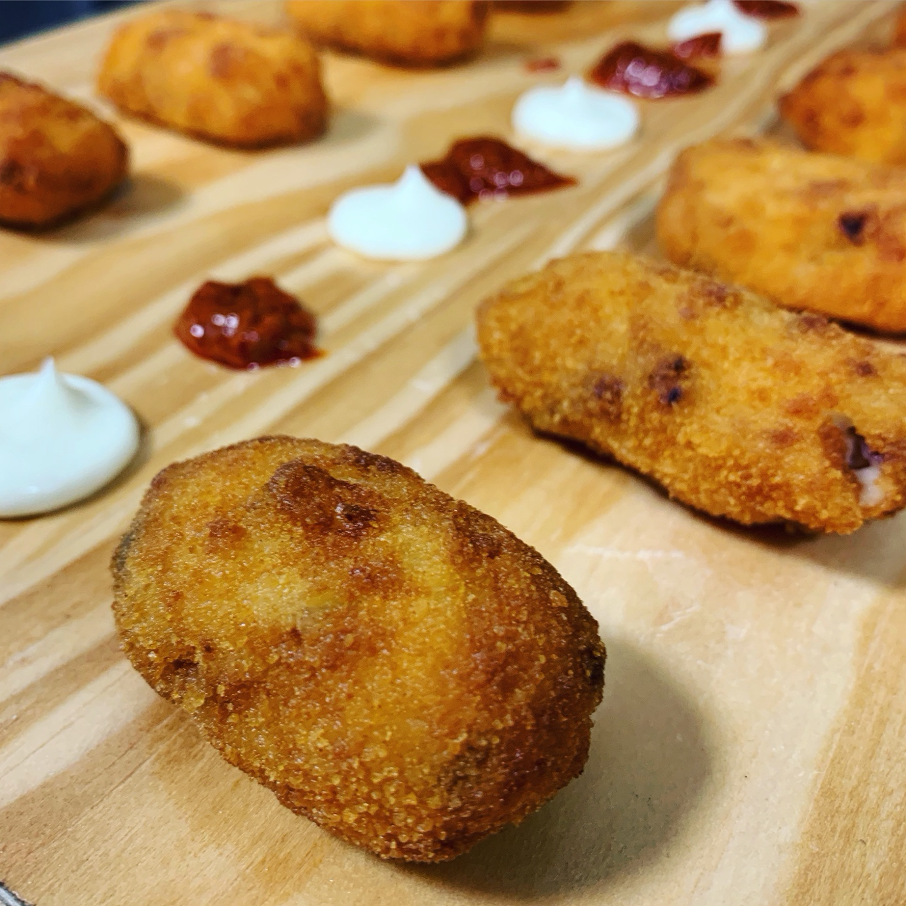
Spanische Tapas – Croquetas
Wir haben Croquetas auf zwei verschiedene Arten im Angebot. In unserem Catering-Service als Tapa und im eShop als Mischung zum Nachkochen für zu Hause.
Croquetas zuhause zubereiten
Allen voran wollen wir Ihnen die beliebten croquetas de jamón vorstellen: Sie werden gefüllt mit Ibérico oder Serrano Schinken, oft mit karamellisierten Zwiebeln und manchmal zusätzlich mit Käse. Wer die eigenen Lieblingszutaten hinzufügen möchte, kann dies gerne tun. In unserem Rezept können Sie alle Wunschzutaten gleich am Anfang zur Béchamel-Mischung zugeben.
Croquetas de Jamon – spanische Tapas – Zubereitung Schritt für Schritt
Rezept: Croquetas de Jamón – in wenigen Minuten zu knusprigen Croquetten!
Das Croquetas-Paket wird mit dem Béchamel-Mix und dem speziellen Paniermehl geliefert. Die Menge reicht für etwa 40-50 Croquetas.
Croquetas de Jamon – spanische Tapas – Zubereitung Schritt für Schritt
Rezept: Croquetas de Jamón – in wenigen Minuten zu knusprigen Croquetten!
Das Croquetas-Paket wird mit dem Béchamel-Mix und dem speziellen Paniermehl geliefert. Die Menge reicht für etwa 40-50 Croquetas.
Zutaten für Croquetas de Jamon:
Zubereitung der Croquetas de Jamon
- Die warme Milch in eine Schüssel geben. Die Mengen hängen davon ab, wie viele Croquetas Sie machen möchten. Die genauen Rezeptangaben werden selbstverständlich im Paket mitgeliefert.
- Die beiden Schinkenarten und Mozzarella zugeben.
- Béchamel Instant einrühren. Die Konsistenz wird sofort sehr cremig.
- Hühner-Bouillon in eine separate Schüssel füllen, erneut den Béchamel Mix einrühren. Es entsteht ein flüssiger Teig. Alternativ können Sie diesen Schritt, "Fidscharina" genannt, auslassen und die geformten Croquetas in einem geschlagenen Ei wenden.
- Nehmen Sie 20 Gramm des Teigs und formen Sie ihn zu einem Bällchen
- Danach in der Fidscharina oder im geschlagenen Ei und im Paniermehl wenden.
- Das Öl in der Pfanne heiss werden lassen, wir empfehlen eine schwere Bratpfanne, in die Sie etwa 3cm Sonnenblumenöl füllen.
- Bällchen goldbraun frittieren, auf Küchenpapier legen und sofort geniessen.
Über die Croquetas de Jamon von Santa Rita
Santa Rita ist ein spanischer Mehl-Hersteller, der sich neu erfunden hat und nun interessante Produkte wie die Croquetas-Fertigmischung anbietet. Wir importieren von dieser Firma die beliebten Päckchen. Im Paket enthalten sind der Béchamel-Mix, ein feines Rezept und die Paniermehlmischung. Kostenpunkt: CHF 11.90.-
Hier bestellen.
Hier bestellen.
Croquetas berühmter spanischer Köche: wenn spanische Tapas viral gehen
Mehlproduzent Santa Rita arbeitet auch mit berühmten spanischen Spitzenköchen zusammen, etwa mit Paco Roncero (er hat zwei Michelin-Sterne). Während der COVID-19-Quarantäne, genauer gesagt zum internationalen Croquetas-Tag, hat er seine persönliche Kreation auf Instagram geteilt – und die Spanier sind ausgeflippt!
Das Bild seiner vegetarischen Croquetas erzielte fast 3500 Likes. Damit wollte er alle Kochfans inspirieren, daheim zu kochen und neue Rezepte zu entdecken. Anscheinend ist ihm das auch gelungen!
Seine Croquetas-Variante: gekochte Eier und Kartoffeln.
Das Bild seiner vegetarischen Croquetas erzielte fast 3500 Likes. Damit wollte er alle Kochfans inspirieren, daheim zu kochen und neue Rezepte zu entdecken. Anscheinend ist ihm das auch gelungen!
Seine Croquetas-Variante: gekochte Eier und Kartoffeln.
Das Rezept: Croquetas de huevos rotos con patatas
Sie können Sie Kroketten auch ganz einfach von Grund auf in der heimischen Küche zubereiten und ihnen Ihre eigene Note verleihen – wie die spanischen Promi-Köche!
Zutaten: Zwiebel, Semmelbrösel, Öl, Mehl, Milch, Salz, Kartoffel, Butter und 2 gekochte Eier
Zubereitung:
- Für die Béchamel die Zwiebel zunächst mit etwas Butter in einem Topf bräunen, das Mehl hinzufügen und weiter rühren, bis es leicht gebräunt ist (nicht anbrennen lassen). Dann die Milch nach und nach hinzufügen und weiter rühren, bis die perfekte Konsistenz entsteht: nicht zu flüssig, nicht zu dick.
Zutaten: Zwiebel, Semmelbrösel, Öl, Mehl, Milch, Salz, Kartoffel, Butter und 2 gekochte Eier
Zubereitung:
- Für die Béchamel die Zwiebel zunächst mit etwas Butter in einem Topf bräunen, das Mehl hinzufügen und weiter rühren, bis es leicht gebräunt ist (nicht anbrennen lassen). Dann die Milch nach und nach hinzufügen und weiter rühren, bis die perfekte Konsistenz entsteht: nicht zu flüssig, nicht zu dick.
- Kartoffeln in Würfel schneiden und anbraten. Die gekochten Eier schälen und zerdrücken. Die gar gekochten Kartoffeln und Eier zur Béchamel geben. Mischen Sie alles gut. Formen Sie Kugeln à 20 Gramm.
- Croquetas im Ei und dann im Paniermehl wenden. Dann in ausreichend Öl braten.
Tipp: Falls Sie die Béchamel-Sauce nicht selbst machen möchten, können Sie auch für dieses Rezept die oben präsentierte Mischung verwenden.
Video direkt vom Spitzenkoch (spanisch):
https://www.instagram.com/tv/B_SLFpvIf8P/?utm_source=ig_embed
- Croquetas im Ei und dann im Paniermehl wenden. Dann in ausreichend Öl braten.
Tipp: Falls Sie die Béchamel-Sauce nicht selbst machen möchten, können Sie auch für dieses Rezept die oben präsentierte Mischung verwenden.
Video direkt vom Spitzenkoch (spanisch):
https://www.instagram.com/tv/B_SLFpvIf8P/?utm_source=ig_embed
Spanische Tapas Rezepte: Croquetas Tipps vom Profi
Diese Tipps verfeinern den Geschmack Ihrer Croquetten merklich:
Noch mehr Links zum Thema Croquetas:
Produkte hier erwerben (Gratisversand innerhalb von 48 Stunden). Express-Versand verfügbar.
- Wenn Sie mit der Fidscharina anstelle der gequirlten Eier kochen wollen: Verwenden Sie eine hochwertige, frische Bouillon, Instant-Gemüsebrühe aus Würfeln oder Konzentrat können geschmacklich zu stark sein.
- Sie können Croquetas vorbereiten. Wenn Sie sie paniert haben, können Sie sie mit Folie zudecken und bis zu einem Tag in den Kühlschrank stellen. Sie können die panierten Croquetas auch einfrieren. Wenn Sie sie zubereiten wollen, dann können Sie sie gefroren frittieren.
- Koch José Izarro nimmt reines Olivenöl anstelle von Sonnenblumenöl (oder einer Butter / Öl-Mischung. Zudem würzt er die Milch für die Béchamel mit etwas Schinkenbouillon.
- Hände vor dem Formen der Croquetas gut einmehlen, dann klebt es weniger.
Noch mehr Links zum Thema Croquetas:
- Video von ICEX (Spanish Institute for Foreign Trade): Croquetas mit Schinken und Kalbfleisch
Produkte hier erwerben (Gratisversand innerhalb von 48 Stunden). Express-Versand verfügbar.
Cliquer ici pour modifier.
Extra Virgin Olive Oil health benefits |
Olive oil is the best source of healthy nutrients.
|
What is EVOO, and how is it made?
EVOO stands for Extra Virgin Olive Oil, the oil extracted from Olives.
The Olives are crushed and processed in a centrifuge to extract oil from the pulp.
After the oil extraction, the remains of the spun paste produce Olive pomace oil, which is NOT Extra Virgin AOVE and it's obtained with the help of different chemical solvents.
The Olives are crushed and processed in a centrifuge to extract oil from the pulp.
After the oil extraction, the remains of the spun paste produce Olive pomace oil, which is NOT Extra Virgin AOVE and it's obtained with the help of different chemical solvents.
Olive oil is divided into three grades based on its quality: Extra Virgin Olive Oil, refined Olive oil, and Olive pomace oil.
Extra Virgin Olive Oil is the purest and healthiest oil. It is extracted by natural methods retaining all the nutrients and vitamins. Be mindful of these categories when you purchase any Olive oil.
You will find some of the highest quality olive oils in our shop like Palacio de los Olivos (picual), Vadolivo (picual, royal , hojiblanca varieties) and Molino Alfonso (arbequina) artisan producers in Spain.
Summary
Olive oil is an excellent diet-ingredient; it protects from various heart diseases, nourishes brain activity, reduces inflammation, improves skin and hair, and adds delicious taste in food.
Extra Virgin Olive Oil is the purest and healthiest oil. It is extracted by natural methods retaining all the nutrients and vitamins. Be mindful of these categories when you purchase any Olive oil.
You will find some of the highest quality olive oils in our shop like Palacio de los Olivos (picual), Vadolivo (picual, royal , hojiblanca varieties) and Molino Alfonso (arbequina) artisan producers in Spain.
Summary
Olive oil is an excellent diet-ingredient; it protects from various heart diseases, nourishes brain activity, reduces inflammation, improves skin and hair, and adds delicious taste in food.
Side Effects
Observational data shows that Olive oil may cause nausea in a minimal number of people, though there are no scientific shreds of evidence to back this claim.
Extra Virgin Olive Oil Benefits
When we have to choose between two options, we usually are compelled to choose the one with enormous benefits or lesser side effects. Extra Virgin Olive Oil has no harmful effects, and it is 100% healthy and beneficial.
Extra Virgin Olive Oil nutrition facts
Extra virgin olive oil is the healthiest and fairly nutritious oil.
One tablespoon of EVOO contains:
● 73% Monounsaturated fat
● 14% Saturated fat
● 13% Vitamin E
● 7% Vitamin K
The most crucial component of Extra Virgin Olive Oil is its antioxidant content. Free Radicals damage our cells and contribute to cancer and heart disease. Antioxidants prevent the damages of these free radicals.
The anti-inflammatory oleocanthal and oleuropein are prominent antioxidants in Extra Virgin Olive Oil. These antioxidants protect cholesterol from oxidation.
Some people criticize the omega-6 to omega-3 ratio in EVOO, which is 10:1. But this shouldn't be a concern as the total amount of polyunsaturated fats is still very low. Extra Virgin Olive Oil nutrition is not only beneficial but necessary for health. Health is one of the most precious blessings of God. EVOO promotes good health, and it must be a part of our regular diet.
One tablespoon of EVOO contains:
● 73% Monounsaturated fat
● 14% Saturated fat
● 13% Vitamin E
● 7% Vitamin K
The most crucial component of Extra Virgin Olive Oil is its antioxidant content. Free Radicals damage our cells and contribute to cancer and heart disease. Antioxidants prevent the damages of these free radicals.
The anti-inflammatory oleocanthal and oleuropein are prominent antioxidants in Extra Virgin Olive Oil. These antioxidants protect cholesterol from oxidation.
Some people criticize the omega-6 to omega-3 ratio in EVOO, which is 10:1. But this shouldn't be a concern as the total amount of polyunsaturated fats is still very low. Extra Virgin Olive Oil nutrition is not only beneficial but necessary for health. Health is one of the most precious blessings of God. EVOO promotes good health, and it must be a part of our regular diet.
Extra Virgin Olive Oil for weight loss
Obesity is the most common disease in the world. It is called the mother of diseases that causes various health problems. If you want to look smart and live healthily, refrain from being overweight.
Now there comes a need to address a misconception about obesity. Many people think that eating little can be the best remedy to tackle over-weight. Strictly speaking, it will not work!
The proper way to eliminate obesity is to maintain a healthy diet and to do regular exercise.
Extra Virgin Olive Oil, a Mediterranean wonder, is an excellent food ingredient that will reduce weight. Studies have confirmed that Extra Virgin Olive Oil restrains bad cholesterol from rising and keeps the heart-healthy.
The monounsaturated fatty acids in Extra Virgin Olive Oil are suitable for smooth food mobility in the intestine. It eases the bowel movement and promotes better metabolism. Proper digestion is paramount for weight loss Extra Virgin Olive Oil assists in raising levels of good cholesterol.
The monounsaturated fatty acids also resist cardiovascular disease and stable blood sugar levels.
Now there comes a need to address a misconception about obesity. Many people think that eating little can be the best remedy to tackle over-weight. Strictly speaking, it will not work!
The proper way to eliminate obesity is to maintain a healthy diet and to do regular exercise.
Extra Virgin Olive Oil, a Mediterranean wonder, is an excellent food ingredient that will reduce weight. Studies have confirmed that Extra Virgin Olive Oil restrains bad cholesterol from rising and keeps the heart-healthy.
The monounsaturated fatty acids in Extra Virgin Olive Oil are suitable for smooth food mobility in the intestine. It eases the bowel movement and promotes better metabolism. Proper digestion is paramount for weight loss Extra Virgin Olive Oil assists in raising levels of good cholesterol.
The monounsaturated fatty acids also resist cardiovascular disease and stable blood sugar levels.
Extra Virgin Olive Oil and Cooking
Cooking in Olive oil is one of the subjects that always follows a myth. The myth is, cooking in Olive oil is hazardous. The problem is not in the misconception, but in its full acceptance, even top chefs repeat the fallacy of not cooking in Extra Virgin Olive Oil.
There is little chemistry involved, and maybe it will make you miss your school days. Anyways, oils include fatty acids. These fatty acids are categorized as saturated, monounsaturated, and polyunsaturated. I know, this is not a chemistry class, but the fallacy has to be addressed with science.
Fatty acids are categorized based on the presence of double bonds. Monounsaturated fatty acids have one double bond, and polyunsaturated fatty acids have many double-bonds. Saturated fatty acids are not prone to damage because they don't have any double bonds.
So, these monounsaturated and polyunsaturated fatty acids are prone to oxidative damage. On the other hand, saturated fatty acids are stable.
This damage (technically the oxidative damage to double bonds) to unsaturated fatty acids creates trans-fats which are bad for health. These fats contain potentially harmful compounds and lousy taste.
It seems like the problem is real. Now here is the catch! Olive oil is likely to be damaged when it is heated above its smoke point. If you are keeping the temperature below the smoke point, you are in the safe zone. EVOO smoke point ranges between 190-220°C.
Cooking Olive oil on the stove is in the range of 120°C. Frying in the pan doesn't exceed the range of 160-180°C, and an oven raises the maximum temperature of EVOO to 180°C. There are little chances that you cook above 180°C.
Now answering the question, is cooking in Extra Virgin Olive Oil bad?
It is entirely safe cooking in Extra Virgin Olive Oil. There is a significant unlikelihood of exceeding the smoke point of EVOO in normal circumstances.
Fatty acids are categorized based on the presence of double bonds. Monounsaturated fatty acids have one double bond, and polyunsaturated fatty acids have many double-bonds. Saturated fatty acids are not prone to damage because they don't have any double bonds.
So, these monounsaturated and polyunsaturated fatty acids are prone to oxidative damage. On the other hand, saturated fatty acids are stable.
This damage (technically the oxidative damage to double bonds) to unsaturated fatty acids creates trans-fats which are bad for health. These fats contain potentially harmful compounds and lousy taste.
It seems like the problem is real. Now here is the catch! Olive oil is likely to be damaged when it is heated above its smoke point. If you are keeping the temperature below the smoke point, you are in the safe zone. EVOO smoke point ranges between 190-220°C.
Cooking Olive oil on the stove is in the range of 120°C. Frying in the pan doesn't exceed the range of 160-180°C, and an oven raises the maximum temperature of EVOO to 180°C. There are little chances that you cook above 180°C.
Now answering the question, is cooking in Extra Virgin Olive Oil bad?
It is entirely safe cooking in Extra Virgin Olive Oil. There is a significant unlikelihood of exceeding the smoke point of EVOO in normal circumstances.
Extra Virgin Olive Oil and Cardiovascular disease
Heart disease causes premature death, which is extensively prevalent in the world.
Observational studies for decades have shown that Mediterranean people have a lower mortality rate due to heart disease. Extra Virgin Olive Oil consumption is thought to be a significant factor behind this. It led to extensive research in Mediterranean countries, and now we have abundant evidence to support this claim. Olive oil is an excellent remedy against cardiovascular events.
Extra Virgin Olive Oil regulates blood pressure and prevents hardening of arteries, which are the common causes of heart problems. The compounds in extra virgin olive oil have the brilliant cardio-protective capability.
Blood clotting is another cause of heart problems. The compounds in Extra Virgin Olive Oil prevent blood clotting that leads to cardiovascular events.
But what is the best time to take Olive oil?
It is recommended to use Olive oil in the morning with lemon juice, if possible. The lemon juice will enhance taste experience and give a boost to the digestive system.
Observational studies for decades have shown that Mediterranean people have a lower mortality rate due to heart disease. Extra Virgin Olive Oil consumption is thought to be a significant factor behind this. It led to extensive research in Mediterranean countries, and now we have abundant evidence to support this claim. Olive oil is an excellent remedy against cardiovascular events.
Extra Virgin Olive Oil regulates blood pressure and prevents hardening of arteries, which are the common causes of heart problems. The compounds in extra virgin olive oil have the brilliant cardio-protective capability.
Blood clotting is another cause of heart problems. The compounds in Extra Virgin Olive Oil prevent blood clotting that leads to cardiovascular events.
But what is the best time to take Olive oil?
It is recommended to use Olive oil in the morning with lemon juice, if possible. The lemon juice will enhance taste experience and give a boost to the digestive system.
Extra Virgin Olive Oil and cancer
Cancer is one of the most severe diseases causing hundreds of thousands of deaths every year. Around 606,520 lives will be lost in the United States and 16.900 in Switzerland due to cancer in 2020.
Observational data shows that Extra Virgin Olive Oil can be cancer-resistant. Free radicals are believed to be the leading driver for cancer. The antioxidants in Extra Virgin Olive Oil reduce damages due to those free radicals.
The scientific data suggests fewer deaths due to cancer in regions where Olive oil consumption is high. With this enough evidence, it would be an excellent choice to use EVOO to prevent those diseases.
Observational data shows that Extra Virgin Olive Oil can be cancer-resistant. Free radicals are believed to be the leading driver for cancer. The antioxidants in Extra Virgin Olive Oil reduce damages due to those free radicals.
The scientific data suggests fewer deaths due to cancer in regions where Olive oil consumption is high. With this enough evidence, it would be an excellent choice to use EVOO to prevent those diseases.
Extra Virgin Olive Oil for hair
There is no second opinion in maintaining good health. But when it comes to looks and beauty, the zero-tolerance policy is established. Olive oil is one of the core substances used in the beauty products. There is a billion-euro industry built that sells olive oil beauty products.
Extra Virgin Olive Oil is a completely natural unrefined oil which does not contain chemical ingredients. The nutrients in Olive oil are excellent for hair:
● The Vitamin E in EVOO makes the hair stronger and healthier.
● Extra Virgin Olive Oil repairs damaged areas of hair. Apply it on your scalp and have a little massage to make sure that all the nutrients are absorbed.
● EVOO makes the hair look shiny and attractive.
● Extra Virgin Olive Oil prevents hair loss and acts as an excellent antidote.
If you suffer from irritation, itchiness, or wound, olive oil will treat all of those problems.
● The Vitamin E in EVOO makes the hair stronger and healthier.
● Extra Virgin Olive Oil repairs damaged areas of hair. Apply it on your scalp and have a little massage to make sure that all the nutrients are absorbed.
● EVOO makes the hair look shiny and attractive.
● Extra Virgin Olive Oil prevents hair loss and acts as an excellent antidote.
If you suffer from irritation, itchiness, or wound, olive oil will treat all of those problems.
Extra virgin olive oil benefits for skin
|
For centuries, Olive oil was used to avoid various kinds of skin irritations. Skin health is crucial for your beauty and look. Thanks to nature, which has blessed us with an excellent source of skin nourishment and a remedy for skin diseases. Olive oil can be referred to as the "beauty secret." Extra Virgin Olive Oil must be a part of your beauty products. The antioxidants and vitamins in EVOO act as an anti-inflammatory, anti-ageing, and antibacterial substances. |
Extra Virgin Olive Oil is an excellent moisturizer that keeps your skin hydrated. Apply it right after a bath, and enjoy smooth skin.
Extra Virgin Olive Oil and Brain Health
The wonders of this Mediterranean food will not cease to amaze you here. There are many more to come to your knowledge as the scientific research progresses.
Olive oil and especially Extra Virgin Olive Oil, is also claimed to be beneficial for brain functioning.
Recent studies showed that people consuming Olive oil have better visual memory and verbal fluency. This is something that is not common in people who rarely consume Olive oil. Experts claim that regular consumption of Olive oil prevents memory decline with age and enhances brain performance.
Alzheimer's is a disease in which the communication between neurons is affected, and the brain function disrupts. Extra Virgin Olive Oil works best in preventing Alzheimer's like brain diseases.
Olive oil consumption helps in thinking clearly and increases focus. It will make you perform the daily task efficiently and better memory performance.
Daily consumption
According to the FDA, consuming 1 and 1/2 tablespoons of Olive oil is enough for a day. Though it depends more on the type and quality of Olive oil, you are using. Extra Virgin Olive Oil has the highest concentration of antioxidants and Vitamins as compared to other olive oils.
Be mindful while purchasing Olive oil, and make sure you are buying it from trusted sellers in original quality. Check the label and the seal of the bottle because there is much fraud involved in the industry.
Our recommendation is not to exceed two tablespoons of Olive oil per day. You can add Olive oil in salads, or apply on slices of bread before use.
Why is Olive oil bad for you?
Olive oil is not bad for health if consumed in a balanced quantity. Fats affect health when they exceed a certain amount in the body. If you are taking two tablespoons of Olive oil regularly, it will protect you from various heart diseases and cancer, lower your wrong cholesterol level, and strengthen your immune system.
If you are cooking in Olive oil, it will be useful to maintain the cooking temperature below the smoke point. In the case of Olive oil, the smoke point lies between 190-220°C. Exceeding the temperature above the smoke point damages the double bonds in fatty acid, resulting in trans-fats harmful to health.
We conclude that Olive oil is entirely safe and excellently healthy. It is a best practice to add a balanced amount of Olive oil in your regular diet.
Olive oil and especially Extra Virgin Olive Oil, is also claimed to be beneficial for brain functioning.
Recent studies showed that people consuming Olive oil have better visual memory and verbal fluency. This is something that is not common in people who rarely consume Olive oil. Experts claim that regular consumption of Olive oil prevents memory decline with age and enhances brain performance.
Alzheimer's is a disease in which the communication between neurons is affected, and the brain function disrupts. Extra Virgin Olive Oil works best in preventing Alzheimer's like brain diseases.
Olive oil consumption helps in thinking clearly and increases focus. It will make you perform the daily task efficiently and better memory performance.
Daily consumption
According to the FDA, consuming 1 and 1/2 tablespoons of Olive oil is enough for a day. Though it depends more on the type and quality of Olive oil, you are using. Extra Virgin Olive Oil has the highest concentration of antioxidants and Vitamins as compared to other olive oils.
Be mindful while purchasing Olive oil, and make sure you are buying it from trusted sellers in original quality. Check the label and the seal of the bottle because there is much fraud involved in the industry.
Our recommendation is not to exceed two tablespoons of Olive oil per day. You can add Olive oil in salads, or apply on slices of bread before use.
Why is Olive oil bad for you?
Olive oil is not bad for health if consumed in a balanced quantity. Fats affect health when they exceed a certain amount in the body. If you are taking two tablespoons of Olive oil regularly, it will protect you from various heart diseases and cancer, lower your wrong cholesterol level, and strengthen your immune system.
If you are cooking in Olive oil, it will be useful to maintain the cooking temperature below the smoke point. In the case of Olive oil, the smoke point lies between 190-220°C. Exceeding the temperature above the smoke point damages the double bonds in fatty acid, resulting in trans-fats harmful to health.
We conclude that Olive oil is entirely safe and excellently healthy. It is a best practice to add a balanced amount of Olive oil in your regular diet.
Extra Virgin Olive Oil for Diabetes
|
Olive oil diminishes the damage caused by high blood sugar levels. The antioxidants present in Olive oil tackle diabetes and protect the body from their harmful effects. Recent research shows that Olive oil is a powerful remedy against diabetes. Adding one or two tablespoons of Olive oil in a daily diet can effectively control blood sugar levels and promote good health. |
Common types of EVOO
Extra Virgin Olive Oil or EVOO consumption is on the rise in many European countries due to its enormous health benefits.
Spain, Italy, and Greece are some of the largest producers and consumers of Olive oil. Spain alone has around 2,584,564 Hectares filled with almost 300 million olive trees planted throughout the land. That makes Spain one of the first and the largest producers and exporters of Olives.
Is there a difference between Olive oil produced in Spain, Greece, and Italy?
To cut a long story short, Yes, there are differences between Greek EVOO, Spanish EVOO, and Italian EVOO. These differences can be due to the difference in species of Olive plants and the soil properties of these regions.
The properties such as colour and flavour of Olive oil are different in Spain, Italy, or Greece even if they are produced from the same species of the Olive tree.
It is essential to know the difference in colour and taste so that you can identify the Origin of the Olive oil.
Spain, Italy, and Greece are some of the largest producers and consumers of Olive oil. Spain alone has around 2,584,564 Hectares filled with almost 300 million olive trees planted throughout the land. That makes Spain one of the first and the largest producers and exporters of Olives.
Is there a difference between Olive oil produced in Spain, Greece, and Italy?
To cut a long story short, Yes, there are differences between Greek EVOO, Spanish EVOO, and Italian EVOO. These differences can be due to the difference in species of Olive plants and the soil properties of these regions.
The properties such as colour and flavour of Olive oil are different in Spain, Italy, or Greece even if they are produced from the same species of the Olive tree.
It is essential to know the difference in colour and taste so that you can identify the Origin of the Olive oil.
Flavour
|
Spain, being the largest producer, has over 30 different varieties of Olives. Each kind of Olives produced in Spain has a distinct taste, fragrance, and colour. These colours range from intense green to dark gold. Commonly the Spanish Olive oil will add a fruity taste in your food.
Italian EVOO has a grassy taste with an herbal aroma. On the other hand, the Olive oil from Greece adds a slightly peppery taste in food with a grassy aroma. EVOO consumption in Greece is higher than in any region in the world. Colour |
|
Spanish EVOO has a golden yellowish colour, whereas Italian EVOO possesses dark green colour. The Olive oil produced in Greece is typically green.
All of these Olive oils are incredibly healthy and nutritious. You can enjoy these varieties of Olive oil to add a change in your taste and have multiple experiences while consuming an equal amount of healthy nutrients. |
Cycloartenol
Studies also suggest that Italian Extra Virgin Olive Oil has a higher concentration of cycloartenol as compared to the Spanish EVOO, which is a sterol that lowers levels of cholesterol and reduces acidity in the body. Greek Olive oil has the highest concentration of polyphenols than the other Olive oils.
Buy EVOO in the highest quality
We have incorporated some of the benefits of EVOO that will suffice our audience to have a good insight about Extra Virgin Olive Oil. After learning about significant health benefits backed by scientific evidence, you must be thinking about adding EVOO in your diet.
Imagine if you are in a supermarket and seeing bottles of EVOO from different brands, you may be wondering which one to be selected. Of course, you must choose the one with the highest quality and best taste.
Our concern is to educate you, don't buy low-quality Olive oil only to save some bucks. You always want the best car, the best phone and dresses, why not food? Especially when it concerns you and your family's health.
From whom should you buy Olive oil in Geneva or in Switzerland?
Our recommendation is, Olive oil should be purchased from trusted sellers who guarantee original quality Olive oil with all properties intact. Sellers like Coop, Globus, and Les Ibériques have an excellent reputation in the market for selling the best quality Olive oil. We got trust from our customers after selling them high-quality EVOO for many years.
Imagine if you are in a supermarket and seeing bottles of EVOO from different brands, you may be wondering which one to be selected. Of course, you must choose the one with the highest quality and best taste.
Our concern is to educate you, don't buy low-quality Olive oil only to save some bucks. You always want the best car, the best phone and dresses, why not food? Especially when it concerns you and your family's health.
From whom should you buy Olive oil in Geneva or in Switzerland?
Our recommendation is, Olive oil should be purchased from trusted sellers who guarantee original quality Olive oil with all properties intact. Sellers like Coop, Globus, and Les Ibériques have an excellent reputation in the market for selling the best quality Olive oil. We got trust from our customers after selling them high-quality EVOO for many years.
Conclusion
Olive oil includes many beneficial compounds and offers nutritional content, which means that it can only be one of the healthiest ingredients.
Always select Extra Virgin Olive Oil, and purchase the best quality oil that you can, for a full nutrient load.
This liquid gold will make a difference in your life by improving your health and preventing disease.
Always select Extra Virgin Olive Oil, and purchase the best quality oil that you can, for a full nutrient load.
This liquid gold will make a difference in your life by improving your health and preventing disease.
12 plats espagnols à goûter au moins une fois dans sa vie!
|
Plusieurs plats espagnols typiques sont à goûter absolument au moins une fois dans sa vie. Les différentes régions de l’Espagne ont donné naissance à des mets très variés dont la réputation a traversé les frontières. Voici quelques-uns de ces plats à connaître.
|
1. Les tapas : l’un des plats espagnols les plus connus
|
Les tapas sont servis à l’heure de l’apéritif. Il s’agit d’amuse-gueules qui peuvent être composés de divers ingrédients, selon vos goûts. Elles se mangent debout autour d’une table ou d’un bar au milieu des conversations. Parmi les ingrédients les plus souvent utilisés dans leur préparation, les olives marinées sont souvent présentes, tout comme les patatas bravas. Beaucoup de tapas sont aussi fourrées aux anchois. Sur notre site vous trouverez les prestigieux producteurs de la Mer Cantabrique, Agromar et Salanort lieu d'origine des meilleurs anchois du monde. Aussi producteurs de boquerones en vinagre, ce plat incontournable du Nord d'Espagne.
Les chorizos, les tomates, les charcuteries et les poivrons figurent aussi parmi les ingrédients les plus appréciés qui font le succès des tapas. |
2. La paella
La paella est l’un des mets espagnols les plus connus. Plusieurs variantes existent dans sa composition. Légumes, fruits de mer, poulet et lapin sont souvent inclus dans ce mets typique, tout comme l’escargot, dans sa forme traditionnelle, et le riz.
La fameuse paella de Valence est confectionnée à partir de riz bomba, de poulet, de lapin, ainsi que de haricots blancs et verts. On y ajoute aussi ail, tomates, huile d'olive extra vierge, sel et pimentón fumé.
La fameuse paella de Valence est confectionnée à partir de riz bomba, de poulet, de lapin, ainsi que de haricots blancs et verts. On y ajoute aussi ail, tomates, huile d'olive extra vierge, sel et pimentón fumé.
3. Le gazpacho
Le gazpacho est l’un des plats emblématiques de l’Espagne. Cette soupe froide à base de tomates et de différents légumes est parfaite pour l’été lorsqu’il fait chaud. Le gazpacho d’Andalousie est particulièrement réputé. Parmi ses ingrédients, en plus des tomates, mentionnons les poivrons, l'huile d'olive picual et l’ail. Cette soupe est excellente pour la santé puisque les légumes crus contiennent plus de vitamines que les légumes bouillis.
4. Le jambon ibérique pata negra
|
Le jambon ibérique, en espagnol jamón ibérico, est un jambon sec préparé à partir de porc nourri aux glands. Il est possible d’en trouver diverses variétés, qui ont leurs propres appellations. Parmi ces variétés, on rencontre le jambon pata negra. Des critères bien précis indiquent que le jambon mérite l’appellation ibérique. Le porc utilisé pour la préparation du plat est de couleur foncée, presque noire.
Le jambon ibérique est issu d’une longue préparation. Après l’abattage et le dépeçage du porc, vient l’étape de la salaison. Une fois que la viande est salée, elle est lavée à l’eau froide pour enlever le sel. |
5. Le cocido madrilène
Il existe diverses variétés de cocidos. Le cocido madrilène se démarque. Ce pot-au-feu composé de légumes et de diverses viandes et légumes, principalement de pois chiches, est préparé de diverses manières selon les régions. On y trouve souvent le chorizo et morcilla.
6. Les churros
|
Les churros sont des pâtisseries sous forme de pâte frite. Ils sont présents dans les fêtes et ils sont particulièrement appréciés au petit-déjeuner, accompagnés d’un chocolat chaud. Ils sont préparés à la maison ou vendus dans la rue. Les churros sont composés de farine de froment et d’huile d’olive et tournesol. |
7. Tortilla de patatas
|
La tortilla de patatas, ou omelette de patates, est, comme son nom le dit, une variété d’omelette épaisse garnie de pommes de terre. Cette omelette est souvent accompagnée d’oignons. Elle est parfois consommée à l’heure des tapas. Elle sert aussi d’accompagnement pour d’autres plats. La tortilla est servie dans les bars, avec quasiment tous les plats espagnols typiques. L’omelette est cuite dans l’huile d’olive qui donne ce goût très particulier.
|
8. Le gâteau de Saint-Jacques
|
La tarta de Santiago, ou gâteau de Saint-Jacques, est un gâteau aux amandes originaire de Santiago de Compostela, à Galicia, et représente l’un des desserts les plus appréciés d’Espagne. La tradition veut qu’on la recouvre de sucre en laissant apparaître la croix de Santiago. La tarta accompagne traditionnellement les pèlerins qui ont parcouru tout le chemin pour Saint-Jacques-de-Compostelle. La vraie tarta de Santiago est réputée pour être très moelleuse.
Les ingrédients principaux de la tarta sont le sucre, les œufs et les amandes en poudre. Elle ne contient pas de farine. Le citron et la cannelle lui donnent son goût particulier. On mentionne déjà ce dessert au seizième siècle. |
9. La fabada
|
La fabada est un plat typique de la principauté des Asturies. Elle est composée de charcuterie compango, de porc, de haricots blancs et de diverses épices. Le nom fabada est tiré de faba, un haricot qui constitue l’un des principaux ingrédients du mets espagnol. Ce plat est assez semblable au cassoulet français.
Nous utilisons des ingrédients d'haute qualité car cette recette n'est apparemment difficile à réaliser mais il est d'une importante considérable l'origine certifiée de ses chorizos, morcillas, pancetas mais surtout des haricots fabas, qui donnent un caractère crémeux et la densité typique de ce plat ancestral. Voir Faba Asturiana IGP pour plus d'informations. |
10. Pulpo a la gallega
Le poulpe à la galicienne est le plat emblématique de la Galice. Le poulpe est cuit à trois reprises dans une cocotte. Il est coupé en rondelles et on l’assaisonne de pimentón de la Vera. Il est servi avec des pommes de terre. Il est préférable qu’il soit servi dans un plat en bois pour respecter la tradition. Le poulpe fait partie de toutes les fêtes en Galice. Il est cuit entier dans des chaudrons en cuivre.
Ce mets est aussi fameux outre-Atlantique. En Argentine, le poulpe est servi lors des festivités de la Semaine Sainte. Dans certains villages espagnols, le poulpe à la Galicienne est désigné comme mets principal un dimanche par mois. Dans la province d’Orense, le mets est proposé dans la rue.
Lorsqu’il est cuit correctement, le poulpe ne perd pas sa peau lors de la cuisson. On le laisse alors reposer un quart d’heure avant de le servir.
Ce mets est aussi fameux outre-Atlantique. En Argentine, le poulpe est servi lors des festivités de la Semaine Sainte. Dans certains villages espagnols, le poulpe à la Galicienne est désigné comme mets principal un dimanche par mois. Dans la province d’Orense, le mets est proposé dans la rue.
Lorsqu’il est cuit correctement, le poulpe ne perd pas sa peau lors de la cuisson. On le laisse alors reposer un quart d’heure avant de le servir.
11. La crème catalane
|
La crema catalana, ou crème catalane, s’apparente à la crème brûlée. Elle est servie comme dessert, avec du citron et de la cannelle. On la sert aussi avec du sucre blanc brûlé. En Catalogne, la tradition voulait que ce mets soit consommé le 19 mars, soit le jour de la Saint-Joseph, qui annonce la venue du printemps. On l’utilise pour remplacer la crème pâtissière pour farcir les pâtisseries et les feuilletés.
|
12. Bacalao al pil pil
La morue pil pil est une spécialité du Pays Basque. Ce plat est réputé pour son jus de poisson, qui se présente comme une sauce gélatineuse qui lui donne son bon goût. Elle figure au menu de tous les restaurants du Pays Basque.
NOUVEAU PRODUITS: Croquetas Santa Rita, le kit recette instant pour faire vos croquetas à la maison
6/17/2020
Croquetas!
Schwer vorstellbar, dass spanische Kroketten nicht schmecken könnten.
Jetzt mit #cookspainathome Kroketten mit Schinken und Kalbfleisch.
Ganz einfach!
Qui ose dire qu'il ou elle n'aime pas les croquettes espagnoles ?
Il est maintenant temps de #cookspainathome avec ces croquettes au jambon et au bœuf.
Super facile!
KIT CROQUETAS INSTANT (link to product)
SANTA RITA (béchamel + panure)
Source: foodsandwinesfromspain.com
#croquetas #spanishshop #magasinespagnol #epicerieespagnole #spanische #spezialitaten #delikatesse #switzerland #versand #homedelivery #livraison #domicile #suisse #acheter #online #order
Schwer vorstellbar, dass spanische Kroketten nicht schmecken könnten.
Jetzt mit #cookspainathome Kroketten mit Schinken und Kalbfleisch.
Ganz einfach!
Qui ose dire qu'il ou elle n'aime pas les croquettes espagnoles ?
Il est maintenant temps de #cookspainathome avec ces croquettes au jambon et au bœuf.
Super facile!
KIT CROQUETAS INSTANT (link to product)
SANTA RITA (béchamel + panure)
Source: foodsandwinesfromspain.com
#croquetas #spanishshop #magasinespagnol #epicerieespagnole #spanische #spezialitaten #delikatesse #switzerland #versand #homedelivery #livraison #domicile #suisse #acheter #online #order
HUILE D'OLIVE ARBEQUINA 100% SELON MÉTHODE TRADITIONNELLE
DE LA PLUS HAUTE QUALITÉ.
DANS UNE CÉRAMIQUE ARTISANALE D'ANDALOUSIE
Une oeuvre d'art à offrir à vos proches
À la recherche de cadeaux distinctifs? Offrez le plaisir de la découverte en encourageant nos artisans espagnols.
Une histoire familiale passionnante, racontée par ses producteurs à Séville (anglais).
We produce a Premium EVOO of unparalleled quality because of the way we produce it.
Of 40 hectares of olive trees that make up our farm, a selection is made of those with better productivity, fruit quality and have the optimum ripeness, since not all olives reach it at the same time.
We collect the olive by milking (by hand) at dawn, when they are still partially green, to get an Extra Virgin Olive Oil of Premium quality. The olive does not touch the ground. This delicate treatment of the raw material helps to achieve an intensity of unique flavor and aroma. It is an ultra-early collection that can be from the end of September to October.
Regarding transport, from the collection until the oil is obtained, it takes only 6 hours.
To press the olive we use traditional cold milling through a traditional method such as capachos, which allows to carry out an artisan pressing with the sole intervention of human aid. This process together with the appropriate times, allows to preserve the organoleptic and physical chemical characteristics of the oil. 13-14 kg of olives are needed to produce a liter of oil.
Finally, packaging and labeling, like the rest of the manufacturing processes, are done manually in the farm itself. Excellence is only possible if there is control and dedication at all stages of production.
The result is La Matilla Extra Virgin Olive Oil, a luxury, unique and exclusive gastronomic product. And most importantly, a family project that stems from tradition and a centuries-old olive culture promoting and promoting sustainability.
Of 40 hectares of olive trees that make up our farm, a selection is made of those with better productivity, fruit quality and have the optimum ripeness, since not all olives reach it at the same time.
We collect the olive by milking (by hand) at dawn, when they are still partially green, to get an Extra Virgin Olive Oil of Premium quality. The olive does not touch the ground. This delicate treatment of the raw material helps to achieve an intensity of unique flavor and aroma. It is an ultra-early collection that can be from the end of September to October.
Regarding transport, from the collection until the oil is obtained, it takes only 6 hours.
To press the olive we use traditional cold milling through a traditional method such as capachos, which allows to carry out an artisan pressing with the sole intervention of human aid. This process together with the appropriate times, allows to preserve the organoleptic and physical chemical characteristics of the oil. 13-14 kg of olives are needed to produce a liter of oil.
Finally, packaging and labeling, like the rest of the manufacturing processes, are done manually in the farm itself. Excellence is only possible if there is control and dedication at all stages of production.
The result is La Matilla Extra Virgin Olive Oil, a luxury, unique and exclusive gastronomic product. And most importantly, a family project that stems from tradition and a centuries-old olive culture promoting and promoting sustainability.
PROPERTIES:
We recommend it to be enjoyed with desserts, salads, sauces, fish, seafood and hot chocolate. Try it always in low temperature to keep its properties.
- The oil is produced, pressed and bottled on our farm, for the ultimate freshness and flavour.
- The olives are collected by hand, at dawn and in September-October.
- It takes 6-7 kg of olives to make enough oil to fill one 50 cl bottle.
- From the moment the olive is harvested until the oil is obtained, it takes barely 6 hours, which guarantees a higher quality.
- The traditional grinding is done in cold and by straws as it was done in the past and in our family tradition for more than one hundred and fity years.
We recommend it to be enjoyed with desserts, salads, sauces, fish, seafood and hot chocolate. Try it always in low temperature to keep its properties.
PACKAGING
- Our Arbequina range is a 100% Andalusian product. The box and the closure are made in Ubrique, the porcelain bottle on the Rambla, the wooden plug in Cazalla and the label in Moron de la Frontera.
- Handmade bottle of porcelain stoneware, one of the best materials for the conservation of olive oil. The bottles have no leaks (zero porosity) and help to better preserve the bottled product by not transferring light, air or odors. In recent times more and more oil producers export their products to gourmet markets, and this is where porcelain stoneware becomes the most suitable material and packaging for a very high quality product.
- High quality label with gold stamping.
- Anti-drip cap with wooden cap and genuine leather closure.
- Presented in an ideal gift box. Made of thick microchannel cardboard, this gift box has luxury finishes, such as gold stamping of the logo.
| | To press the olive we use traditional cold milling through a traditional method such as capachos, which allows to carry out an artisan pressing with the sole intervention of human aid. This process together with the appropriate times, allows to preserve the organoleptic and physical chemical characteristics of the oil. 13-14 kg of olives are needed to produce a liter of oil. |
“ Les Ibériques sont nées de l’amour de deux pays, la Suisse et l’Espagne, et de l’envie de les faire mieux se connaître. ”
LA GASTRONOMIE ESPAGNOLE, UN TRÉSOR CACHÉ
En Suisse, la gastronomie espagnole est encore un trésor caché. Certes, tout le monde connaît le chorizo, mais il ne s’agit que d’une infime partie de la richesse culturelle et culinaire des régions espagnoles.
Les Ibériques sont nées de l’amour de deux pays, la Suisse et l’Espagne, et de l’envie de les faire mieux se connaître. A l’origine se trouve le plaisir de faire découvrir un bon vin à un ami, la joie de partager une tradition d’accueil et de bonne humeur, la fierté de présenter des produits artisanaux de qualité.
Plus que de simples importateurs, les entrepreneurs des Ibériques sont des créateurs de liens entre la Suisse et l’Espagne. De la rencontre du producteur local amoureux de sa terre au partage de ses produits en Suisse, les Ibériques ont tissé mille collaborations durables.
Pour en savoir plus, et découvrir la date de la prochaine dégustation, rendez-vous sur le site internet ou sur les réseaux sociaux!
La haute cuisine espagnole
La cuisine est une création artistique pour le plaisir des sens : voilà comment on conçoit la gastronomie en Espagne. Une offre culinaire cinq étoiles pour le goût, la présentation, les arômes, les textures, la couleur… Les recettes de restaurateurs comme Adrià, Arzak, Berasategui, Manzano, Ruscalleda, Santamaría, Subijana ou Roca ont placé l'Espagne au faîte de la haute cuisine internationale.
Les nouveaux restaurateurs espagnols sont de véritables artistes aux fourneaux, comme le prouve leur renommée à l'échelle internationale. Par exemple, le Celler de Can Roca des frères Roca, situé à Gérone, a été désigné meilleur restaurant du monde par le prestigieux magazine « Restaurant » en 2015 et 2013. Le même titre arboré par Ferran Adrià et son restaurant El Bulli pendant cinq ans. Mugaritz et Asador Etxebarri, au Pays Basque, figurent aussi sur cette liste des meilleurs restaurants, respectivement à la 7e et 3e place. D'autre part, 11 restaurants espagnols affichent la note maximale octroyée par le prestigieux Guide Michelin.Les œuvres de ces nouveaux artistes de la cuisine, qui sont de savants mélanges de cuisine méditerranéenne et de plats créatifs, se caractérisent par leur originalité et leur innovation. L'importance de la nouvelle cuisine dans la culture espagnole est telle que le cuisinier José Andrés s'est vu récompensé en 2010 par l'ordre espagnol des Arts et des Lettres.
Une renommée internationale
En Espagne, beaucoup de restaurants ont été récompensés pour leur qualité et leur créativité. C'est ainsi que 200 établissements espagnols possèdent aujourd'hui une ou plusieurs étoiles Michelin. 11 d'entre eux jouissent de la plus haute distinction : deux en Andalousie, un dans la région de Valence, un autre à Madrid, trois en Catalogne et quatre dans le Pays Basque.L’édition 2018 a attribué trois étoiles au restaurant Dani García, à Malaga, concrètement à l’hôtel Puente Romano. Aponiente, dirigé par le « chef de la mer » Ángel León, situé à Puerto de Santa María (Cadix, en Andalousie) arbore également trois étoiles. La mer est le thème principal des plats de ce cuisinier, également connu pour avoir introduit le plancton dans ses recettes.
Quique Dacosta est le restaurant de la région de Valence le plus récompensé. Sa cuisine se définit comme une avant-garde gastronomique puisant ses racines dans le terroir de Dénia (province d'Alicante). L'établissement porte le nom de son principal restaurateur.La ville de Madrid n'est pas en reste grâce à l'exceptionnelle créativité du restaurant DiverXo et de son chef principal, David Muñoz, détenteur de trois étoiles. Sa cuisine repose sur une fusion d'arômes, de saveurs et de textures de diverses provenances.En Catalogne, il faut connaître les restaurants Celler Can Roca, dans la province de Gérone, et Lasarte, et ABaC, à Barcelone. Dans le premier, situé dans la ville de Gérone, les frères Roca déploient toute leur créativité culinaire pour transmettre des émotions. C'est le chef Martín Berasategui qui est le propriétaire du Lasarte et c'est Paolo Casagrande qui est aux fourneaux. Son objectif, l'expérience d'un repas inoubliable. ABaC est l'autre restaurant trois étoiles de Barcelone. C'est le chef Jordi Cruz qui y officie, avec des propositions culinaires très avant-gardistes.Le Pays Basque propose quant à lui quatre endroits uniques pour profiter de la cuisine basque d'auteur : Akelarre et Arzak à Saint-Sébastien, Martín Berasategui à Lasarte (Guipuscoa), et Azurmendi à Larrabetzu (Biscaye). Le premier, qui est le restaurant de Pedro Subijana, propose une expérience gastronomique pour tous les sens, dans une salle à la vue spectaculaire. Le restaurant de José María Arzak fut le premier à remporter les trois étoiles Michelin en Espagne (en 1989). Martín Berasategui est pour sa part l'une des principales références de la cuisine basque moderne, tandis que le restaurant « Azurmendi », du chef Eneko Atxa, est le fruit d'une recherche constante du plaisir à travers la cuisine.Bien d'autres restaurants se sont déjà fait remarquer à l'échelle internationale.
Parmi eux, l'Atrio, à Cáceres ; le Maralba, à Almansa (Albacete) ; L’Escaleta, à Cocentaina, et le BonAmb, à Jávea-Xàbia (les deux à Alicante) ; le Dani García, à Marbella (Málaga) ; l'Annua, à San Vicente de la Barquera (Cantabrie) ; le Cenador de Amós, à Villaverde de Pontones (Cantabrie) ; le Casa Marcial, à Parres (Asturies) ; le Zaranda, sur l'île de Majorque ; l'Enoteca, le Moments, le Dos cielos et le Disfrutar, à Barcelone ; Les Cols, à Olot (à Gérone) ; El Portal, à Ezcaray (La Rioja), le M.B., sur l'île de Tenerife ; le Cabaña Buenavista, à El Palmar (Région de Murcie) et le Ramón Freixa, le Santceloni, La Terraza del Casino, El Club Allard, le DSTAgE ou le Coque à Madrid.
BLOG INDEX
Aperitivo vermouth
Paella valencienne
Artichauts confits
Arroz con chipirones
Dry aged beef
Gastronomie asturienne
Pata negra c'est quoi?
Croquettes / Croquetas
Huile d'olive extra vierge
12 plats espagnols
La haute gastronomie
Les Ibériques en Suisse
Aperitivo vermouth
Paella valencienne
Artichauts confits
Arroz con chipirones
Dry aged beef
Gastronomie asturienne
Pata negra c'est quoi?
Croquettes / Croquetas
Huile d'olive extra vierge
12 plats espagnols
La haute gastronomie
Les Ibériques en Suisse
Les Ibériques Suisse
Feed & Partners
Foodsandwinesfromspain.com
Thisistherealspain.com
Spain.info
#marcaespaña
#globalspain
#españaglobal
#spainfoodnation
#elpaismasricodelmundo
Des articles afin de mieux connaitre les produits ibériques, le terroir et l'actualité des Ibériques.
Salud!


